ROOM DARKENING VS BLACKOUT VS DIMOUT CURTAINS: WHAT’S THE DIFFERENCE?
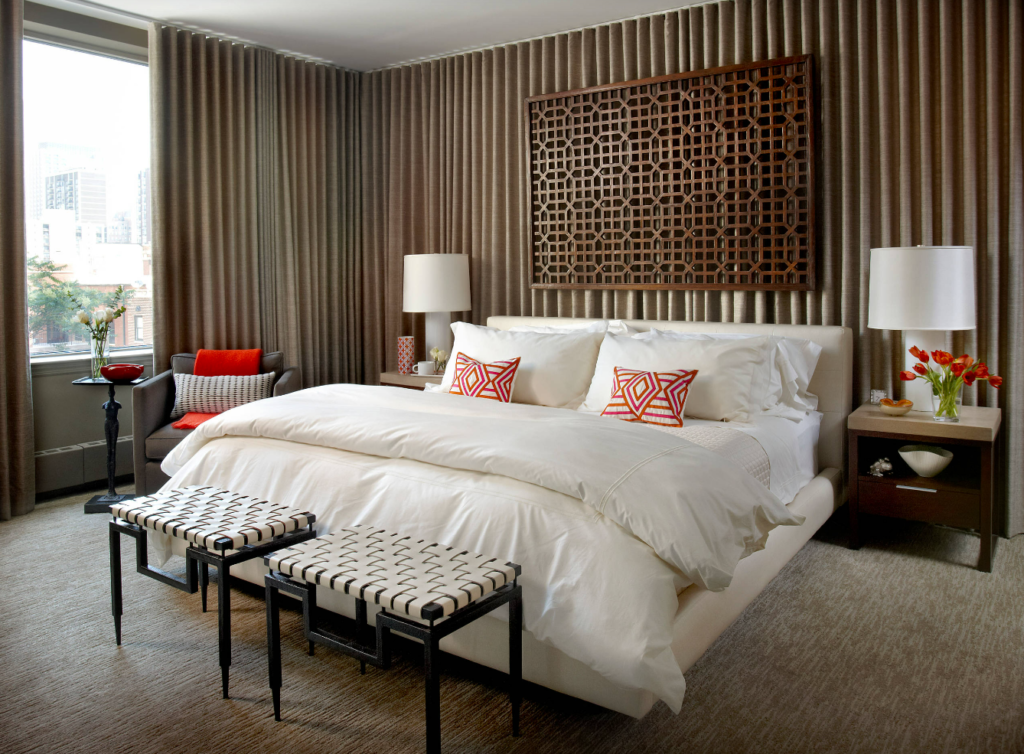
No matter how smitten you are by a cheery sunlit ambiance, at times you need a primitive cave. Like when you want to make the most of a movie night or a romantic candlelight dinner. Or when your little one is wide awake at naptime.
Certain rooms benefit from a moody dark setting such as your bedroom, media room, or nursery. Curtains prevent sunlight from entering these spaces, but there is more than one light-blocking option to choose from. In this blog post from our expert drapery stylists, explore the differences between various options so you can make the right choice for your needs.
‘Blackout curtains’, ‘room-darkening curtains’, and ‘dimout curtains’ are terms used interchangeably in the world of drapery, but they are not one and the same. Technically, ‘room darkening’ simply describes the function or benefit of the drapery fabric – while ‘blackout’ and ‘dimout’ are types of fabrics with varying degrees of light-blocking abilities.
However, the industry as well as clients increasingly refer to ‘dimout’ fabrics as ‘room darkening’ fabrics while reserving the term ‘blackout’ for the most effective light-blocking variety of drapery fabrics.
Before we distinguish them in further detail, let’s understand their similarities and the many tempting traits that make us their fans.
Order custom dimout and blackout curtains from Spiffy Spools online in any size. Pick from a wide variety of fabrics and patterns!
Benefits of Room Darkening Blackout & Dimout Curtains
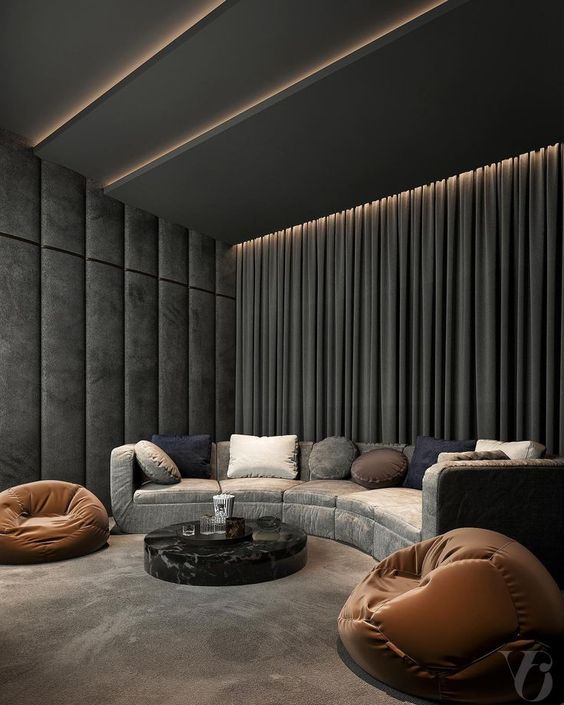
Blackout and dimout drapery fabrics are chemically treated fabrics that can combat light and heat very effectively. They are thicker (yet not bulky) than average drapery fabrics.
Today you can get both blackout and dimout curtains in a variety of colors ranging from snow white to jet black. And if you are pattern-obsessed, be assured that you will have no dearth of choice there as well.
While there are differences between room-darkening blackout and dimout curtains, they both share the following key benefits:
- BLOCK SUNLIGHT: The thick weave of the fabric and the specially coated back does not permit light from penetrating through. If the curtains make seamless contact with the walls from every side, light cannot enter at all.
- REDUCE EXTERNAL NOISES: Sound waves are deflected by these curtains and hence external noises can be curbed substantially. Internal sounds like those of creaking floors or humming appliances are muffled.
- PROVIDE PRIVACY: Since light cannot pass through these curtains, it is impossible to tell which room is lit and therefore occupied. Not a shadow appears on the curtains for outsiders to guess what’s happening beyond. If dressing your windows for privacy is the goal, there’s nothing better than these curtains.
- REGULATE TEMPERATURE: The curtains help in keeping your home warmer in winter by blocking the cold air from entering in, and the heat produced by the heaters from escaping. They help in keeping the room cooler in summer by blocking the hot air from entering in, and the cold air generated by your cooler from leaving the room. This way, they help to maintain the room temperature and may save you almost thirty percent on your power bills.
- IMPROVE SLEEP QUALITY: In a quiet, dark, and temperature-regulated ambiance, it is easier to fall into a deep sleep with minimum effort. Quality sleep in turn translates to good health, well-being, and higher productivity. If you are thinking of getting blackout curtains for nursery, this should be your biggest incentive since the dark room will help your baby sleep through the night, letting you catch some rest too!
While these positive traits are shared by the blackout and dimout drapes, the degree to which they perform is where they differ.
Blackout Curtains vs Dimout Curtains
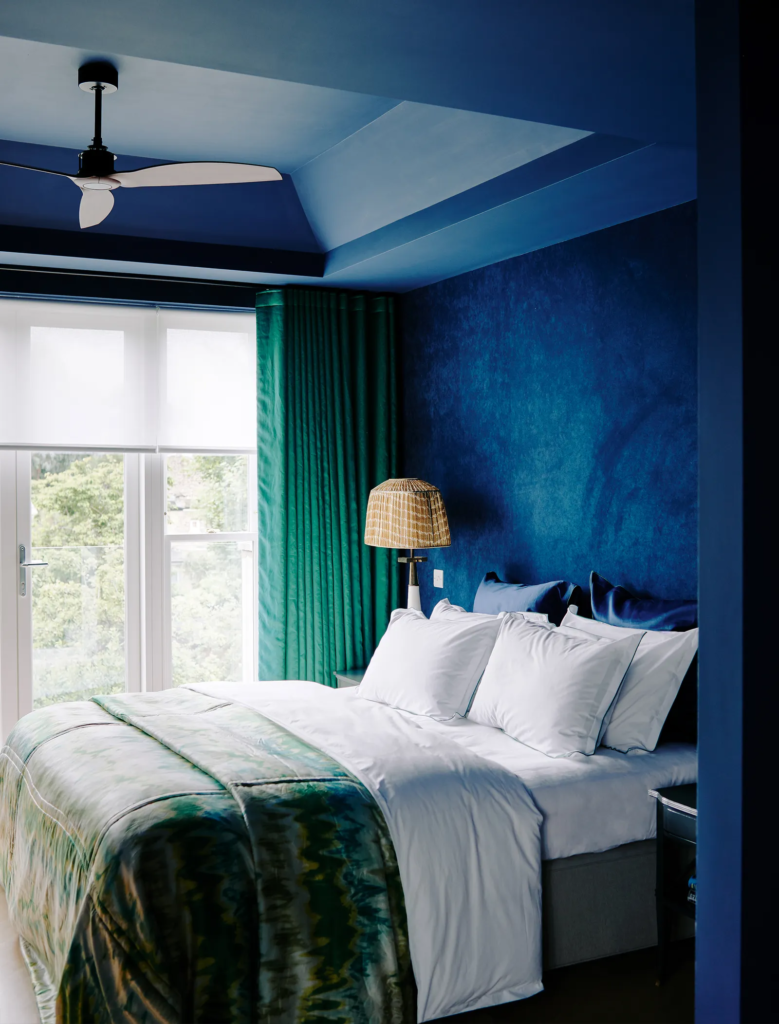
Blackout curtains block light almost entirely from entering the room. Dimout curtains resist light penetration to a substantial degree but do not make the room look ‘pitch dark’. So, the primary difference between dimout curtains and blackout curtains is the level of light that they block. And here are the details:
Blackout Curtains
Blackout curtains are typically designed to eliminate 95-100% light. They are made of two or three interwoven blackout layers on thick fabrics. The thick fabric, super-tight weave, and the foam backing together block light from penetrating.
Depending on the manufacturing process, blackout fabrics can have two or three layers of coatings. And they are accordingly classified at two pass or three pass fabrics.
Blackout fabrics created through the two-pass method have two layers of coating and typically appear black on the rear side.
Blackout fabrics produced by the three-pass method have three layers of coating, appear white (or any other light color) on the rear side, and block higher degree of light than two-pass method fabrics.
So, if your goal is to achieve close to complete darkness in your space, blackout curtains are the exact option you need. Check out the product description and also inspect first hand, if possible, whether the fabric fits your light control requirements.
Dimout Curtains
Dimout curtains usually block lower levels (anywhere from 70% to 90%) of light than blackout curtains. How much light will be blocked exactly will vary from fabric to fabric based on the thickness of the yarn, type of weave, color, and exact process of manufacturing.
Dimout fabrics are made through a combination of materials and processes that vary from manufacturer to manufacturer. While the details might vary, what is common is that a thick tight-woven fabric is coated with acrylic or foam-based compounds. Some also apply a PVC coating for additional light blockage.
Dimout curtains offer a balance between the total privacy of non-sheer curtains and the total darkness of blackout curtains. You can expect your room to appear significantly darker when the curtains are closed, but you may still see a light glow coming through the material.
If you’re looking to reduce the amount of light in a room but don’t want to eliminate it entirely, dimout curtains are a great choice. Dimouts let you enjoy the benefit of muffling external noises without having to go for pitch-black darkness, which is perfect if you are trying to get rid of distractions and improve study room homework productivity for your child.
Since light and heat are two expressions of the same energy, it is not surprising that the curtains can repel heat only to the extent that they resist light. Hence, it is right to conclude that blackout curtains are more energy efficient than dimout curtains and that 100% blackouts are the most efficient of all.
When shopping for blackout and dimout curtains, the only way to know one from the other is through the product description. Blackout fabrics are typically sold with the ‘100% blackout’ tag. Whereas, dimout fabrics are marked as ‘xx% blackout’. For example, a drapery fabric may be tagged as 70% blackout which means that it is a ‘dimout’ fabric that will block light to that extent. Do not be shy to ask for details of the product from the seller to be doubly sure of what you’re signing in for.
‘Blackout’ Curtains or ‘Dimout’ Curtains? How to Choose?
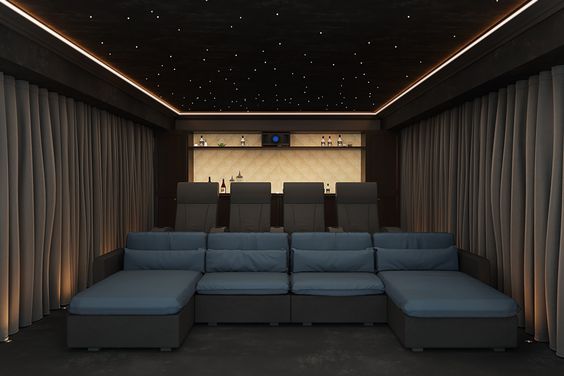
Before making your decision as to whether you should purchase blackout curtains or room-darkening dimout curtains, take the time to assess your needs. Depending on the purpose of the room and your lifestyle, one option may work better for your needs than the other.
Choose Blackout Curtains If:
- You enjoy total darkness as you sleep. Blackout curtains will block all light even as the sun starts rising, helping you to get longer, deeper sleep.
- You work night shifts. If you need to rest during the height of the day, you certainly don’t want any sunlight to be present in your room. Blackout curtains will prevent this from occurring while reducing external noises, allowing you to enjoy undisturbed sleep even during daytime.
- You have an infant or small child. Once the kids are tucked away in bed, you want to make sure they stay asleep! Blackout nursery curtains are a great way to create the ideal sleep environment for your little ones.
- You want to darken a media room. Have a home theater, game room, or other media room you want to keep dark? Blackout curtains are the perfect choice.
- You live in a camper RV. Blackout curtains provide maximum protection from the extreme weather conditions you might face during your travels. They also provide foolproof privacy which is very precious when your RV is parked on a busy street or left vacant until you return.
Choose Room Darkening Dimout Curtains If:
- Partial light adds to the function of the room. For instance, you may choose to hang room darkening curtains in your office to cancel the glare of your computer. Or, perhaps you have a man cave that would benefit from a darker aesthetic but could still use some minimal light to enjoy the space.
- A room in your home gets too warm. Some rooms get more direct sunlight than others. However, that doesn’t necessarily mean that you want that room to be completely dark. Room darkening curtains offer a happy medium by keeping your room cool while still allowing partial light to pass through.
- If pitch darkness is scary. Little children and nyctophobiacs might not love the idea of total darkness but may still want some efficient light blockage to catch a wink. Dimout curtains are just perfect to cater to their needs.
- You want to protect your furniture. Since the sun’s harmful rays are blocked to a high degree, your furniture and soft furnishings will be better protected from the wear and tear of strong sunlight.
READ MORE: HOME THEATER CURTAINS: IDEAS & TIPS
Enhance Functionality with Blackout Lining
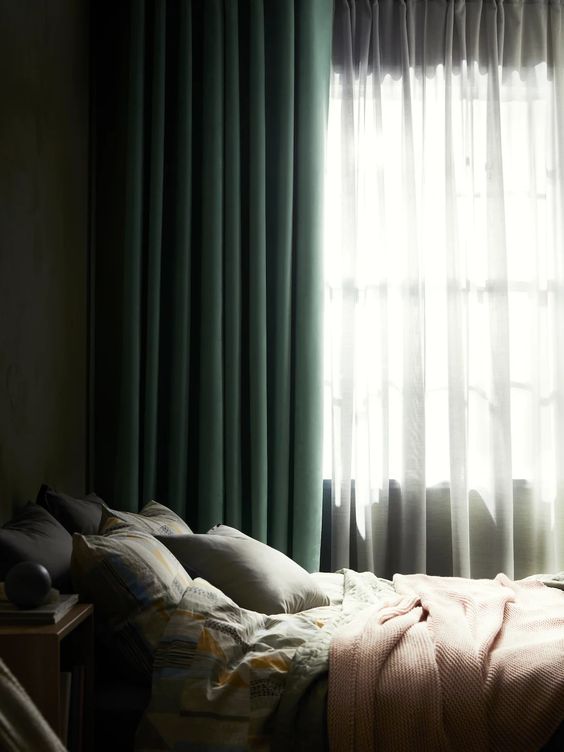
Blackout drapes do not always have to be constructed from blackout fabrics on the front as the main face fabric. You can choose a standard, non-blackout drapery fabric and order a blackout lining behind the face fabric to enjoy the same benefits as blackout fabric drapes. The blackout lining can solve several problems and be used in multiple ways, such as –
Instead of Blackout Drapery Fabric: This is a great idea if you failed to find a blackout drapery that exactly fits your design style or color palette. The possibility to line your drapery with blackout fabric expands the styling options exponentially.
Behind a Blackout Drapery Fabric: You can get your curtains stitched of a blackout drapery fabric backed by a blackout lining. Together, they create a more energy-efficient window dressing that enhances the insulation of your home, offering a perfect solution for those dealing with very harsh weather around the year.
Behind a Dimout Drapery Fabric: Another clever way to use blackout lining is behind the dimout drapery. If you’ve fallen for a dimout fabric but actually need a blackout drapery, you can order a blackout lining. Get the desired looks without sacrificing functionality!
So, if you found the blackout lining to be a godsend like we do, it’s time to learn about the ways to optimize their benefits.
Tips to Make the Most of Your Blackout Lining
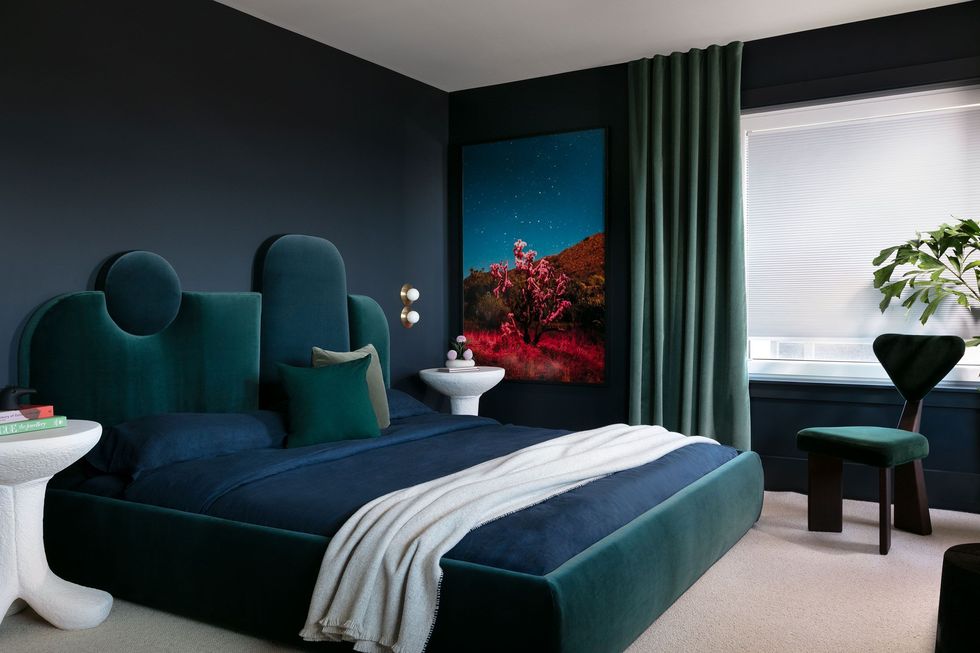
If achieving a high degree of darkness is a key priority, please keep the following in mind when you select the drapery fabric:
- PICK TIGHT WEVE, MAIN FACE FABRIC: Thick, densely woven fabrics are able to offer additional ‘support’ to the lining in the back. Therefore, the same blackout lining may ‘seem’ to be more effective when used behind main fabrics with thick, tight weaves like velvets and heavier cottons, as compared to when sewn behind a loosely woven linen fabric.
- NO SHEERS: Avoid lining sheer curtains because it defeats the purpose of both fabrics. Neither can the sheers let in abundant light and air, nor does the blackout lining block light effectively without support from the face fabric.
- PALETTE: Similarly, a darker front fabric will add to the lining’s effectiveness. Light fabrics will naturally reflect more light while darker ones will absorb and block.
Spiffy Spools’ blackout linings are available in gray and beige colors. Our linings are stitched with the drapery panels; they are not detachable or available separately.
The goal of complete light control is not achieved by merely selecting the right drapery fabric and/or lining. It goes beyond. In order to cancel light from breaking in at the seams, you need to follow some more steps.
Tips to Make the Most of Your Blackout/Dimout Drapes
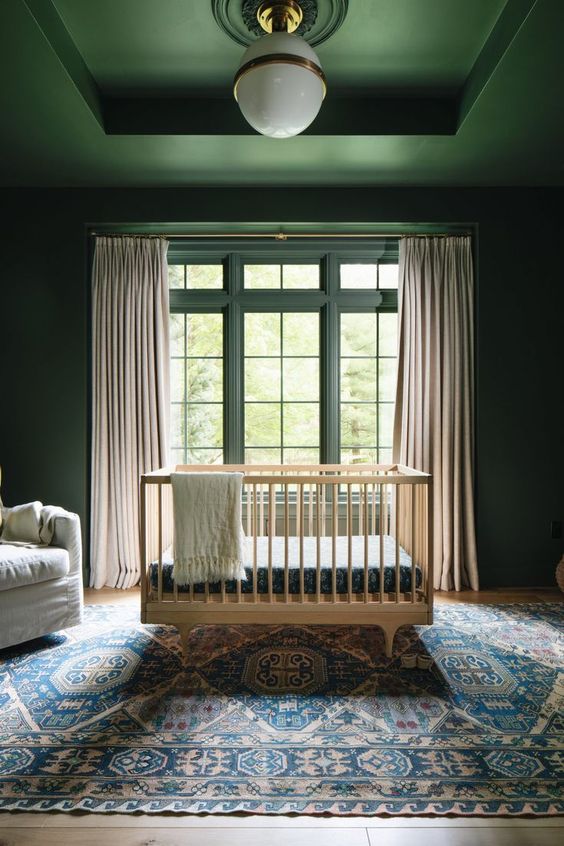
Whether you create blackout drapery with blackout/dimout fabric or blackout lining or their combination, these tips will help you cancel light leaks –
- VALANCE: If your decor style permits it, consider adding a board-mounted valance or a wooden pelmet above the window so that light cannot penetrate from above the curtains.
- HEADING STYLE: Opt for a heading style that features no holes and gaps through which light can pass like pinch pleats, rod pockets, or back tabs.
- CLOSE SIDE GAPS: Install return rods so that the curtain will make seamless contact with the wall on the sides. Or, if you have straight poles, use the hook and eye method to close the gap on the sides between the curtains and the wall.
- SCALE AND MEASURE RIGHT: Design the curtains to overlap the window trim by at least 6 inches on all sides of the window. If the situation permits, go for floor-length drapes as some light leakage is inevitable from the bottom with short curtains. If the scale of the window calls for it, go for floor-to-ceiling drapes for maximum light-blocking.
SHOP NOW: CUSTOM WINDOW VALANCES FROM SPIFFY SPOOLS
INSPIRATION CORNER
The tour is never quite complete without a few picturesque clicks along the way. And so we are going to give you a peek into our collection for some visual inspiration. Our collection of blackout and dimout fabrics has been curated keeping a wide variety of decor styles in mind so that all find one after their heart.
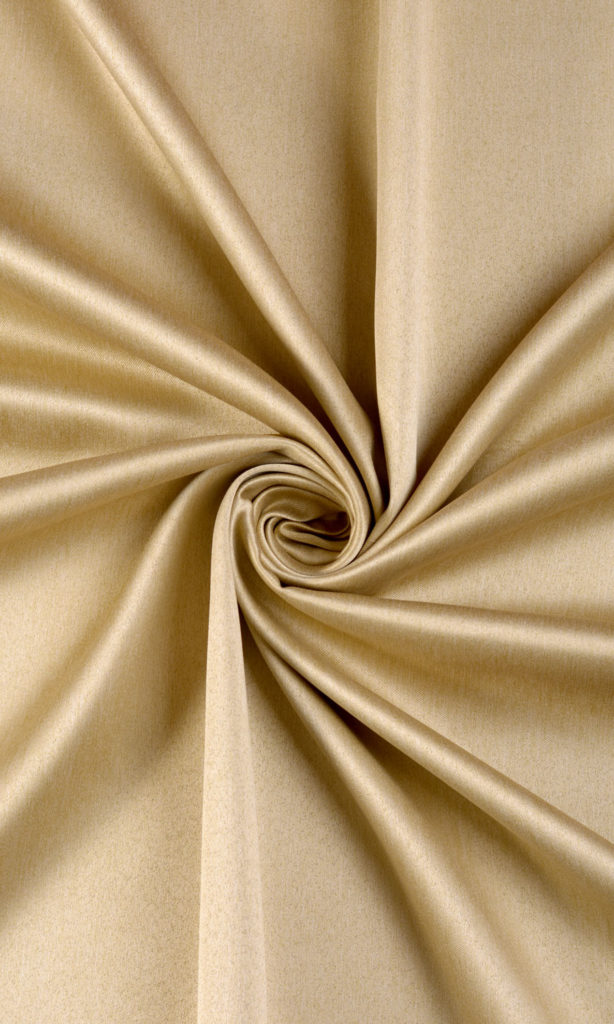
Did you ever imagine that a drapery that blocks sunlight totally could be designed in such a glossy hue? The sheen of Golden Sand bounces light around accentuating the brightness of a sunny day when you do want light in the room. With a gentle sheen of lovely gold, these drapes add style with function.
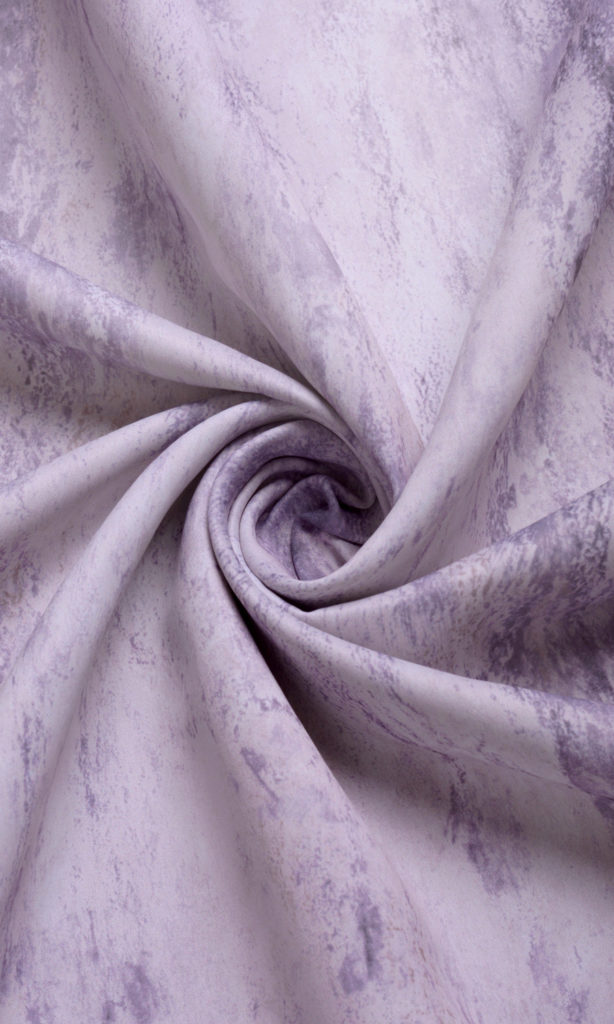
If you’re looking for a pop of color in a modern print, why not try these drapes depicting a melange of various shades of purple in a stunning watercolor effect? The abstract prints and lovely hues of Peeping Pearl are calming – just the perfect pick for a tastefully designed bedroom that needs to block light out completely for a sweet slumber.
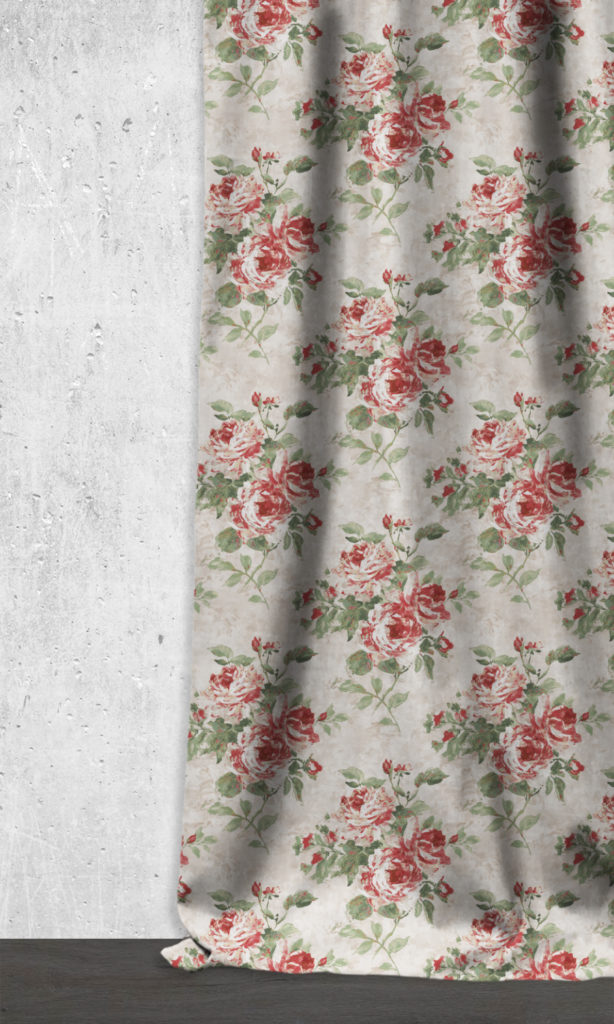
For a sun-exposed room that needs effective light and heat control, consider these 60% blackout drapes. Designed in a beautiful neutral backdrop with a soft oversized floral print, Cedros is a lovely touch of sophistication you can give to any room. Or, design your baby girl’s room with these if you’re looking for a motif that she’ll most likely never outgrow.
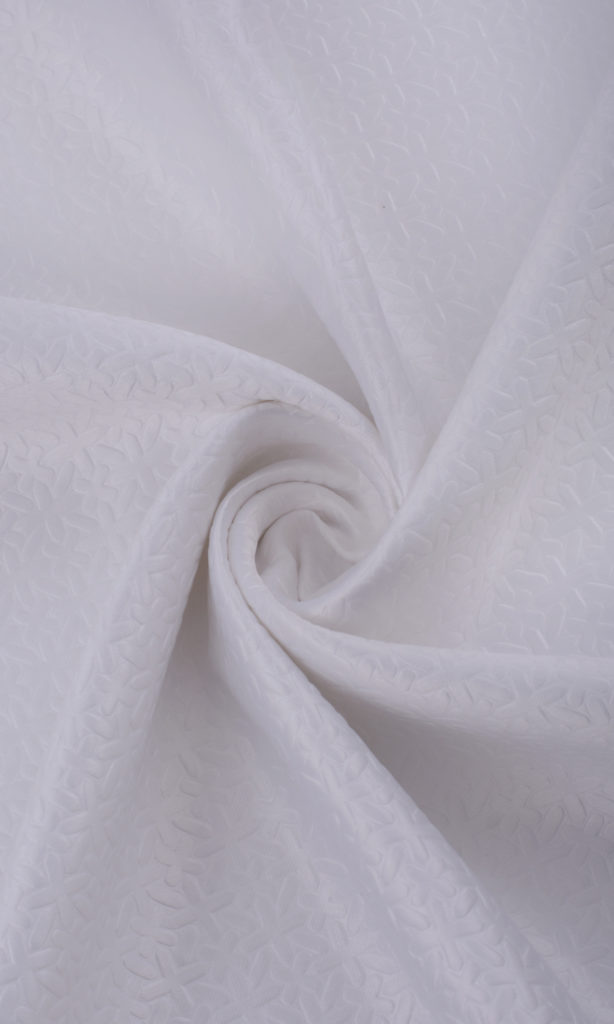
In case you’re wondering whether you can stick with your obsession with white even as you order light-blocking drapes, this drapery fabric should bust all your myths. Indeed, Bialy sports a spotless white and can still block light substantially. Back it with a blackout lining if you want to kill the light totally.
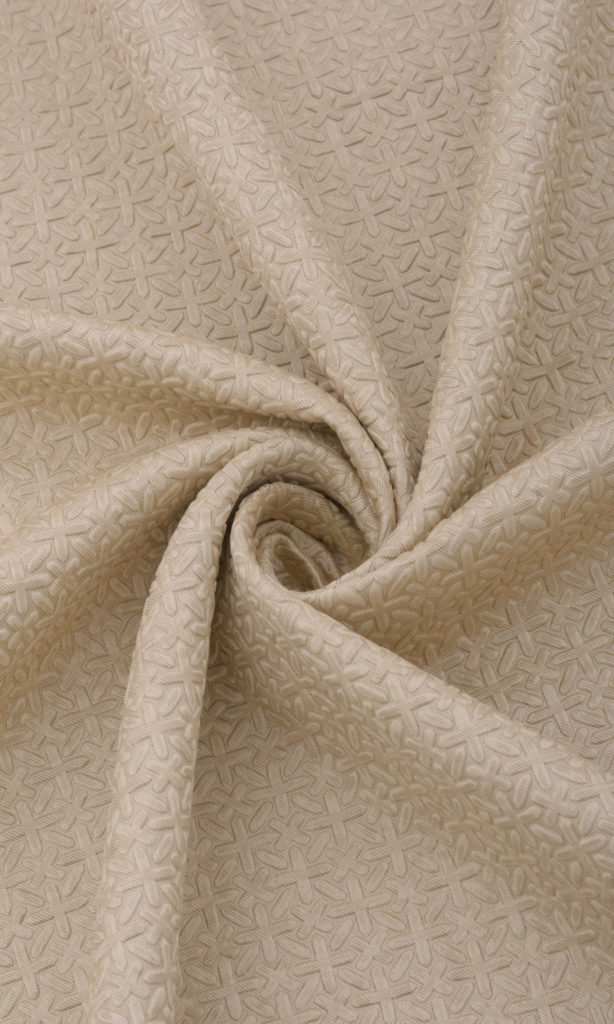
If it’s a chic textured fabric that captures your interest and relays your style evidently, Starbunch may pique your heart. With a marvelous array of embossed stars, this beige drapery is a stunner with understated elegance.
Order Custom Curtains from Spiffy Spools
Does window shopping excite you to get into the actual shopping mode? Jump right in, especially since you now know well the difference between room-darkening dimout curtains and blackout curtains. But if you still have questions, we are just a call away. Whether it’s blackout curtains for a camper RV to make it more private or a media room or bedroom that you want to amp up with the right ambiance, shop blackout and dimout drapes from Spiffy Spools today!
READ MORE: BEST BLACKOUT CURTAINS FOR BEDROOM: TOP IDEAS & TIPS
Simple Hacks For Creating More Sustainable Interior Design Solutions

As a society, we are all becoming more conscious of living sustainably and our environmental impact. This ethos can also be extended to interior design solutions that benefit the planet and are suitable for your pocket too! Expert Vikki Gerrard says creating eco-friendly interiors isn’t just about replacing wallpaper with reclaimed wood – Vikki Gerrard continues with there are plenty of simple hacks that you can use to reduce your environmental footprint and create sustainable decor and enjoy a beautiful and comfortable home. This post will share some great tips on creating sustainable interior design solutions without sacrificing aesthetics or comfort.
Order custom window treatments made of natural fibers from Spiffy Spools online in any size. We carry over 3,000 fabrics and patterns to pick from, so you can dress your windows exactly to your liking while still being in touch with the better side of the earth!
Choose Natural Materials Such As Wood, Stone, And Bamboo For Durable And Eco-Friendly Furniture
When it comes to furnishing your home, you want pieces that look great and want them to last for years to come. That’s where eco-friendly materials like wood, stone, and bamboo come in. These materials not only provide durability but are also incredibly sustainable. By choosing furniture made from these materials, you can feel good knowing that you’re making a conscious effort towards sustainability while creating a warm and inviting atmosphere in your home. Not to mention, the unique textures and patterns that natural materials provide are sure to add character to any space. So, why settle for bland and synthetic pieces when you can go all natural?
SHOP NOW: LINEN AND COTTON CURTAINS FROM SPIFFY SPOOLS
Incorporate Low-Energy Led Lights For Lighting Up The Room
Good lighting can make all the difference in a room. Whether for reading, relaxing, or entertaining, the right kind of illumination sets the mood and creates a comfortable ambiance. But keeping your home lit up all day can add to a hefty energy bill. That’s where low-energy LED lights come in. They are more cost-effective and last longer than traditional bulbs, meaning you won’t have to switch them out as often. Plus, they come in various hues and intensities so that you can create the perfect lighting for any occasion. Switching to LED lights may be a small change, but it can significantly impact your home’s energy usage and your wallet. Additionally, LED lights also do not emit heat energy like incandescent bulbs, reducing the temperature of your home in hot summer months, further helping you with energy bills that skyrocket with the use of coolers.
Install Sustainable Floorings, Such As Cork Or Recycled Rubber Tiles
Are you looking to revamp your space with a sustainable touch? Imagine stepping onto your brand-new floor, with each step supporting the environment.
Miami interior designers say sustainable flooring is becoming an increasingly popular choice amongst environmentally conscious homeowners. With options such as cork and recycled rubber tiles, it has never been easier to incorporate eco-friendly materials into your home. These materials not only look great, but they also have the added benefit of being durable, low maintenance, and sound-absorbing. By making the switch to sustainable flooring, not only will you be doing your part for the environment, but you’ll also be creating a stylish and comfortable living space that you can enjoy for years to come.
Invest In Energy-Efficient Appliances To Reduce Energy Consumption
Vikki Gerrard from La Crosse, WI, says investing in energy-efficient appliances is a smart choice for anyone looking to reduce their energy consumption. Not only does it save money on monthly bills, but it also helps to reduce the carbon footprint we leave on the planet. Even the real estate agent helping you market your property in the future may find an energy-efficient house to be an easier sell. Energy-efficient appliances come in various options, from refrigerators to washing machines and everything in between. These appliances are designed with the latest technology that conserves energy, making them a top choice for anyone looking to save money in the long run. So, don’t hesitate to upgrade your appliances and start experiencing the many benefits of energy efficiency. Reducing energy consumption doesn’t have to be a hassle anymore!
Utilize Green Cleaning Products To Ensure Your Home Is Free Of Toxins
In today’s world, ensuring our homes are clean and healthy is more important than ever. One way to achieve this is by utilizing green cleaning products. Unlike traditional cleaning products, which often contain harsh chemicals that can harm us and the environment, green cleaning products are made from natural, non-toxic ingredients. By using these products, not only will you be helping to protect your family from harmful toxins, but you’ll also be doing your part to reduce your carbon footprint. So, next time you’re in the market for cleaning supplies, consider switching to green products. Your home and the planet will thank you!
Reuse Items And Fabrics To Create Unique, Personalized Pieces For Your Home Décor
Creating personalized pieces for your home décor can be both fun and rewarding. Instead of buying new items, try reusing items and fabrics you already have on hand to create unique and unique designs. Not only does this method save money, but it also promotes a sustainable lifestyle by reducing waste. You can repurpose an old favorite blanket into a decorative pillow or use scraps of different fabrics to make a patchwork table runner. The endless possibilities allow you to show off your creativity and style in your home. So, why not start exploring your belongings and see what unique pieces you can come up with?
Conclusion
Creating a green and sustainable home is achievable with a little effort and planning. Natural materials such as wood, stone, and bamboo are great options for furniture that will last for years to come while providing a more eco-friendly footprint. Low-energy LED lights add just enough brightness to your rooms without needing too much power. Sustainable flooring adds beauty and another layer of efficiency to your home. Energy-efficient appliances can help significantly reduce energy consumption. Green cleaning products help keep your living space free of toxins. And utilizing recycled items and fabrics in unique ways allows you to personalize your home décor with an environmentally conscious flair.
Opting for environmentally conscious materials not only benefits the planet but can also enhance your property’s resale value. In today’s real estate market, there is a growing preference for sustainable homes, making eco-friendly home upgrades an investment with high returns that positively impact your home’s resale value.
With all these strategies in place, you can rest easy knowing that you’re doing your part to create a healthier environment and make the earth a better place for all of us!
READ MORE: 5 AMAZING WAYS TO START DECLUTTERING YOUR HOME
CURTAINS FOR CAMPER RV WINDOWS: IDEAS & TIPS
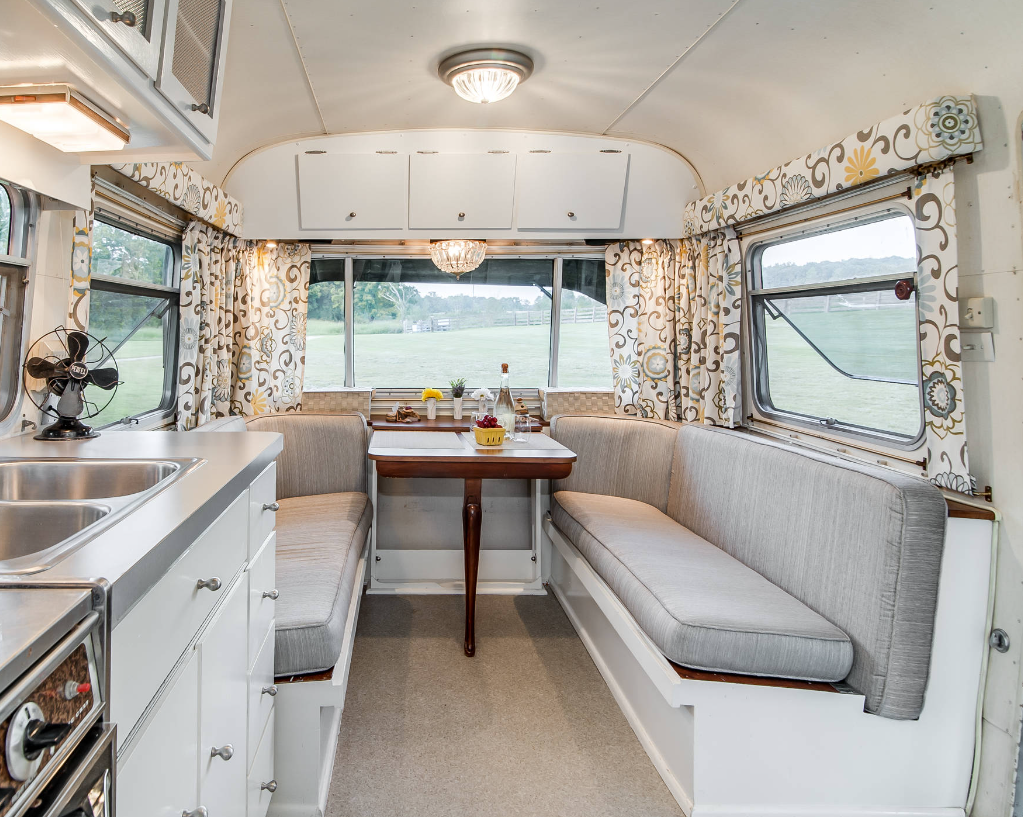
Gone are the days when making your career, living your life, and traveling places had to happen in that order. In this age of high-speed internet, travel vlogging, and work-from-home jobs, all can happen at the same time. Camper RVs are helping intrepid explorers live their dream of chasing rainbows and butterflies from horizon to horizon. But, there are challenges to deal with – such as uncouth weather, curious neighbors, and peeking strangers. If you find these woes relatable and are seeking guidance for installing curtains for your camper RV windows, you’ve ‘parked’ at the right spot.
Order custom curtains and drapes from Spiffy Spools online in any size. We carry over 3,000 fabrics and patterns to pick from, so you can dress your camper RV windows exactly to your liking!
Goals and Challenges with Dressing Camper RV Windows
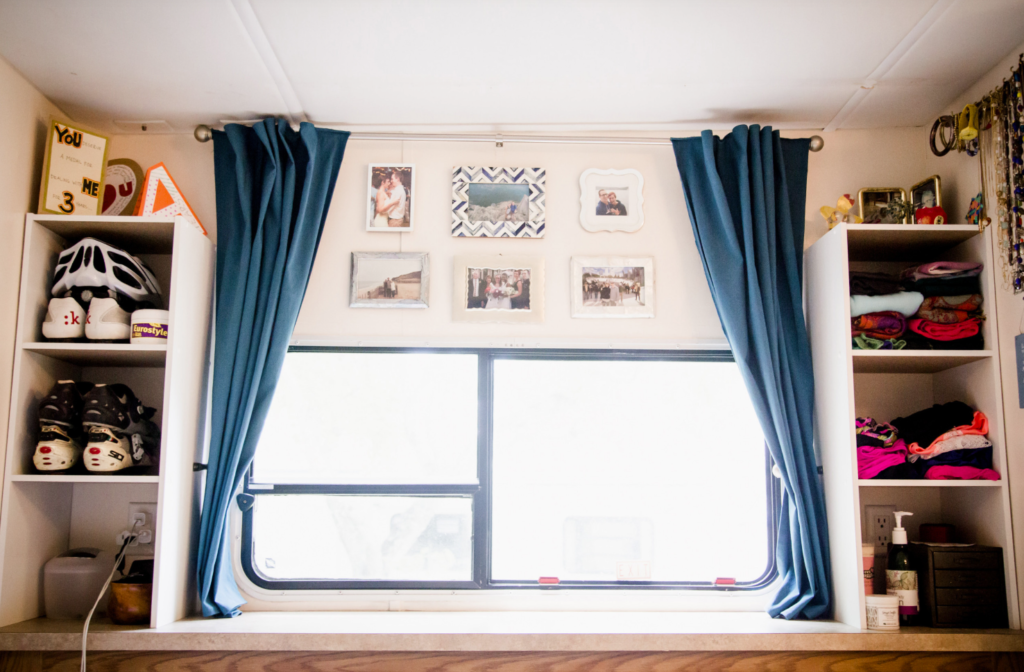
Most camper RVs come equipped with tinted glasses and blinds, but while these fulfill the function of providing privacy and light control, their efficiency might not be reaching your expectations. And, their visual appeal may not rhyme with your personal aesthetic vision. Adding new curtains that perfectly suit your interiors and meet your specific functional requirements is a fantastic way to upgrade and personalize your RV camper.
When shopping curtains for your RV camper, remember the functions they have to execute and the challenges they may present:
Foolproof Privacy
Often, you’ll have to park your RV in a bustling street or public zone where curious peekers might compromise your RV security and privacy. And sometimes, these peeping toms might turn out to be thieves scouting their next location. To ensure foolproof privacy you need curtains that don’t let even a shadow out so that no one can know whether it’s occupied or vacant when parked.
Effective Light Control
Sometimes, a catnap is just what a traveler needs to refresh after a long ride to take on the second leg of the trip with more energy. And it’s so hard to nod off if you’re light-sensitive. The situation is not very different at night as the dappled shadows cast by the streetlights won’t let you catch a wink. So, the solution is to install blackout RV camper curtains that can darken the room. And you can have your deep slumber no matter what time of day and what season of the year.
Efficient Insulation
The journey from torrid heat to frosty winters is part of the thrill of a globe-trotting lifestyle. But it’s not all that rosy when it starts taking a toll on your well-being. Those glazed windows are quick to lose thermal energy in winter, and let heat in during searing summer. The curtains can make up by reversing the scene so that the batteries will not drain out while running your heating/cooling systems.
Acoustic Efficiency
Often, camper vans are parked in a designated spot where several others are parked close by. You might achieve visual privacy easily, but it is never complete without optimal acoustics. You neither want your usual exchanges to be heard outside nor the external noise to disturb your curriculum. Insulative window curtains can fulfill this agenda to the highest possible degree.
Protection from Sun Damage
When the windows are open, the upholstery, wooden furnishings, and electric gadgets are instantly exposed to strong sunlight. It increases their chance to warp, fade and weather prematurely. Your RV camper curtains should help screen the RV’s interiors from harmful UV rays and the sweltering heat.
Aesthetic Pleasance
Blinds make your RV look like an ‘RV’ but curtains can make it look like a ‘home’. And that’s a big difference! Most RV owners either replace the manufacturer’s blinds or layer them with custom curtains for this very reason. That curtains can be designed in any color and pattern to fit your design style is of prime importance. Your camper van / RV – even if a small space – deserves every bit of dressing because it’s your home. To make living here a pleasant experience, every element must be pleasing to the eye besides fulfilling a function.
Zone Separators and Closet Doors
Curtains can fulfill various roles in a camper home RV. For example, a washer-dryer unit can remain accessible yet completely hidden when placed behind laundry room curtains. If you have open storage units or wardrobes, the clutter can easily be covered with closet door curtains. Curtains can also be used to separate zones within the RV such as a sleeping area or a crib that needs more privacy or room-darkening than the rest of the spaces.
Styling Your Camper RV Window Curtains
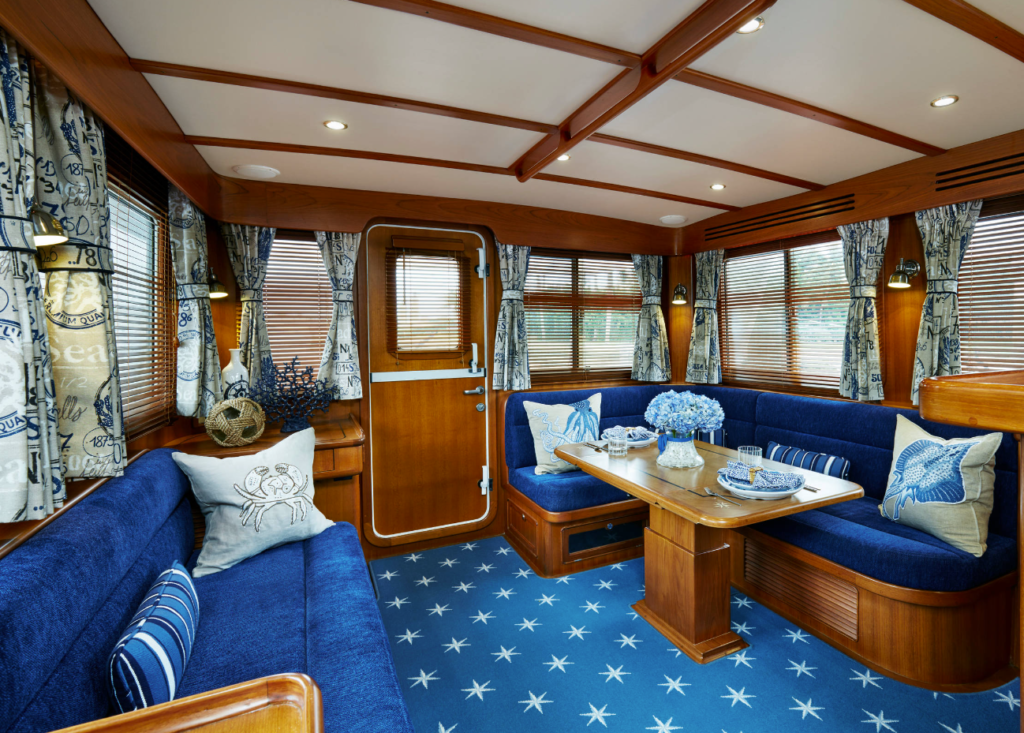
Curtains fulfill their function in unparalleled style. Their rippled contour brings the softness and character that is so badly needed to lift the camper from its inherent industrial vibe to the cozy welcoming ‘home’ that it is envisioned to be. However, it is hard to find curtains in the smaller-than-usual dimensions that are characteristic of RV windows at big box stores, thereby calling for custom curtains. And that puts you in a better position to select the fabric as per the design details you wish to introduce to your camper van.
To that end, here are the top suggestions from our home stylists for camper RV window curtains:
Make Correct Hardware Decisions
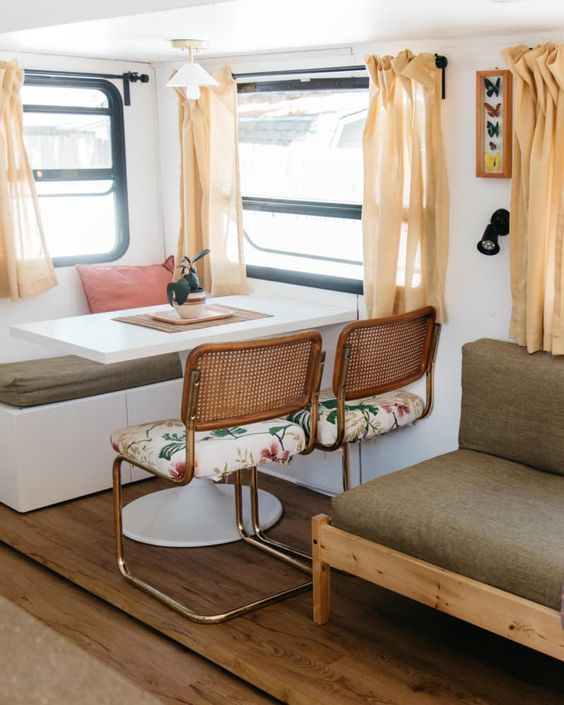
It is common to find manufacturer-provided blinds in RVs which may be removed and curtains installed in their place. You can also keep the blinds and layer them with curtains, in which case, curtains would need to be mounted outside the window frame while blinds stay tucked inside the frame. To make the most of the precious little space in the camper and to live up to the demands of rough travels, you need hardware that’s sleek and sturdy at the same time.
Also, it is important to maximize the availability of light, hence if the space permits, extend your chosen hardware a few inches beyond the trims. When the curtains are pulled aside, they can rest in the gap and thus avoid clumping together on the window. The added advantage is that they accord better coverage when you close them, sealing the sides perfectly so that there are no gaps left for light to pierce in.
RV CURTAIN TRACKS
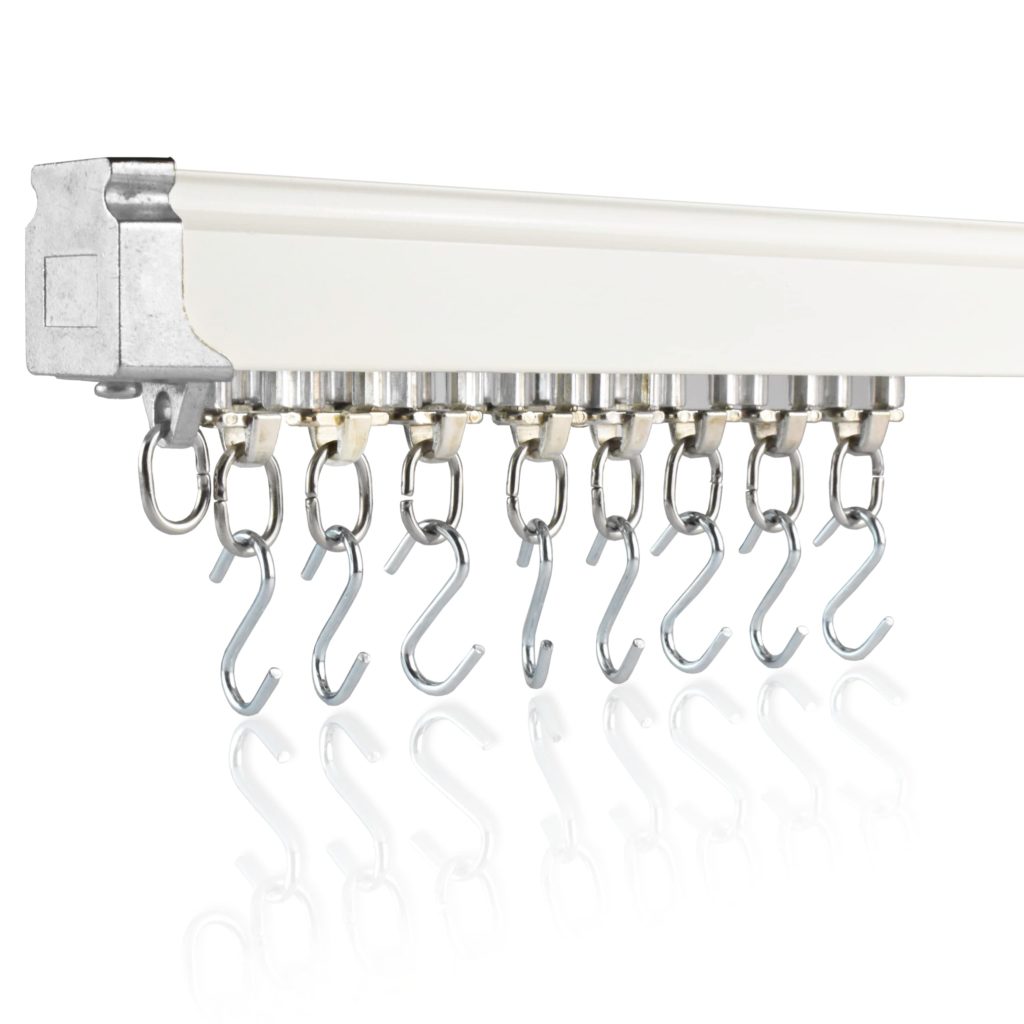
If you don’t want the hardware to be seen, tracks are the go-to. These have the added advantage of being bendable to fit the strange angles of the windows. Caution is advised though, to approach companies that are specialized in providing tracks for boats and RV campers.
SASH RODS

Rods or poles are the next available option. These are decorative additions besides being functional and need no professional help to be installed. You can make use of sash rods (cafe rods) that are easily available and slimmer than the standard home-use rods.
Since RVs have metal walls that some might not want to drill through, unconventional methods are also sought to hang curtains in a van. Some of these methods are listed below:
COMMAND HOOKS
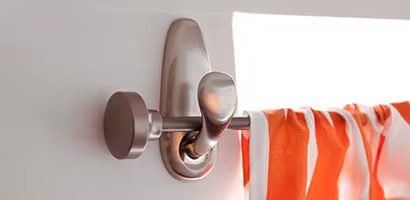
You can use heavy-duty command hooks in place of curtain brackets and complement them with sleek rods that can fit into the hook perfectly.
TENSION RODS

Tension rods can be used in RVs where the walls of the RV can support them from both ends.
VELCRO OR SNAP-ON TAPES
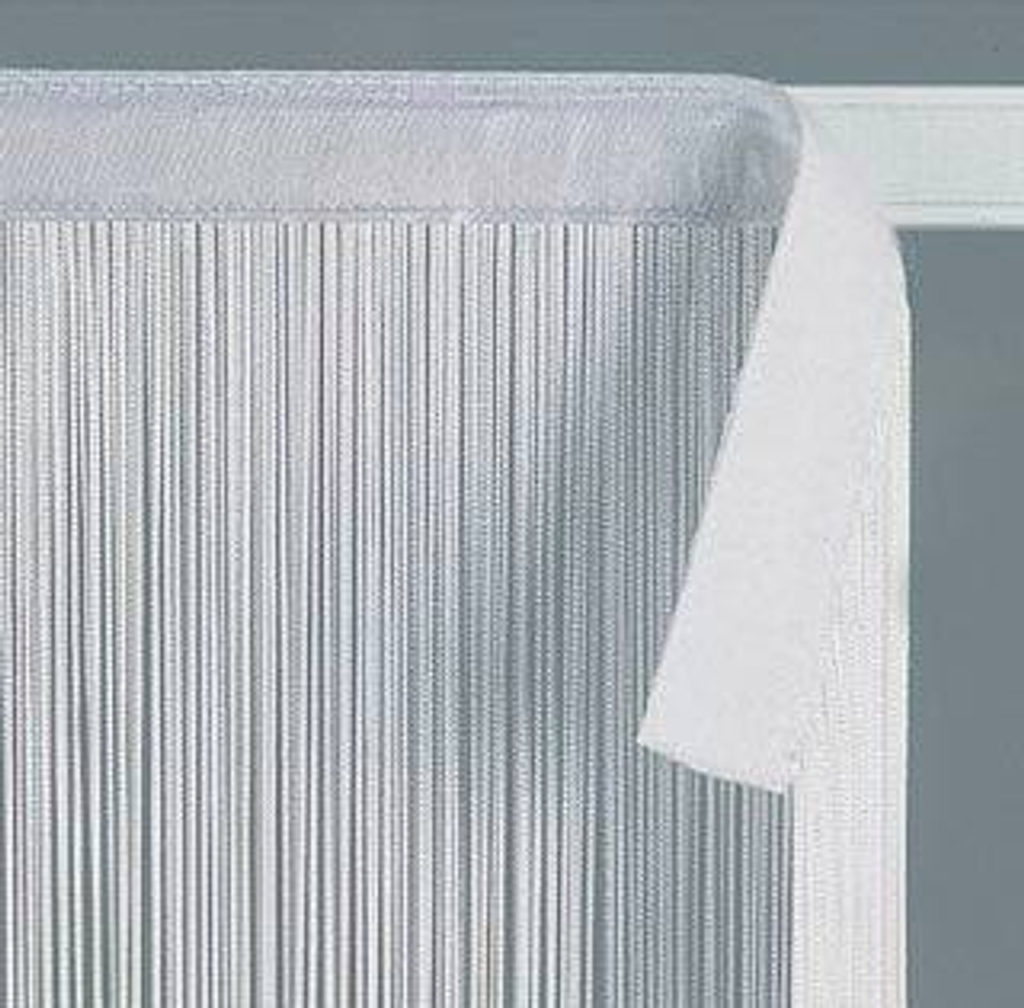
The coarse part of the velcro tapes can be glued to the RV wall and the other tape stitched to the curtains. Another hardware option is snap-on tapes that are attached to the curtains. These get locked with snap-on carriers mounted on the wall. These methods are not recommended for frequently operated curtains as it’s a tedious task to tear off the curtains from the tapes and attach back each time.
ALSO READ: HOW TO HANG CURTAINS WITHOUT A ROD: 6 CREATIVE IDEAS
Discern Length and Width
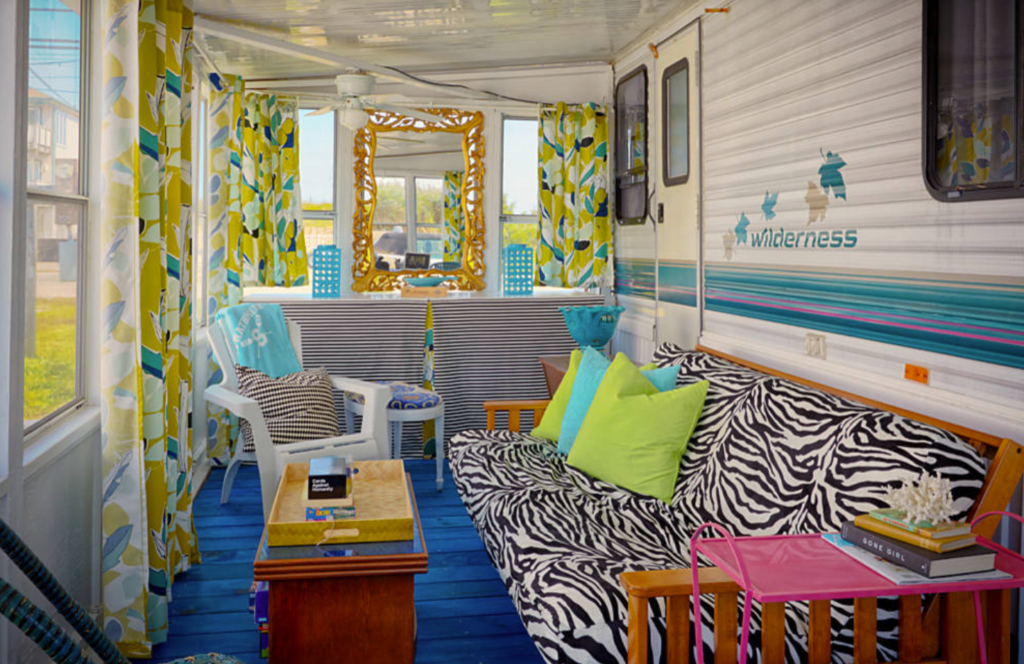
Curtains for an RV camper must be as minimalistic in structure as possible so that the limited space available is not crowded further. You can use a single panel to cover every single pane or, for more light control, hang double panels that rest on each side of the window when open.
Full-length curtains can be used for RV doors if you wish to add some privacy when your doors are open. They can also be considered for windows with free wall space below if that suits your personal tastes and the layout of the space. It is common practice for camper RV owners to choose one nook for an elaborate setting such as the living area or the dining space. Long curtains are used in these spaces to elevate the decor and make these feel more like home.
But for the windows that have furniture pieces below, you need sill-length curtains that look crisp and neat. The curtains may stand an inch below the window trim or touch the surface of any furniture placed right below it such as a bed or table.
As regards the width, it is advisable to keep the short curtains as minimal as possible so they don’t overwhelm the small window. Let the width not cross the 1.5x fullness factor, that is, 1.5 times the width of the window. So, if your RV window is 50” wide, the curtains should not be more than 75” wide. Thus, the curtains will have relatively sparse pleats which is the perfect way to dress a small window. This will ensure that the stacks will also take minimum space on the adjacent walls so they can clear off the window easily and neatly.
For floor-length curtains, you may keep up the same width recommendations if you want to keep the floor and wall least occupied. But should you aim for a more luxe appeal, you may go up to 2x fullness. And take necessary measures to ensure that they do not cause inconvenience or tripping accidents.
One of the things you can also do is invest in suitable tie-backs. Tie-backs stylishly sweep your curtains back from the window and keep them tucked away. As you travel, these will hold back the curtains from flapping excessively. At Spiffy Spools, you can design your tie-backs in the same fabric as the curtains. Alternatively, you can also use thumbtacks to pin them to the wall at the bottom.
READ MORE: HOW LONG SHOULD MY CURTAINS BE?
Choose Befitting Heading Style
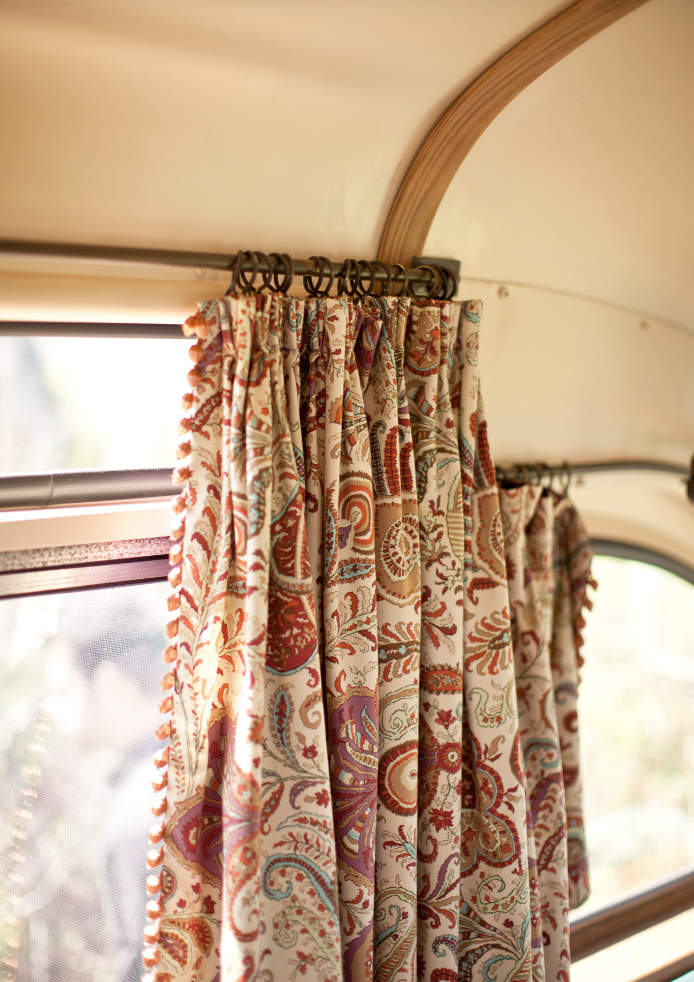
The heading style of the curtains refers to the top portion of the curtains that affects the functionality of the curtains as well as their visual appeal. There are over a dozen heading styles on offer at Spiffy Spools, but not all may be apt for RVs.
Heading styles that employ grommets, rings, or clips glide easily on the pole whereas those with fabric loops or pockets tend to be relatively less mobile on the pole. Both these styles can benefit you in different ways.
You may choose curtains that glide easily for windows that you will operate often like in the kitchen-dining-living area. Whereas, for private areas of the RV where you wish the curtains keep covering the window most of the time, fabric pocket or loop curtains are best.
Simple styles like flat panel tops and rod pocket curtains are ideal as they can pull off a neat look with less width easily. It may be better to avoid elaborate styles like pinch pleats that require more width for construction.
When shopping at Spiffy Spools, you can specify that the rod pockets or tabs and loops on your custom drapes be made smaller to benefit the small scale of RV windows. Thoughtful customizations like these are, of course, the whole point of ordering custom curtains, isn’t it?
Consider Blackout Curtains
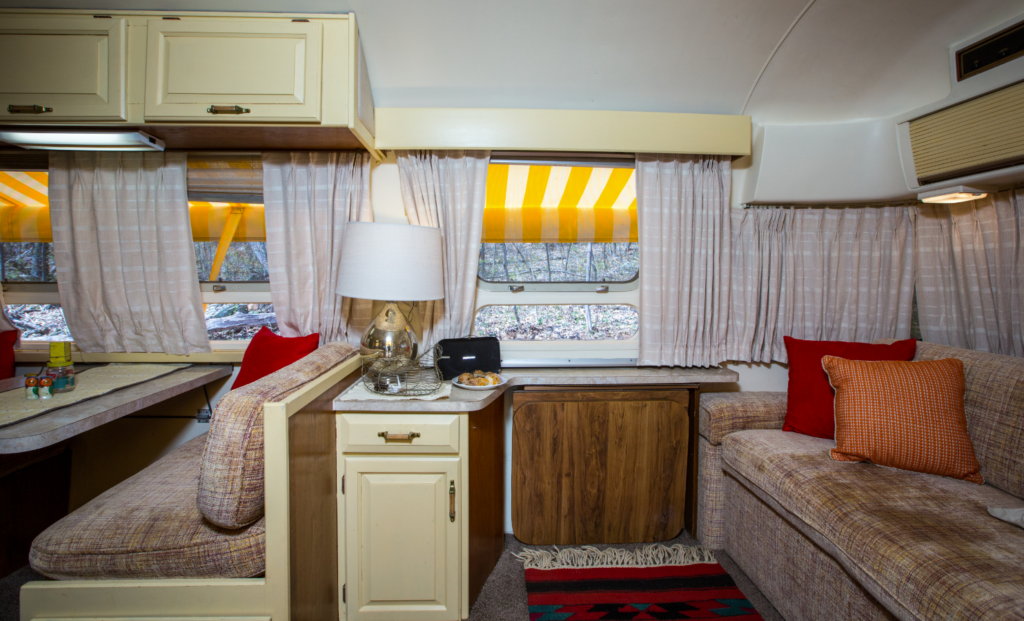
Once you have tackled all the important decisions regarding the construction of your curtains, it is time to pay attention to the choice of fabric. We highly recommend blackout curtains for RVs as they have plenty to offer that ordinary drapery fabrics do not.
Just in case you thought that blackout curtains might not suit your taste, be assured that they come in a variety of patterns and styles. In addition to providing you with plenty of functional benefits, they’ll also add to the design of your RV! But if your heart is set on a non-blackout drapery fabric, you can still reap the benefits by simply adding blackout lining behind your drapes. Either way, blackout curtains provide a variety of benefits that will add to the comfort of your RV.
Blackout curtains block all light. Whether the rising sun wakes you each morning or fluorescent lamps keep you up at night, blackout curtains will help you sleep more soundly by blocking out light and creating total darkness.
Temperature control is another reason why you may consider blackouts. When the sun is beating down on your RV, it can heat up pretty quickly. Since blackout curtains block the sun’s rays, they also block the sun’s heat. This can help to cool your RV. You can say goodbye to all those vinyl covers, Reflectix sheets, bubble wraps, and plexiglass sheets you’ve been adding to your windows to block the heat from entering in. Or, if you’re facing extreme weather conditions, keep them and enjoy the benefits of your blackout curtains, now doubled.
Blackout curtains are further appreciated in spaces such as camper vans and RVs because they are completely opaque, providing you with maximum privacy. Not even your shadow can be seen through them when drawn.
The acoustic aspect of privacy is also taken care of by blackout curtains. When resting at an RV park, you’re often surrounded by fellow campers. People’s voices can carry, and the sounds of the nearby road are often loud and unpleasant. But, with blackout curtains, you can reduce external noises to better enjoy your RV in peace.
READ MORE: ROOM DARKENING VS BLACKOUT VS DIMOUT CURTAINS: WHAT’S THE DIFFERENCE?
Make Your Design Decisions
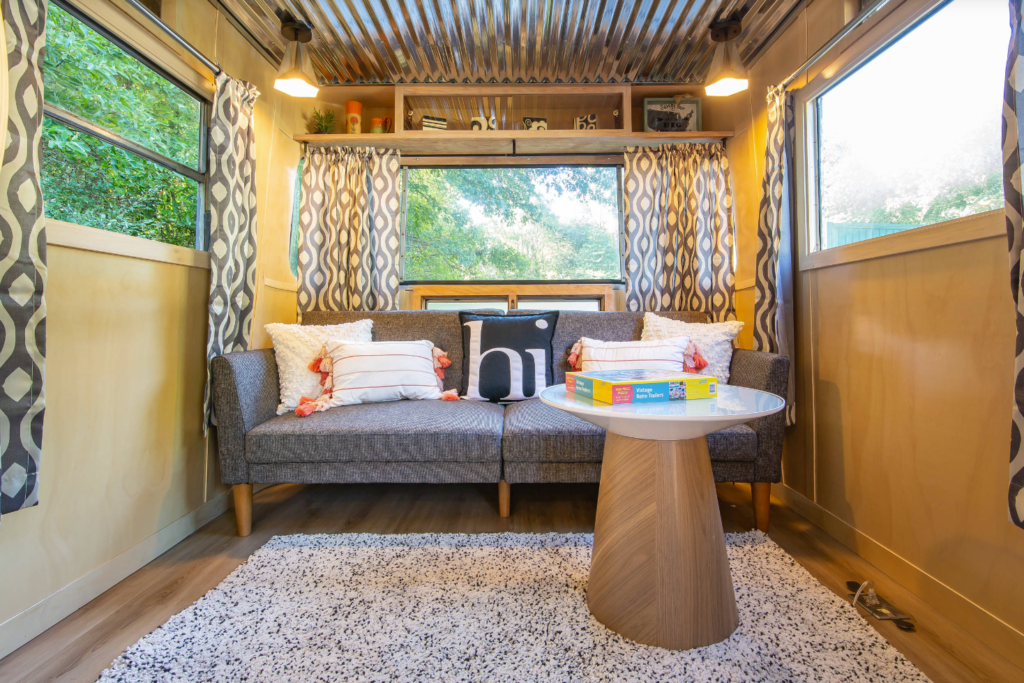
The most exciting part of designing curtains is selecting the aesthetic ingredients. The curtains must support the color story and design language of your home-on-wheels. Every design decision you make may help the space feel more comfortable and personalized.
Palette
As regards the palette of the curtains, light neutral hues may be better if you’re aiming to create a bright and airy feel to the space. You can go for curtains in the same color as the interior walls so that the space feels larger. Small spaces also feel very expansive when designed in lighter hues as they bounce light across.
If you like more insulative curtains but care to build on the bright palette, consider light-hued blackout curtains. However, if you’re aiming for blackout curtains that are super-efficient in room darkening, go for darker fabrics. Dark-colored fabrics absorb light and with the thick weave of blackouts, they do not allow light to penetrate through at all.
Pattern
The next decision to make is whether to choose solids or patterns. Let your choice be informed by the current use of patterns in your RV decor. If you have patterns in huge elements such as the floors and upholstery, use solid-colored curtains to counterbalance. If not, patterned curtains are a nice way to add a fun element. They enable you to show off your unique personality through colors and shapes. This is a great way to provide your RV with plenty of character and charm!
Since it’s a very small space there are a few things to keep in mind when selecting patterned curtains. Let the dimensions of the curtains inform the scale of the patterns. Avoid grand-scaled patterns for short curtains as they will be cut off abruptly. Prefer patterns with mild contrasts and desaturated colors and avoid busy patterns as they can visually shrink the space. Vertical motifs such as stripes, climbing vines, and chevrons can help to visually elongate the windows and the space.
Whatever patterns you may be on the lookout for, be they florals, abstracts, plaids, stripes, or elaborate ones like damask or paisley, you have a plethora to choose from in our collection.
Texture
If you don’t want to introduce patterns nor risk monotony in keeping to plains, consider introducing textural variety. Textured solids are an understated way to add a beautiful visual element to your windows. A solid color curtain can create a bold yet uniform look within your RV! They look calming to the eye and tactile to the touch.
INSPIRATION CORNER
Since pictures speak louder than words, visual inspiration is as essential as verbal guidance. We give you a peek into our collection to stir your imagination and trust that your creative energies will lead you hereon.
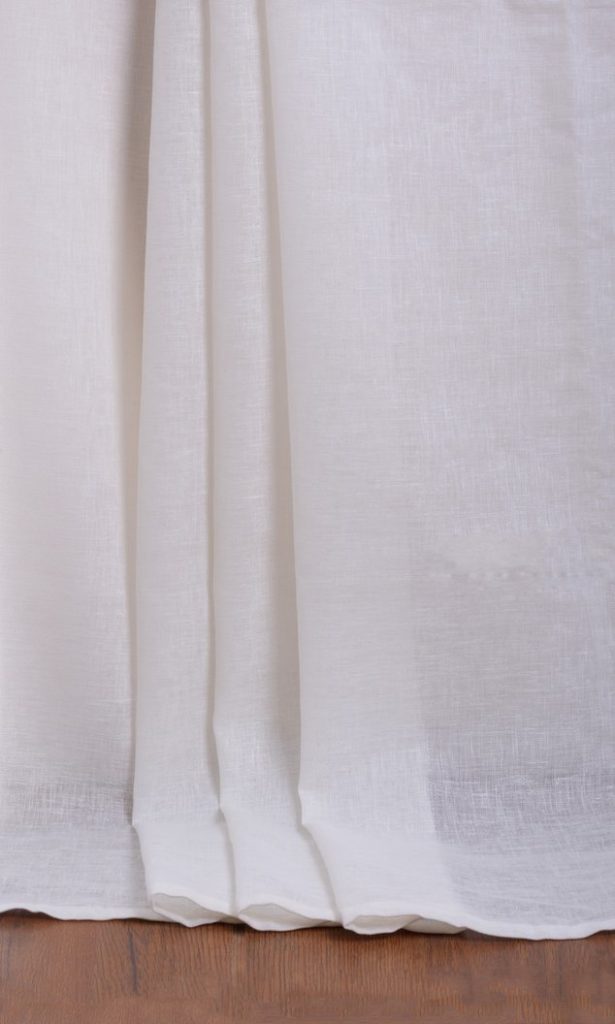
For the living space in your RV which benefits from a bright and airy ambiance, our Whipped Cream linen semi-sheer curtains are perfect. Light will pour in abundance through the nubby textures, rendering a casual yet classic quality to the space.
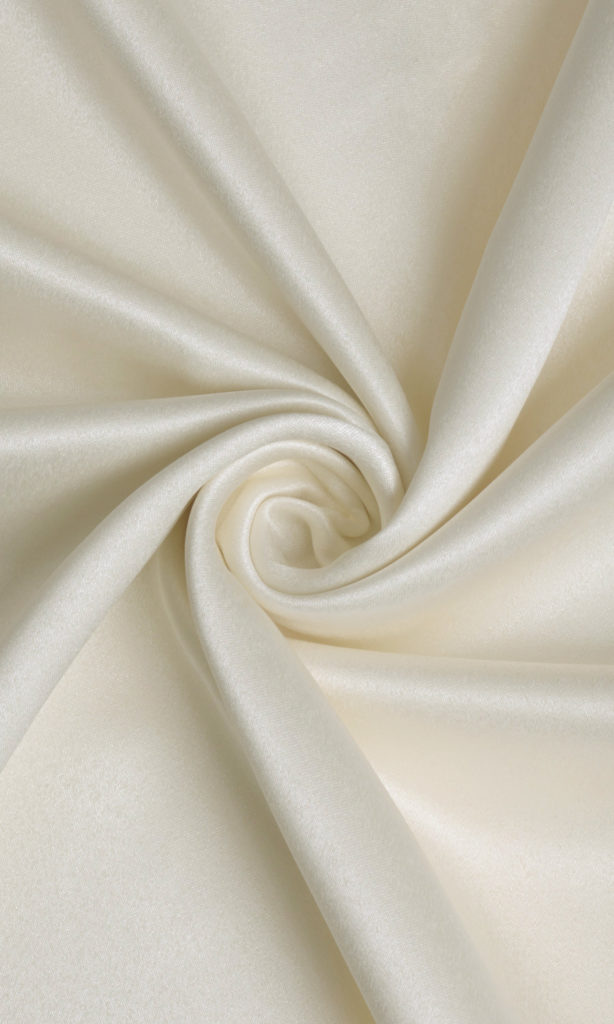
Enjoy the light-blocking energy-efficient traits of blackout drapery with these lovely Warm Snow creamy curtains that are gentle on the eye. Make your RV look more spacious with these neutral base curtains that blend with the backdrop effortlessly.
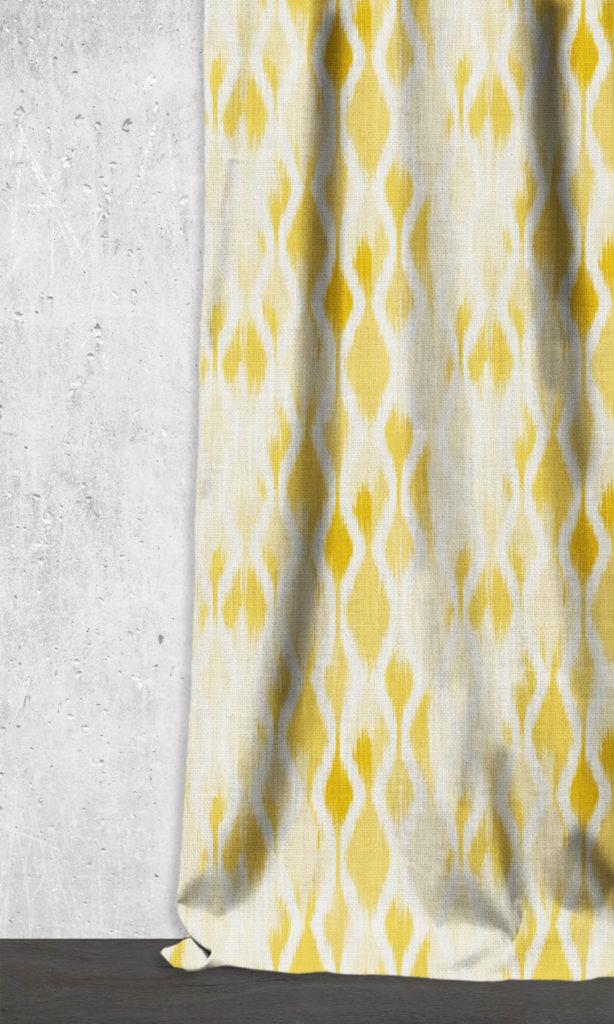
These non-sheer Marrakech Daydream curtains designed in geometric prints inspired by traditional Ikat in a distressed finish are the perfect way to introduce patterns to your camper RV without going overboard. The upward movement of the patterns can optically elongate the small windows.
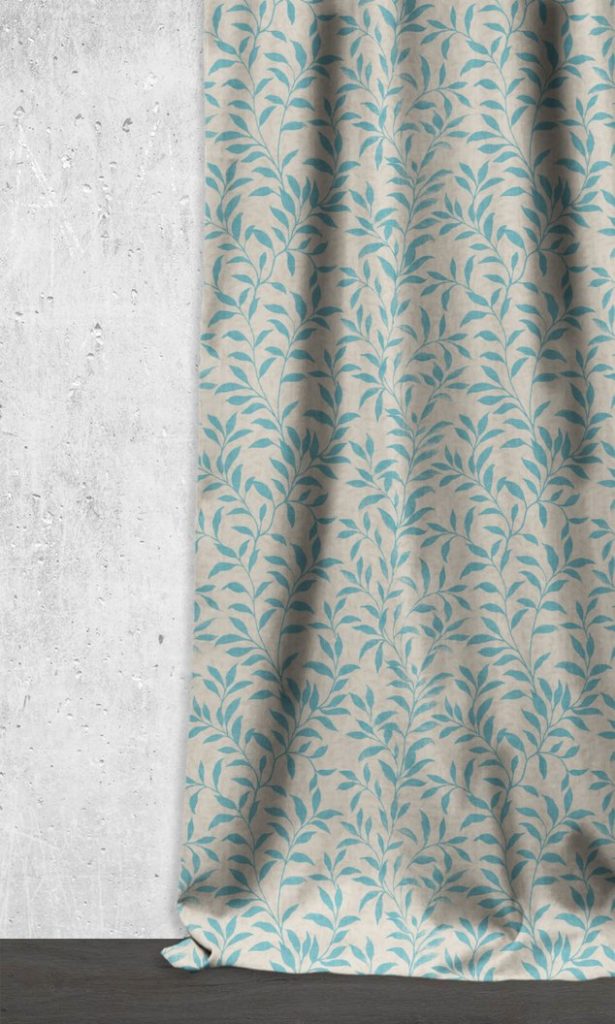
Our elegant Caye Chapel blackout curtains will bring refinement to your RV interior. A turquoise, leaf-strewn pattern makes its way across a lovely eggshell white backdrop. The colors are delicate and the floral print is subtle, allowing them to blend with a variety of décor.
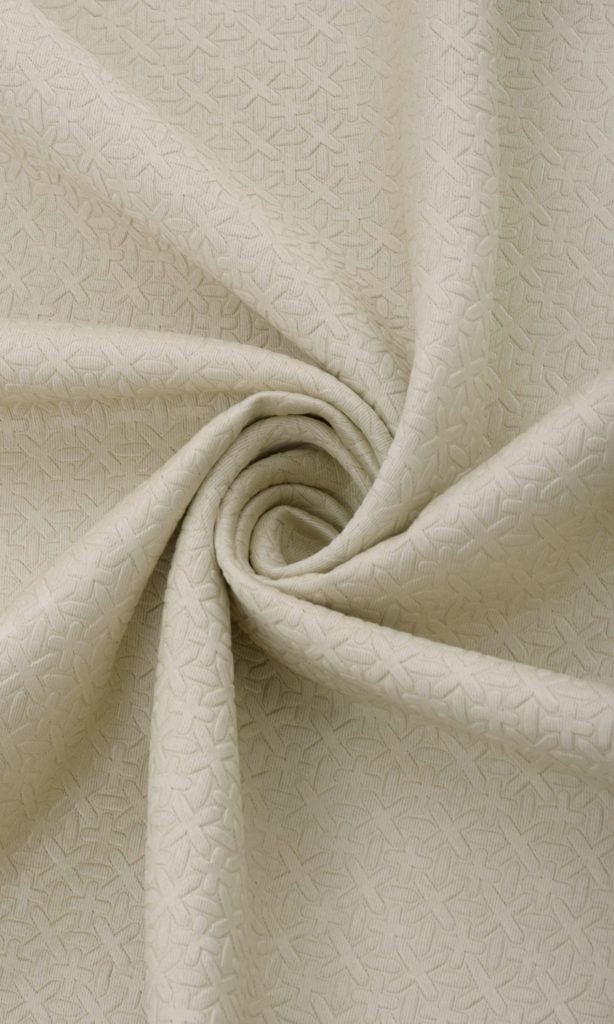
This buttery cream blackout fabric has embossed patterns that can render a soothing and luxurious look to your RV. The heavily textured finish of Rhythm offers scope for the play of light and shadow and the patterns they create are just enough to lift your space from blandness without inviting colors.
Order Custom Curtains from Spiffy Spools
Having ‘parked’ for good reason at the right spot, we hope that you are enlightened enough now to take on the wheels with confidence. Being able to design your camper RV curtains exactly as per your vision undoubtedly adds to the elegance and functionality of your rig. And now it’s time for action. Start designing the curtains and browse Spiffy Spools’ collection today for your project! We make it easy to create custom curtains that fit your exact specifications. Explore our site to find the perfect options for your camper van/ RV, and don’t hesitate to contact us with any questions!
READ MORE: GEOMETRIC BLACKOUT CURTAINS: MERGING FORM INTO FUNCTION
CAFE CURTAINS: SHORT, SWEET, AND IDYLLIC
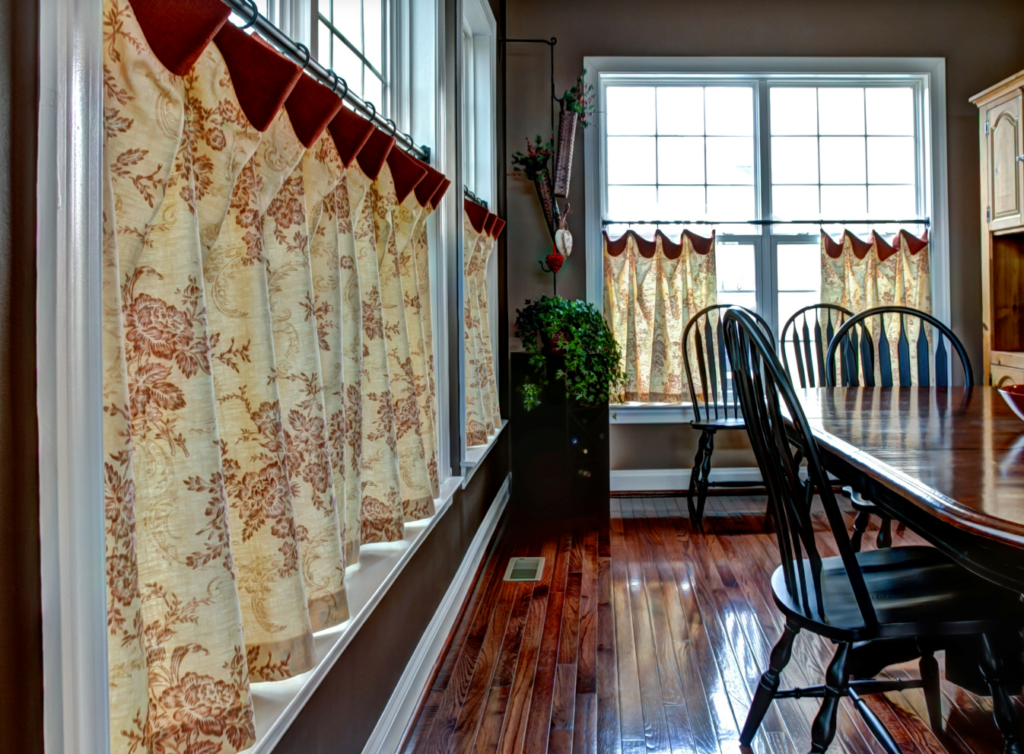
Not your grandma’s curtains anymore, the ever-charming cafe curtains are making a comeback in contemporary style! These practically convenient and adorably charming window treatments once relegated to kitchens and bathrooms are now wowing us in other spaces as well. And for good reason(s) too!
Covering the lower half or two-thirds of the window, cafe curtains’ minimalistic structure enables them to provide privacy while allowing light, making their operation a rare need. If you’re also going gaga on this trend and looking to add cafe curtains to your home, this blog is just for you.
Order custom cafe curtains from Spiffy Spools online in any size. Pick from over 3,000 fabrics and patterns!
Practical Efficiency of Cafe Curtains
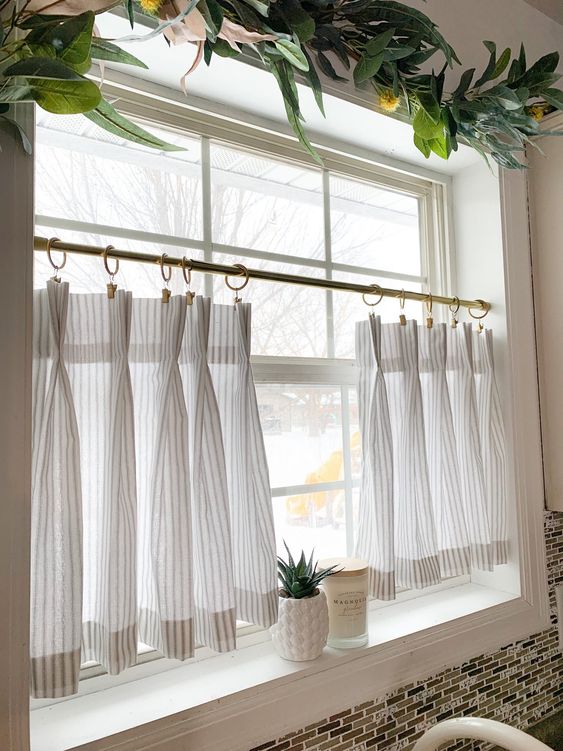
Some styles get buried in time while others age gracefully, finding new iterations to meet the changing needs and lifestyles. Cafe curtains have graduated from the country charm of plaids, frills, and lace to pristine whites, modern prints, and contemporary heading styles. Their comeback is a testimonial of their distinctive elegance and practical efficiency which may be described as following –
- AMPLE PRIVACY: Secluded homes and windows overlooking vacant plots, or non-private rooms like kitchens and breakfast nooks do not need full coverage of windows for privacy. Covering only the lower portion of the window – as cafe curtains do – shields a seated person from being visible from outside.
- UNINTERRUPTED LIGHT & AIR: While providing privacy, cafe curtains do not compromise the inflow of light and air, thereby helping you achieve a balance of light and privacy in the room.
- MINIMALISTIC STRUCTURE: Provided that full coverage is not a requirement, cafe curtains are appreciated where sill-length treatments are sought. They stay out of the way in high-traffic zones, pose no potential danger of tripping accidents on kids and pets, do not infringe on furniture or radiators placed underneath, and stay clean longer as they don’t touch the ground. And, when mounted inside the window frame, they provide the same convenience as blinds/shades.
- BUDGET- FRIENDLY: Lesser fabric translates to lower cost. Cafe curtains that are way more affordable than sweeping draperies are feasible options for shoestring budget revamps and rentals.
- WET ZONES: Cafe curtains provide the aesthetic beauty of long drapery without having to do with its bulkiness and the problems it invites in wet spaces like kitchens and bathrooms. They are quick to dry if they get wet and easy to wash when soiled.
Styling Your Cafe Curtains: Tips & Tricks
If your heart is set on the easy-breezy cafe curtains for many reasons outlined above, it is time to take the plunge and design your very own set for your home. We have all the tips and ideas ready to help you with the task.
Discern Length: Where to Start and Stop?
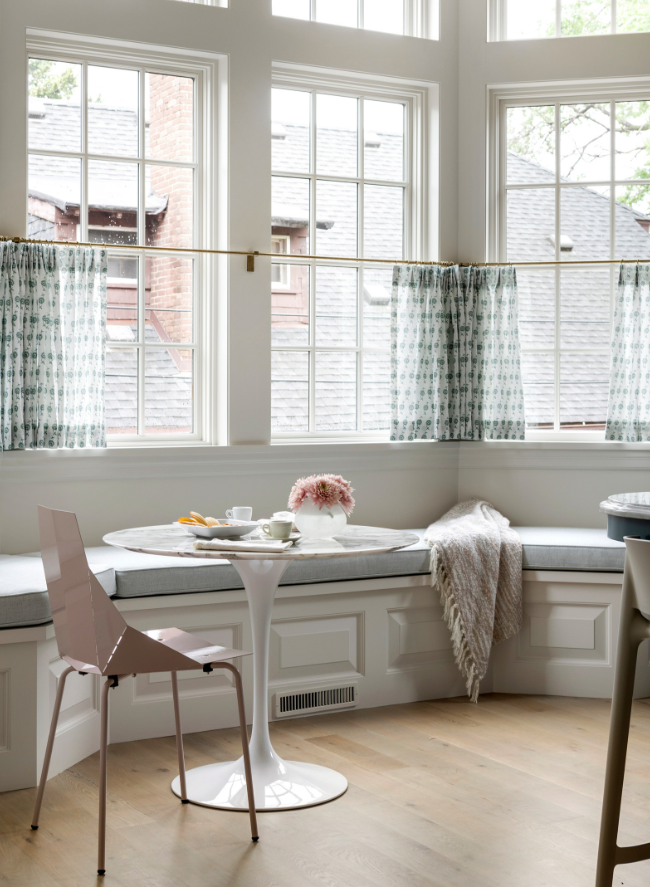
At a minimum, cafe curtains must cover the lower half of the window and at a maximum, the lower two-thirds. You can always push it a few inches upward or downward to suit your specific settings. Consider two questions when fixing the starting point. Which position will enable the desired level of privacy? How much light and air is required in this space?
Where the cafe curtains should end depends mainly on your personal preferences and the function of the room. You can let them brush the sill or extend a few inches below the sill.
Stopping at the sill frees wall space to better accommodate inbuilt seating arrangements below or furniture pushed against the wall. It is recommended in kitchens where the curtains need to be protected from potential spills, splatters, and fire hazards.
Extending below the sill makes the curtains less flappy when it’s windy. It helps aplenty in bathrooms where privacy cannot be compromised and in bedrooms, private studies, and home offices where fluttering fabrics can be distracting.
Keep in mind the purpose of the room and the visual appeal you aim to create when deciding where your cafe curtains should start and stop.
Fix Opacity Levels: Semi-Sheer, Sheer or Non-Sheer?

Opaque cafe curtains are the default choice where the intention is to provide maximum privacy such as in bathrooms and bedrooms.
Transparent cafe curtains can be used as standalone window treatments where the goal is not privacy but adding charm and character. Kitchens, laundry rooms, informal dining rooms, rumpus rooms, and reading nooks are some of the spaces that can benefit from sheer cafe curtains. They keep it airy and light and provide the softness that only fabric accessories can unfailingly bestow.
The translucence levels can be defined as per the purpose and the look you are going for. Gauzy fabrics like voile emanate whimsy while loose-woven linen may accord more privacy with a touch of sophistication.
Voice your Style: Country or Trendy?
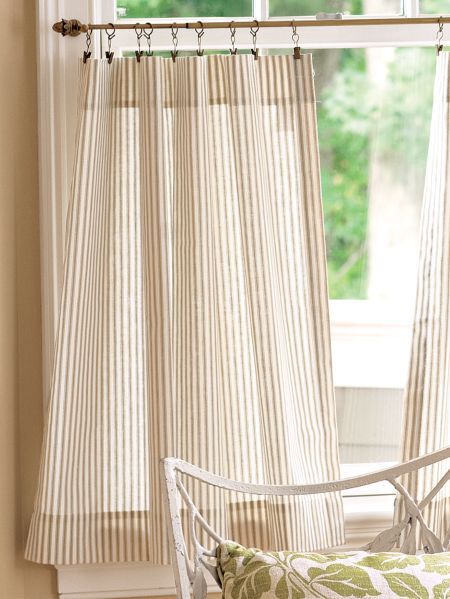
Once confined to the ‘le territoire’ of country decor, cafe curtains have evolved gracefully over time. No matter which style of home decor you follow, you’ll find a way to incorporate cafe curtains in the casual rooms of your home.
If you’re leaning on country charm, go for cotton fabrics with traditional patterns like stripes, ditsies or plaids in frilly rod pocket style. Imagine the ever-so-classic gingham check featured on short red kitchen curtains, further paired with a valance made of the same fabric for a true je ne sais quoi vibe. Does anything spell more country than this? We think not!
For a farmhouse touch, a pair of white linen cafe curtains in double pinch pleats style is just what you need. For the soothing visual impact of cottage style, go for pastel floral prints on bright neutral backdrops. Pair with wooden drapery rods to tie in with the woodblock floors and seaweed baskets.
If it’s the sleek minimalism of modern decor that you’re looking to create, go for poly-blend fabrics in textured neutral hues or contemporary geometric prints. Hang your cafe curtains on jet-black hardware for their clean lines to stand out.
Pay attention to the selection of the fabric, palette, and pattern and coordinate with befitting hardware and heading style to voice your decor style loud and clear.
Pick a Heading Style: Function, Appeal or Both?
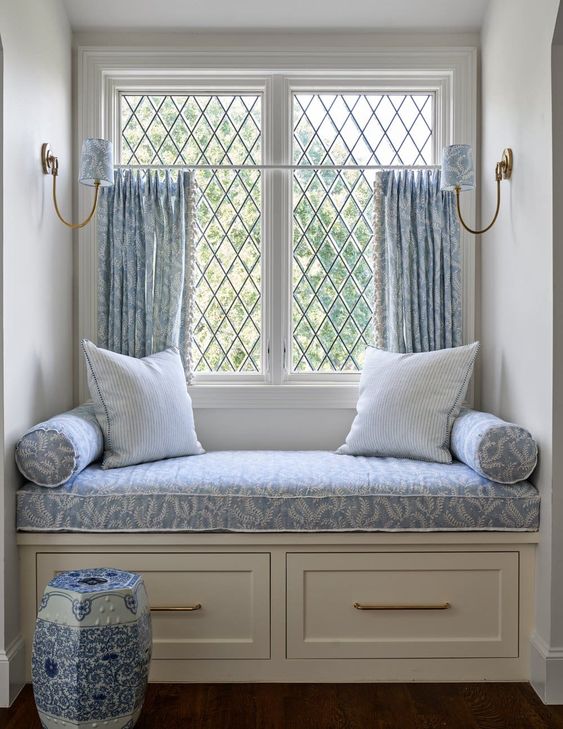
Talking of heading styles, you first need to know that there are many to choose from. The choice should hinge on your decor style and the frequency of operation that you anticipate regarding the curtains and/or the windows.
For a casual look, consider rod pockets, grommet tops or tie tops for their easygoing looks and simple construction. Whereas, for semi-formal spaces, go for more detailed headers in tailored styles like euro pleats or classic pinch pleats.
Generally, cafe curtains are left closed since they allow light to come in from the top of the window. If you want your curtains to remain intact in this position and not gather to the sides under the force of the winds, consider rod pocket curtains.
Whereas, if you envisage frequent operation of the curtains, select curtain styles that employ rings or clips. These glide easily on the pole and your curtains can be tucked to the sides with minimum effort.
It is also important to complement the curtain style with appropriately sized hardware. Since the curtains are lightweight, opt for sleek poles and small grommets/rings.
Amp Up the Style: Little Details with Huge Impact
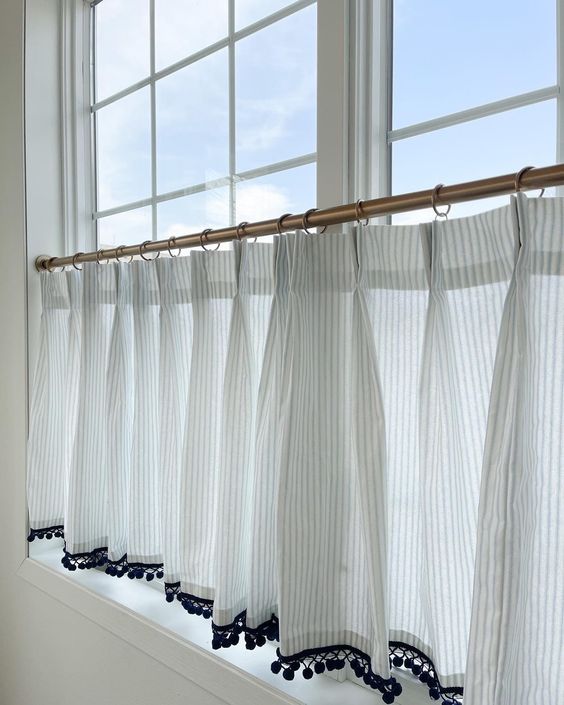
A small decor piece is the safest bet for the boldest foray into a color, pattern, or some quirk! Be adventurously creative, add a unique personality to the space, and sport a custom look. Talk about the ‘small things that make the biggest difference’!
PALLETE & PATTERN: Love a tangy color that you’d be scared of painting a large wall or furniture with? Or, a favorite pattern is waiting for the right excuse to get introduced? Well, let them have their moment ‘cause they can’t overwhelm the space when limited by the small dimensions of cafe curtains.
TRIMS: Cafe curtains with tassels, fringes or pompoms quivering in the winds are the perfect recipe for a relaxed setting. Where cafe curtains run the risk of coming across as a makeshift solution, these dainty handcrafted ornaments relaying a custom look underscore the intentionality.
HARDWARE: Show-worthy hardware completes the picture on a comely note. Let the hardware fall in line with the material and color palette of the room. For example, the gorgeous brushed gold of your bathtub faucets can be echoed in your drapery rod and rings.
TIE-BACKS: If you want unhindered views from your windows and a sun-bathed ambiance before you start with your activities, don’t miss out on tie-backs. They restrain your curtains from fluttering or sliding back and forth due to winds. Tie-backs made of the same fabric as the curtains are a touch of sophistication.
COORDINATED ACCESSORIES: Underscore the designer value of the space with synchronized fabric accessories. In the dining area, the table runner, and at the bay window, the upholstered seating can be coordinated with the cafe curtains in the same fabric. Or, color-block the long curtains in the same room with the fabric of the cafe curtains. Roman shades and valances are other window treatments that can be designed from the same fabric for cohesiveness.
SHOP NOW: CUSTOM CURTAIN TIE-BACKS FROM SPIFFY SPOOLS
Final Notes
Cafe curtains have traversed long and high from the roadside cafes of nineteenth-century Vienna to the modern streamlined homes because they marry beauty with practicality. Even as you watch them billowing away in your social media feeds, and glean ideas from blogs, know that the limits for creativity with cafe curtains are limitless. Explore our site for more blogs and fabric collection to make your design decisions and place your order today at Spiffy Spools!
READ MORE: COUNTRY CURTAINS: OLD WORLD CHARM WITH HOMELY VIBES
PATIO GLASS DOOR CURTAINS: IDEAS & TIPS
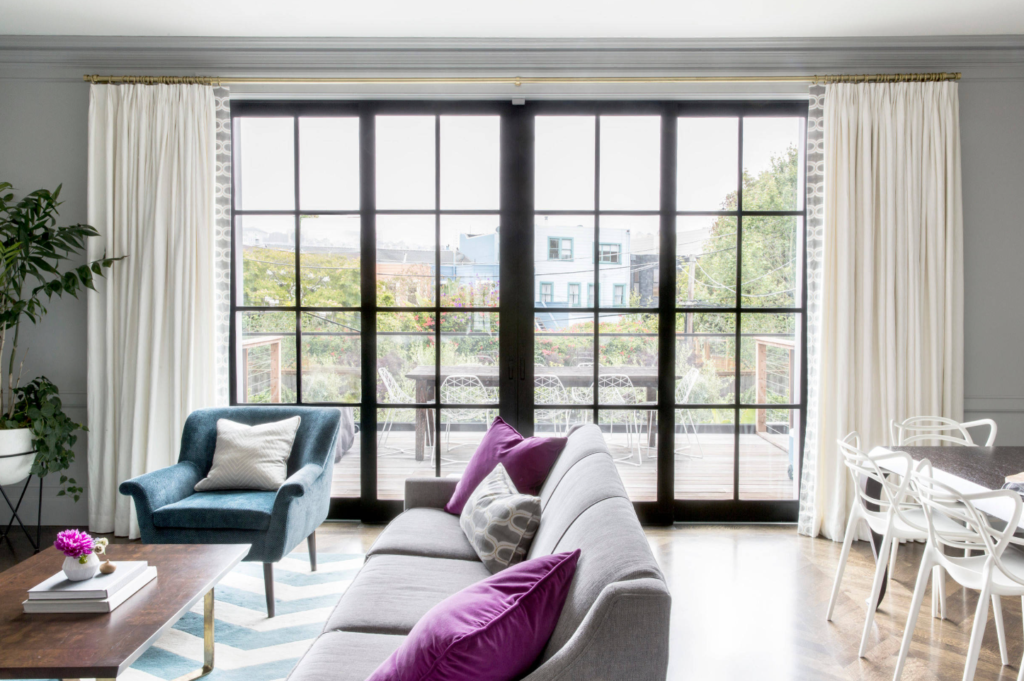
Whether a luxurious turf garden that hosts buffets or a small pallet deck with a cozy dinette, we love our patios for the way they help us bond with nature and each other. Family and guests lounge here encircled by the lovely breeze and summer light. But, inside the home, it’s a different story – nature’s gifts are cherished but not supposed to hold sway. There’s a time for it to be sun-flushed and a time to get moody, intimate, and hushed. If you’re looking for some creative patio glass door curtains ideas in view of this goal, this blog is for you.
The glazed panels of the patio glass doors maximize light inflow to the home and give round-the-clock access to the picturesque views beyond. Dolling these grand windows with curtains might seem counterproductive to light worshippers but – in effect – makes the space more versatile, taking nothing away from that bright airy charm. And of all the plentiful window treatments offered, curtains and drapes impress us the most.
Order custom curtains from Spiffy Spools online in any size for your patio doors. We carry over 3,000 fabrics and patterns to pick from, so you can design them exactly to your liking!
Perfect Match – Patio Doors and Gorgeous Drapes
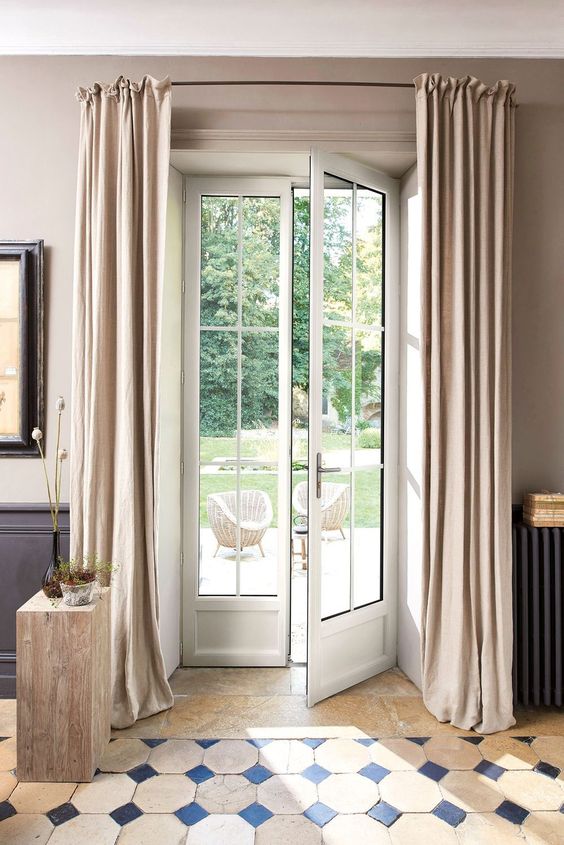
What makes homeowners prefer curtains and drapes for patio doors over other window treatments? What’s alluring about these traditional window dressings that even hardcore modernists often prefer them to technically advanced and sleeker dressings when it comes to patio doors? No matter what type of doors open to your patio – French doors or sliding doors or bi-folds – curtains are ahead of the pack for a few reasons:
Matching Scales
Depending on the size of the patio, the doors may be designed with single or multiple panels. And, even if single-paneled, they are almost always oversized as compared to standard windows and doors for the purpose of providing maximum access to light and air. That grandness calls for window treatments that reciprocate with sumptuousness, and none can do it better than curtains and drapes. Unlike blinds and shades, drapes are not perturbed by the enormity. The hardware is designed to bear heavy loads and the drapes themselves perform better aesthetically when stitched in magnanimous dimensions. The longer, the better the drape; the wider, the more glamorous the pleats.
Endless Customization Potential
Being made of fabric, curtains have no dearth of choices to offer, be it with fabric, palette, or pattern. By far, this is what home designers look for – an endless potential to unleash their creative energies and premium results at the end of the process. Besides, you can get custom curtains to fit the size of your doors as well as the requirements of your decor style more impressively and readily than any of the mass-produced window treatments.
Full Marks for Insulation
Glazed doors make great views possible, but they also conspicuously lose precious thermal energy in freezing winters. If your glass doors are located in bedrooms, the cold drafts drifting in stealthily can cause great concern as they can ward off sleep. You need energy-efficient window treatments like drapes to get rid of the insane bills incurred by the heating system. Besides the possibility to choose a blackout fabric or lining, drapes have extensive use of the fabric unlike other treatments, making their insulative capacity double efficient.
Organic Touch
As the winds go about scattering the scent of fresh blooms, curtains quiver and swell at their beckoning. And this is the most relaxing view one can have while looking onto the patio. That gentle billowing is an overture of the organic beauty of the space beyond. Which window treatment can offer that level of softness and grandeur other than curtains?
Convenient Functionality
When it comes to doors, curtains often get all the upvotes for their side-stacking trait. They are easy to access when they need to be used or cleared. A little maneuvering is enough for anyone to access the doors. If you have sliding doors, you may find them most convenient as both align together as regards the functional aspect.
Complete Clearance
With correctly mounted hardware, curtains can completely clear the doors when not in use. Neither the panoramic view nor the light and air need to be sacrificed. Most other side-stacking window treatments will take away some space from the doors for their stacks.
Alternative Options
Curtains are maximalist per se but do not lack minimalist versions. If you don’t want to introduce voluminous decor accessories to the space or don’t need to ensure privacy and light control, there are other options for you –
SASH CURTAINS: Double rod pocket curtains can be fixed on French doors and framed sliding glass doors. They get neatly tucked away behind the handles providing fuss-free operation and just enough coverage.
DECORATIVE DRAPES: If you love delicate flowing trails for their elegance but do not need their full function, decorative drapes can be considered. These are narrow drapery panels that are hung on short rods so they frame the windows and stay intact in that position always. And therefore, you can go for style-oriented decisions like puddling the drapes or using heavy statement fabrics. Decorative drapes don’t provide full coverage but soften the space and become an excuse to bring in color, pattern, and texture. These curtains can be used as standalone if privacy and light control are no issue or as overtreatments on films, shades, or blinds that handle those functional roles.
Did you see why we find patio doors and curtains to be like a ‘made-for-each-other’ pair? Whatever one would wish from a window treatment on the patio – be it function, softness, or style – curtains and drapes leave no room for want. If you feel proud of your choice now, get more confident in designing them right with the ideas that follow.
Important Considerations for Patio Door Curtains
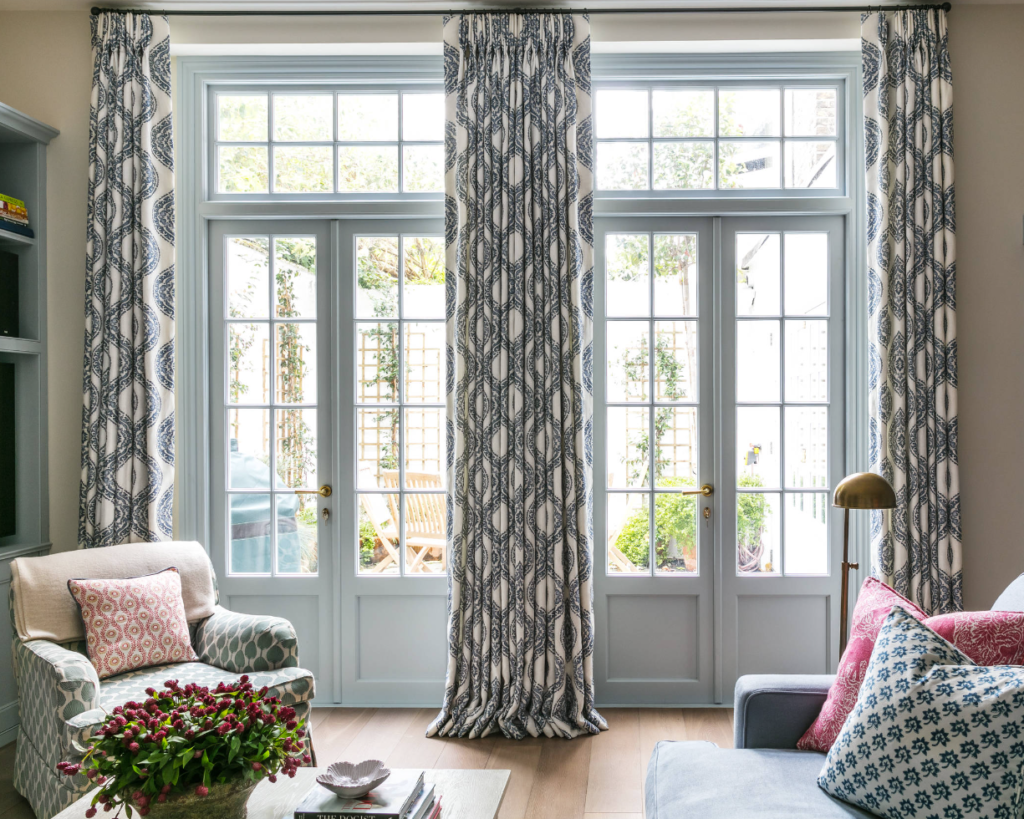
Any project can be accomplished most efficiently only when the goals and parameters are well defined at the very outset. Curtain shopping is no exception! Before you set out to shop the curtains, know what you should be looking for so that you can screen the fabrics in or out with more ease.
It’s All About the Goal
First things first – define precisely what brings you to cover your patio doors with curtains. Is your neighbor’s curiosity bothering you? Or, do you need to cut off the fleeting glare from your TV screen? Or, going a step ahead, do you want to darken the room for a better media experience or sound sleep? Perhaps, you’re not concerned with improving privacy or controlling light but you’re looking for an opportunity to introduce soft textiles and a punch of color. What exactly are you looking to achieve by decorating your patio doors with curtains? Define the purpose and the fabric selection process will be smoothened and shortened.
Support the Room Layout
The oversized doors command more space for the passage, often causing more traffic than expected. And running back and forth from the patio is a sport that kids and pets never tire of. So, it’s important to make sure that the curtains don’t infringe on the doorway. They should clear off when not in use and should not flare or puddle at the bottom posing a tripping risk for the rollickers. Remember how your room is laid out when discerning the length and width of the drapes so that they may have their own space and not overstep another’s.
Have a Plan for the Stack
When the curtains are not in use, they need to be tucked away so that you can enjoy the views without an ounce of compromise. So, gauge the space on the enveloping walls to make sure that they have enough room for the stacks. Accordingly, you may need to lengthen the drapery pole and install tie-backs to hold the curtains in place.
Underscore Your Decor Style
Window treatments like curtains and drapes are credited with immense potential to voice and emphasize your design style as they occupy huge vertical space and are visible all the time. Be cognizant of your personal style when selecting the palette, pattern, texture, weave, heading style, hardware, and accessories. This way they will have taken up a huge chunk of the responsibility to air your aesthetic vision boldly and vividly.
Stylist Tips to Design Patio Door Curtains
Once you’ve got a basic idea of how you want your curtains to fit your schemes overall, it is time to delve deeper into the details. There are five basic decisions you need to take when designing patio door curtains. Here we go –
Choose the Fabric Based on the Needs

Taking advantage of the fact that curtains are made of fabrics, decide on one that perfectly meets the specific needs of the patio doors. So, what are some of those special demands that need to be addressed?
The light and air that gushes in through these oversized ingresses are truly cherished by all and at all times except when it’s time to pay more attention to the television or a laptop waiting for a mail check. And at other times, you may want privacy but not be completely disconnected from the scenic views beyond. So, how do you dress your patio doors with curtains such that you don’t miss the views and yet reserve the ability to cut off light significantly for functional purposes? Addressing opposing needs demands a stroke of genius for sure.
If you need light streaming all the time and are not concerned with nighttime privacy, go for light sheer curtains in loose-woven linen or semi-transparent cotton, polyester, or blends. Especially if you’re dealing with a highly humid place or tropical climate, these diaphanous draperies will prove a godsend as they facilitate air circulation throughout. On the contrary, if it’s searingly hot or freezing cold for the most part of the year, consider blackout curtains. These will retain the thermal energy of the room and make your summers cooler and the winters warmer.
And, if you need both light-filtering and room-darkening at different times of the day or the year, incorporate both sheer and blackout drapes, one over the other. This versatile arrangement allows you daytime privacy with sheers and total cancellation of light with blackouts. For more guidance on layering sheers and blackout drapes, profit from our blogs.
Or, you can go for a happy medium with simple non-sheer, unlined curtains. These filter in light very softly when designed in lighter hues and delicate weaves. They provide privacy during the day and night. Alternatively, these can also be paired with sheer drapes for more versatile control over light and privacy.
Also, remember that your curtains have an important role in relaying your decor style. If your patio is an extension of a formal living room, consider silk or velvet drapes. When ordering silk drapes, remember to opt for lining and interlining to protect them from sun damage, or opt for faux silk instead. For patio doors that are situated in a casual spot like the kitchen or family living room, choose cotton or linen to cozy up the space while standing up to rough use.
READ MORE: LIVING ROOM CURTAIN IDEAS & TIPS: FROM MODERN TO TRADITIONAL
Allude to Nature: Select a Befitting Palette & Pattern
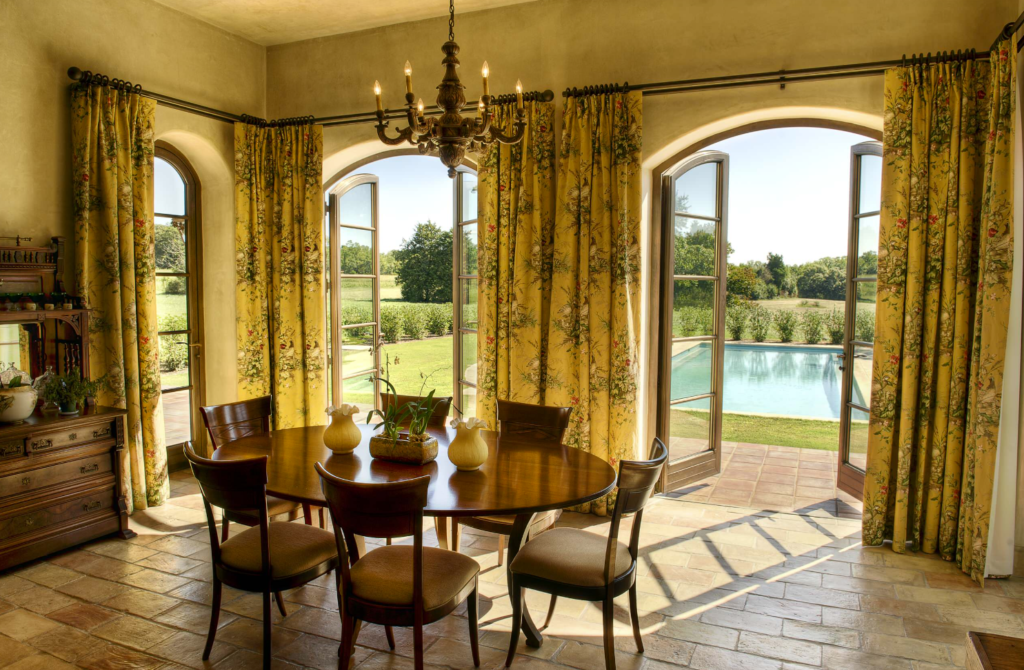
Patios are loved for what they do – letting you have a piece of earth and sky that you may admire the wealth of nature freely bestowed on you. Patio curtains should ideally do the same, if not with the same intensity, through palettes and patterns that connect the mind with natural themes and idyllic landscapes.
Color schemes that bring stories of the earth to your mind are ideal, such as, green and brown which tell of verdant woods, beige and blue evocating swelling seas on sun-kissed sands, scattered reds, and yellows redolent with Spring’s fresh blooms, and so on. Before you draw the curtains back, your mind can anticipate the beautiful view waiting to be unveiled. Or, go for solid neutral hues that will recede into the background making the scenery stand out like an art piece and forging a statement of its own.
If the space is designed with solid colors, it’s begging for some patterns and curtains are a splendid opportunity to introduce them. The eye-engaging play of shapes and colors can rescue a monochrome setting from starkness and tedium. Again, it may be nice to allude to nature with florals and botanicals cuing a luscious garden, ombre recalling a gradient sky, or abstract patterns emblematic of unrestrained creative energies such as the veins of natural stone or the variegated plumes of birds.
Scale Accurately: Decide the Appropriate Length and Width
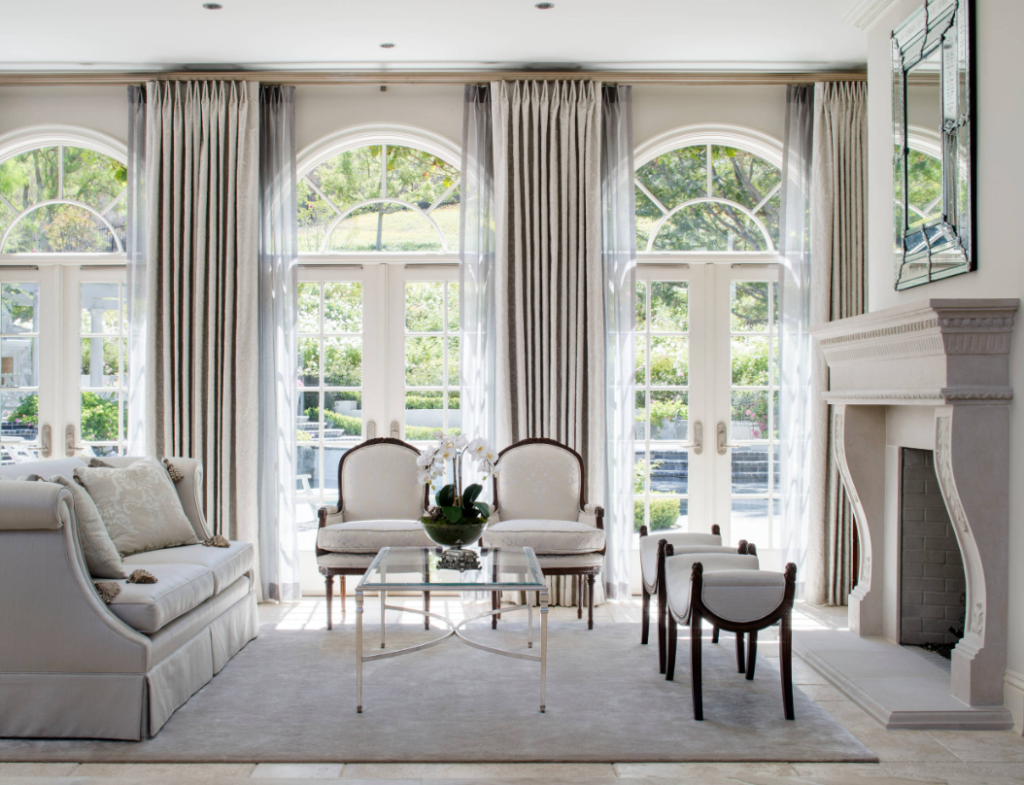
Curtains look great not just because of an exquisitely designed and carefully curated fabric, but also due to accurate scaling and correct measuring. The length and width of the curtains must be discerned based on the functional roles they have to fulfill. Let’s begin with the length.
Length: Floor-length curtains come in various finished levels such as float, kiss, and puddle. ‘Float’ curtains stand an inch above the floor. These are practically easy to maintain as they won’t get soiled or frayed easily at the bottom.
Curtains ‘graze’ or ‘kiss’ the floor when they are designed to barely touch the floor. The floors and the curtains have to be perfectly even to achieve this tailored look. Compared to float-length curtains, these trap dust and dirt easily, calling for regular maintenance.
Curtains that touch the floor and then extend further by 1 to 18 inches are called puddled drapes. They don’t glide easily on the pole and are therefore not recommended if you plan to operate the curtains often. But if your goal is to cancel light totally, we suggest break-puddle length where the curtains extend by only an inch after touching the floor. You will thus cancel the possibility of light glares from below the drapes and they are not very cumbersome to operate too.
Elaborate puddling works fine for decorative drapes that don’t need to be moved at all. Curtains with their puffed trails relaxing on the floor tinge the whole space with softness and drama. They are highly recommended if you wish to accentuate the formal or casual appeal of the space.
If you’re willing to run the extra mile to make your patio doors replicate a hotel suite, go for floor-to-ceiling curtains mounted on tracks. This is the highest level of elegance drapery can achieve and the seamless vertical coverage elongates the space optically.
Now, let’s discuss width matters.
Width: Curtains are stitched in 2x to 3x sizes to get amply rounded and dense pleats. That means, if the patio door is 100 inches wide, the curtains must be at least 200 inches wide. For sheer curtains, we recommend a minimum of 3x width so that the rich pleats may accord more privacy.
When deciding the width, account for the stacking room on both sides of the doors. Fuller curtains will need more space to stack and if the wall space is not sufficient, the curtains will borrow some from the doors. Alternatively, you can reduce the width to 1.5x fullness to make the stacks sleeker but not more than that as you might end up with extremely sparse pleats.
Style Correctly: Choose the Right Heading Style
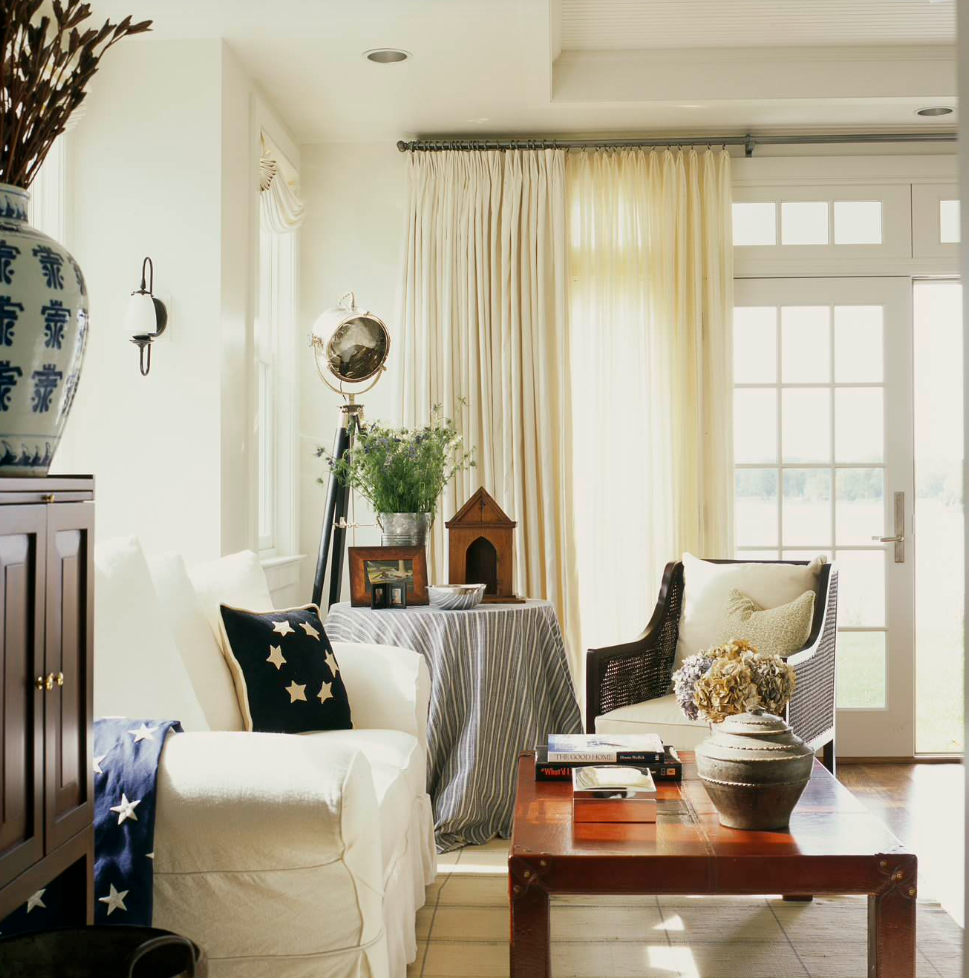
An important decision that affects the functionality of drapes is regarding their heading style. The ‘header’ or pleat style of the curtains impacts not only the aesthetic but also the ease of gliding drapes on the pole.
Curtain styles that use rings, clips, or grommets such as pinch pleats, grommet tops, flat panel tops, and ripplefolds glide easily on the pole/track. Select these styles if you intend to access the patio or operate your curtains often.
Curtains that are constructed with fabric loops and pockets such as back tab tops and rod pockets don’t glide as easily. Therefore, these are better choices for sheer drapes that must stay covered throughout the day to accord flawless privacy.
After you’ve made a choice between these two broad categories, you can select a curtain style that best tallies with your decor style. For example, in a traditionally styled home where the patio doors are part of the formal area, go for triple pinch pleat drapes or euro pleat drapes. Conversely, in a modern home, simplistic styles such as flat panel tops or grommet tops suit better.
And if you need tight control over the light inflow at times, perhaps when you watch television, be wary of falling for styles that let light in through the top. Or, be careful to mount the hardware high enough to curtail light penetrating through the gaps of the header.
READ MORE: CURTAIN HEADINGS STYLE GUIDE FROM SPIFFY SPOOLS
Complement the Curtains: Choose Apt Hardware
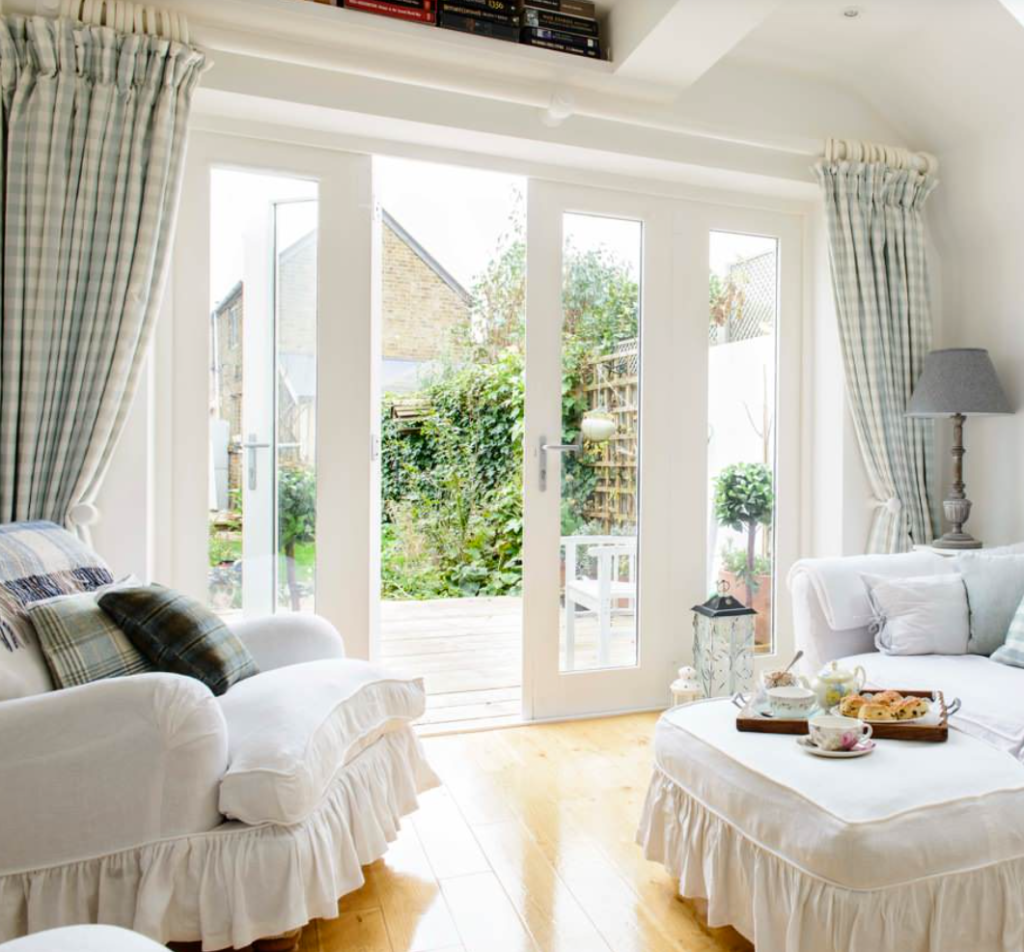
No matter what heading style you choose, factor in the type of hardware you have if they are already installed. The hardware and the heading style have to complement each other. Some styles work with tracks, others with poles, and thankfully there are those that work with both.
If you like concealing the hardware for a minimalistic appeal, consider tracks. Conversely, if you like the look of exposed hardware, make sure that you invest in show-worthy drapery poles with artistic finials. And choose heading styles that let you show them off rather than cover them.
The hardware choice is another element where you can highlight your decor style fittingly. So, don’t miss the opportunity. For example, in a contemporary style home, you can go for sleek black drapery poles with flat cap nickel finials tying in with the clean lines and neutral palette.
Forethought is advised when selecting hardware for layered treatments. Install double-curtain rods if you wish to layer curtains with curtains or valances. They look neater and require half the chore as compared to selecting and installing two separate poles.
When measuring for the hardware, remember that they have to go beyond the door themselves. Extend the drapery rod/track by a few inches on both sides so the curtains can stack on the walls when not in use.
Winding Up
We hope that the journey thus far has got you more enthusiastic to take on the patio door curtains project and more insightful to accomplish it with confidence. At Spiffy Spools, you are guaranteed quality fabrics, flawless craftsmanship, and budget-friendly prices. Browse Spiffy Spools website for more inspiration and our blogs for more insight on designing any space with the perfect fabric window treatments. Enjoy the process of researching, designing, and shopping for your patio door curtains while the pleasure to make this happen in your sweet home is all ours.
READ MORE: WINDOW TREATMENTS FOR PATIO DOORS: TOP IDEAS & TIPS
PUDDLED CURTAINS & DRAPES: STYLING TIPS, PHOTOS & IDEAS
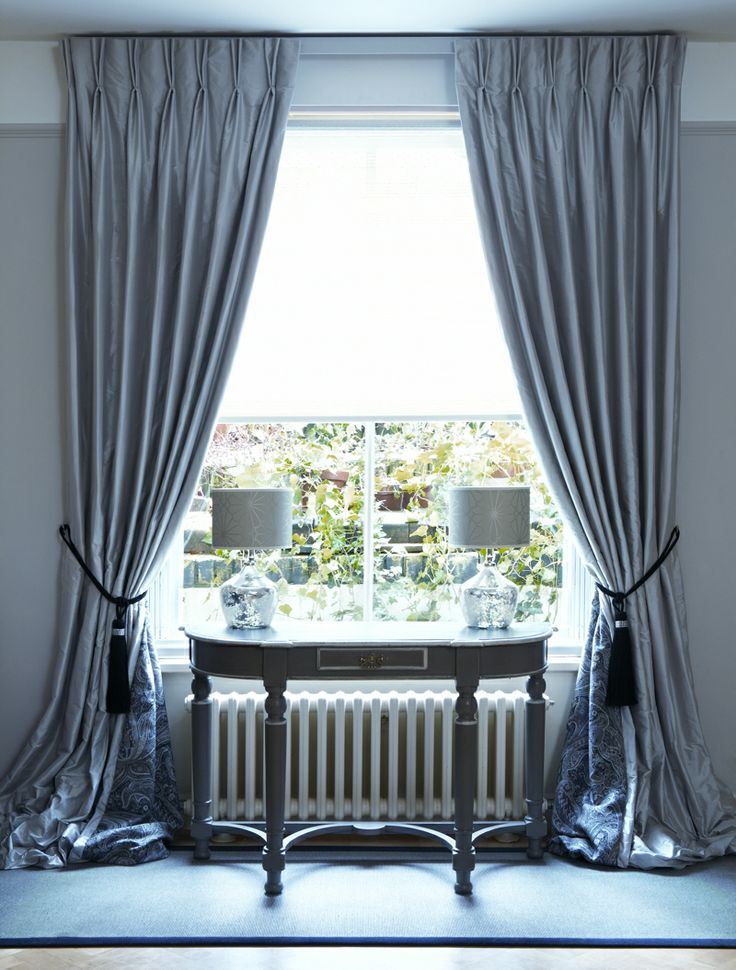
Like your home to look like a still from a palace of the nineteenth century embellished tastefully with flowing regal drapes? Or, though a modernist at the core, you gladly welcome a masterful stroke of glamor sheathed in sophistication? Wherever you find yourself on the scales of traditional maximalism and modern minimalism, you’ll find a style of puddled drapes suitable to your taste and needs. And if you’re looking for styling tips for puddled curtains and drapes, this blog is for you.
Whether the drapery extends just a tad bit on the floor or forms an extravagant pool with gorgeous swirls and folds, puddled drapes speak of an intentionally achieved look for a space that’s very precious to you. If you want to puddle your drapes in a way that echoes your style but without coming in the way of function, read on.
Order custom curtains and drapes from Spiffy Spools online in any size. Pick from over 3,000 fabrics and patterns!
What Are Puddled Curtains? What Do You Achieve by ‘Puddling’?
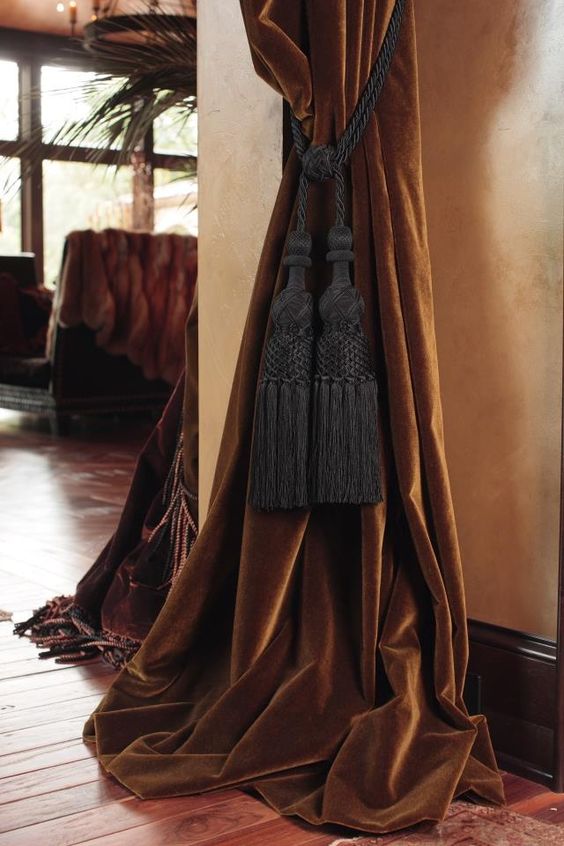
Puddled curtains fall in the category of floor-length curtains that uphold the ‘more is more’ concept of interior design. In contrast to most curtains that graze or hang just above the floor, puddled curtains “pool” or gather on the floor. To achieve a puddled look, you need an excess of fabric in terms of length.
It is believed that puddled drapes were a way of showing off wealth in the early eighteenth and nineteenth centuries when pure silk and velvet were rare and expensive. Perhaps that’s why, at the turn of the twentieth century when Victorian excesses were getting purged, puddled drapes got confined to formal rooms, banquet halls, and palaces.
Today, however, puddling is not a financial statement but a design statement. The exquisite spillovers are considered an overdose of softness and glamor rather than an elitist display of opulence.
But hang on, don’t conclude that puddling has only got to do with aesthetic appeal. The excess fabric of the puddled drapes has functional roles too. Digging deeper for the ‘why’ reveals how tempting they can get to be even to diehard minimalists because they have solid purposes to serve, such as –
- BETTER INSULATION: The excess fabric adds weight to the drapery and piles up, limiting their mobility and efficiently reducing the fluttering during windy days. In extremely cold weather, it also means that cold drafts will be well-contained at the window itself, not allowing them to force in at the jambs or the sill. And that means lesser power consumption and lower bills.
- EFFICIENT LIGHT CONTROL: In bedrooms and media rooms, light leaks from under the drapes can ruin the whole experience of the space, despite all the care that was invested in selecting the fabric. Puddled drapes seal the bottom of the window seamlessly so that those disturbing sharp glows are canceled.
- FORGET LENGTH WOES: With fabrics that lack dimensional stability, it is hard to maintain the finished length of the drapery around the year. Fabrics like pure linens can stretch and shrink as per the seasons and the humidity levels, sometimes unevenly to make the scenario worse. Care to puddle them a few inches, and you can care less about the length.
- CLEVER COVER-UPS: Sometimes, it’s the architectural flaws that get you. One of the biggest worries homeowners deal with when ordering curtains is about measuring the length with precision. Think of those uneven floors and erroneously aslant windows that you can never cover with floating curtains flawlessly. The unequal gaps between the curtains and the floors will stare at you with their sharp light glows even if you choose to ignore them. Shoot these pains if you’re ready to puddle the curtains.
- UNDERSCORE THE ‘FORMAL/CASUAL’ MOOD: No matter what the mood of the space, puddled drapes can build over the original tenor to exaggerate it intentionally. When dressed in statement fabrics like silk, brocade, or damask, they color the space with a regal flair. And, they do just the opposite when designed with homely and natural fabrics like cotton and linen. The fluffed-up fabric let loose on the floor gives off a very relaxed, easy-going vibe to the space. And more so, when done with elegant sheer panels as the translucent fabrics pile up gracefully, making the whole space ooze with whimsy and softness.
- TIE BACK IN STYLE: Lastly, if you intend to hold the drapes with a tieback securing a stylish swag at the top, the excess trails help the most distant end of the drapery to still reach the floor. Should the curtains stop at floor length, the inward side of the panels would come across as skimpy and under-finished as they would rise above floor level when tied back.
Ah! With all these tempting merits of puddled drapes, who could say no to them? And yet, puddled drapes are not for everyone, every space, or every home. Well, we’re not talking about the minimalistic style of puddling but the elaborate ones where the drapes really ‘pool’ on the floor. Here are some reasons why you may do better by foregoing overly generous puddling –
- The excess fabric trails snag and drag on the floor, making it difficult to operate them. For curtains that need to be moved often, consider float curtains or ‘break puddle’.
- If you have toddlers and pets, puddled drapes may cause tripping accidents. Besides, your fur babies’ hair sheds can get clogged in the ‘pools’, making frequent cleaning mandatory. Incorporate puddled drapes carefree in adult rooms where they have no access.
- Puddled drapes take up some area of the floor. And you also need to designate a few inches more for clearance to avoid stepping on the puddles. So, refrain from introducing puddled drapes to space-constricted areas that have frequent footfall like hallways and tiny rooms.
- In the case of bathroom or laundry room curtains which are in wet areas, puddled drapes can be hard to maintain without mold and mildew. In kitchens, they can cause or aggravate fire hazards.
If these red flags don’t show themselves in your situation, or if you are determined to work around them, go all-out carefree. Depending on the puddling style you wish to achieve—as we’ll soon discuss— consider ordering drapes with lengths increased by 1 to 18 inches beyond floor length.
READ MORE: FLOOR TO CEILING CURTAINS: A COMPLETE GUIDE
Choose a Curtain Puddling Style
There are three primary curtain puddling styles. For further customization, each style has its own unique variations as well. Let’s take a look:
Break Puddle
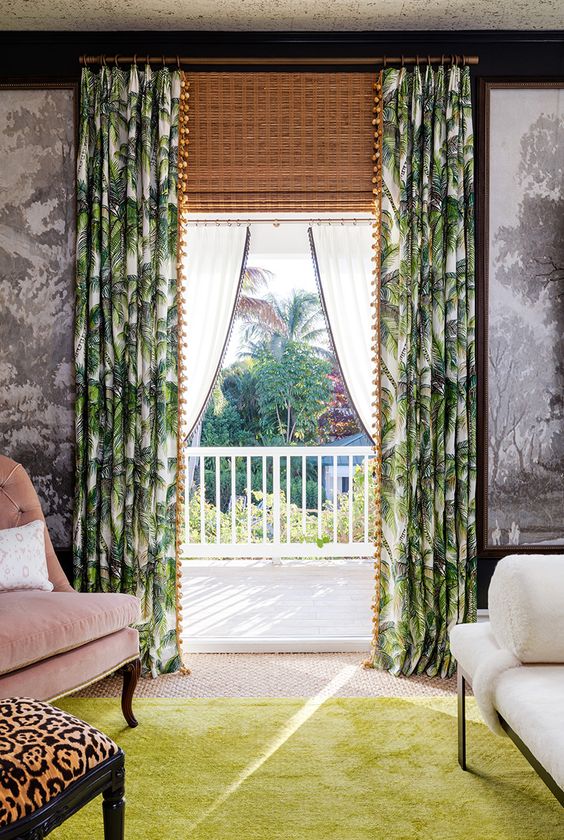
Also known as “break length,” this is the most minimalistic style of puddling. The drapes touch the floor and extend an inch further. An exercise in elegant restraint, one-inch puddle breaks work best with laid-back fabrics such as linens and cottons.
Although you don’t really get to ‘pool’ the fabric, that little excess does make a difference. The curtains make a seamless contact with the ground which makes it a foolproof remedy for uneven floors. You also get to cancel light leaks from the bottom without trailing the drapes more than you can afford to handle.
Also, this style of puddling is to be most preferred for more frequently operated drapes, if your heart is set on puddling them. With the minimized risk of tripping accidents, the break puddle is also the most suitable style for homes with kids and pets. They are also relatively easier to keep clean as they don’t trap as much dirt and dander as other elaborate styles.
Medium Puddle
If you’d like a little more character than what you get from the relatively minimalist puddle break but are shying away from a full-on, dramatic puddle, the medium puddle is a great option to consider. Medium puddle curtain styles require curtain length to be increased by two to five inches.
A medium puddle can be dressed in a couple of styles:
CASUAL BREAK
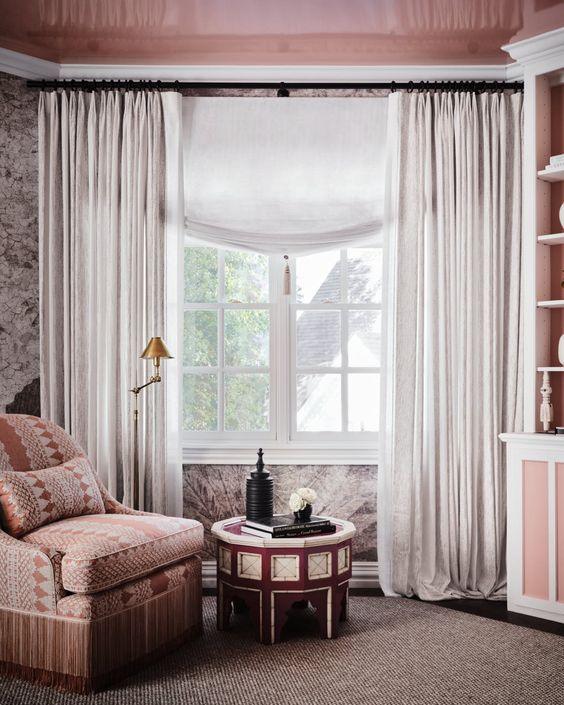
For this style, simply hang your curtains and allow your pleats to lie naturally. This is the simplest puddling style in the lineup, as they require no arrangement.
TAILORED BREAK
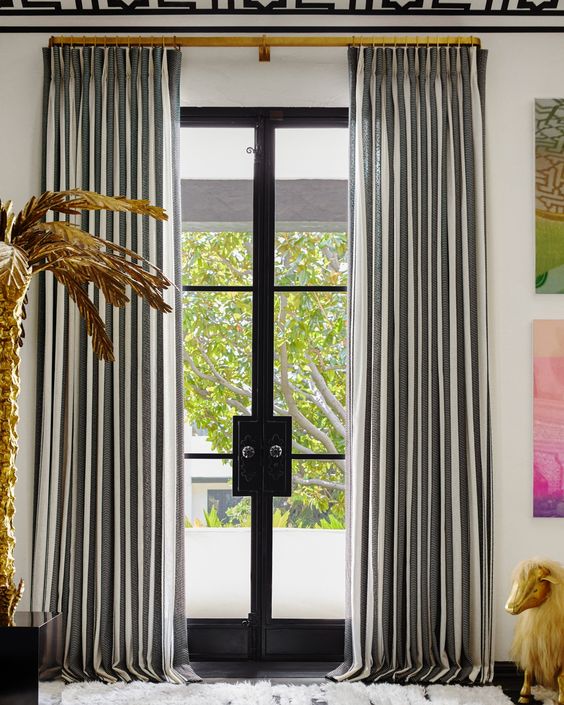
Select pleated drapes that fall uniformly or heavyweight drapes that contain multiple linings. Once hung, arrange the fabric so that it bends at the hem of each pleat, creating a neat stack of folds along the floor.
True Puddle
Finally, a true puddle will provide you with the most dramatic effect. This puddled curtain style can be achieved by extending the curtain length between 6-18 inches. Keep in mind, the longer the length, the more striking your drapery will be. Here are the different ways you can arrange a true puddle:
FLOWING PUDDLE
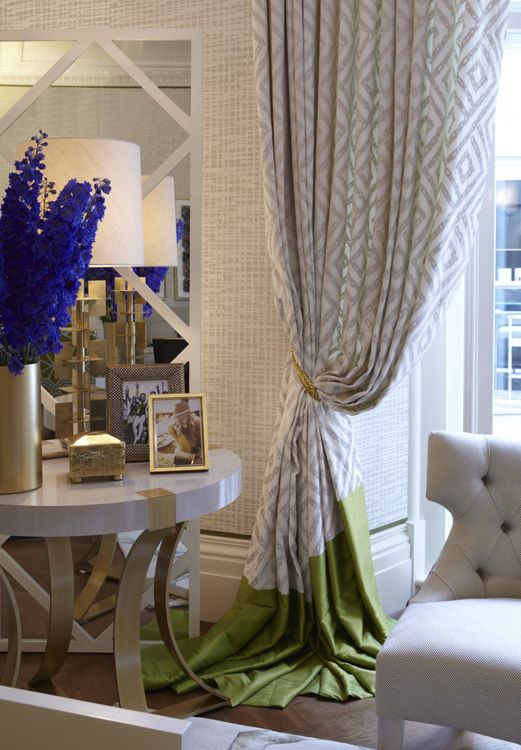
This puddle style is reminiscent of the trail of a wedding gown. It’s elegant, bold, and luxurious. To create flowing puddles, you must train your drapes to fold uniformly. Then, allow the fabric to lie naturally and flow out from the panels to create the perfect pool. The flowing puddle look is relatively easier to arrange than other methods of elaborate puddling.
FOLD-UNDER PUDDLE
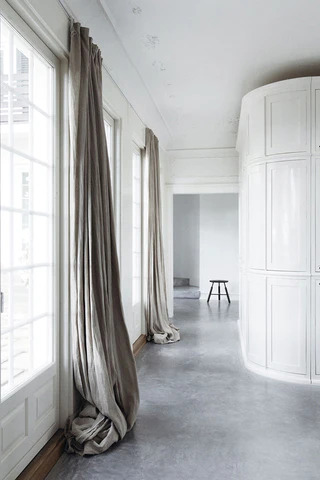
Just as the name sounds, with this style, you’ll fold the excess curtain fabric underneath itself. First, form the folds of the drapes and then fold them backward after fluffing the fabric to increase the volume. The result is a soft, cloud-like shape that provides a dreamy effect. Note that this kind of puddle requires at least 12-16 inches of extra length.
STACKED PUDDLE
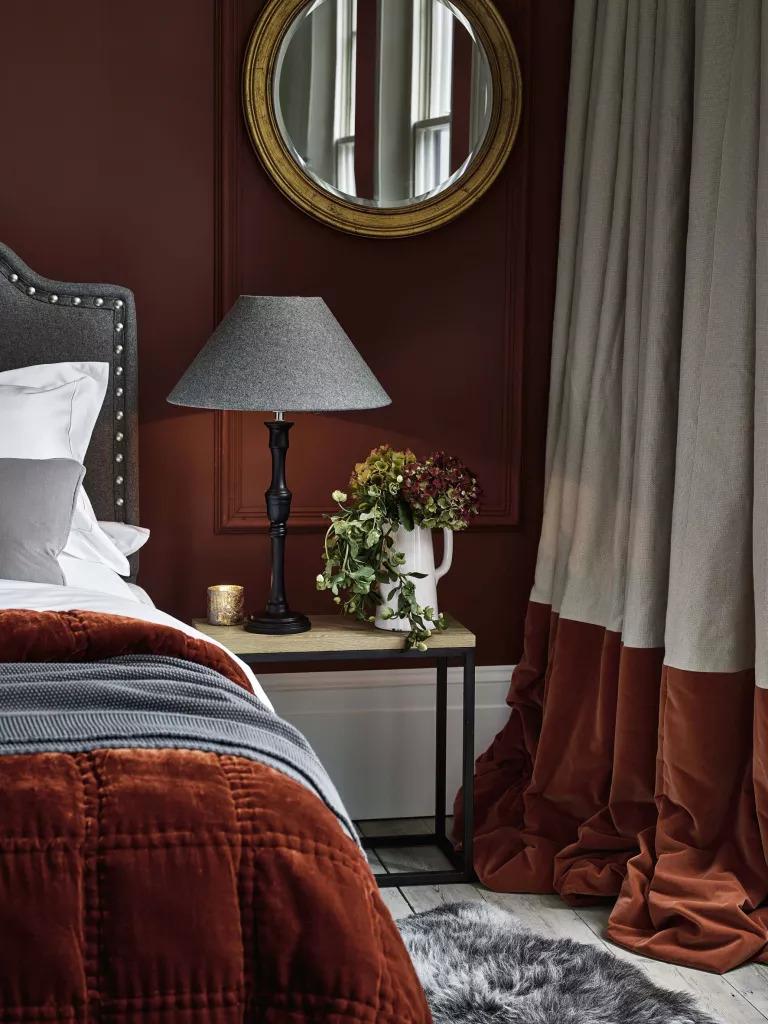
Instead of allowing the fabric to flow outwards, it will be piled vertically. To do so, lift the curtain into a fold, drop it down, and repeat, stacking the folds on top of each other. It will likely take time for your curtains to maintain this type of puddle. Just give it some time and readjust as needed. Over time, the curtains can be “trained” to retain the puddle.
READ MORE: CURTAINS VS DRAPES: WHAT’S THE DIFFERENCE?
Puddled Drapes to Match Your Décor
You know now that puddling drapes is a technique and an art that requires a dexterous hand and creative mind to etch it with perfection. As much as the style of puddling must suit your home’s functional requirements, they must also voice your decor style. And that goes beyond choosing the style of the puddle to the choice of fabric, hardware, heading style, and accessories. Let’s walk you through some of our stylists’ tips to match your puddled drapes perfectly with your personal decor style.
For a Formal Décor Setting…
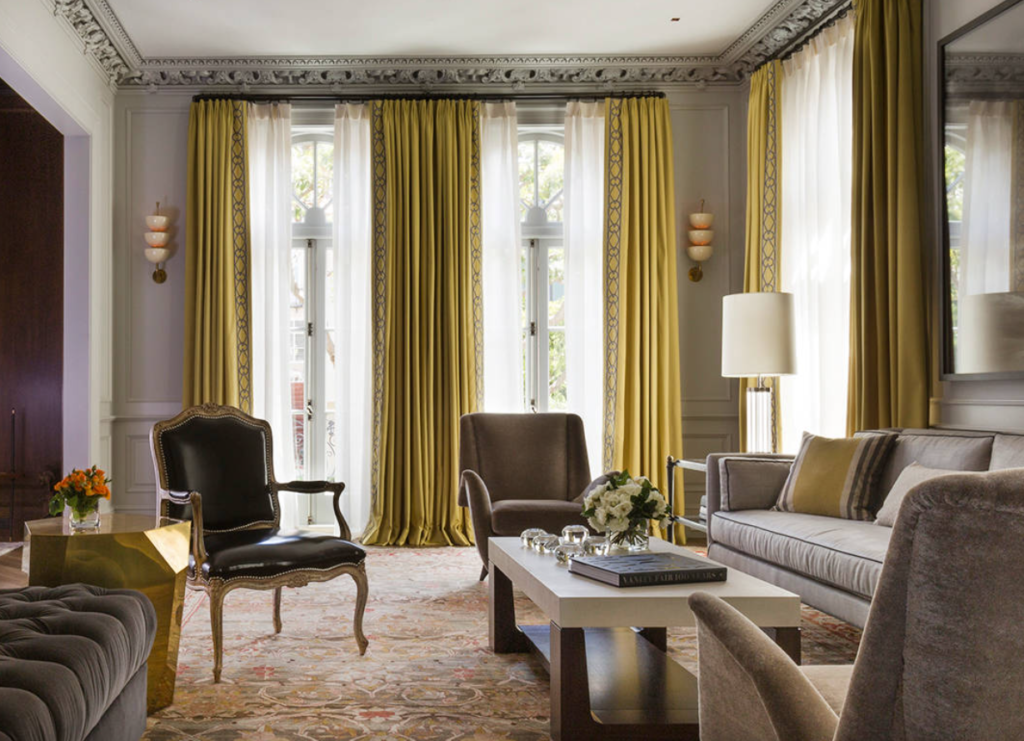
Consider dressy fabrics such as silks or velvets for spaces like the living room and dining room. The grandeur and resplendence of these fabrics marry perfectly with the opulence associated with a puddled look. The true exaggerated puddled look works best with these fabrics.
Choose statement hardware that will stand out and complement the premium look of the drapes. Consider an elaborate style of the header such as the triple pinch pleats, goblet pleats, or euro triple pleats that can offer uniform pleats for creating the most visual impact with puddled drapes.
If you want to go all-out, consider zhuzhing them up further with suitable fancy trimmings such as tassels, braids, and fringes. They will fine-finish the drapes on an exalted note and of course, get you a focal point for the space.
If however, your design style is a pared-back, simplistic one, choose to keep a tight leash and opt for any two of these ideas. For example, hang euro triple pleats silk curtains in a glamorous palette on sleek brass hardware and call it a day.
For a Casual Décor Setting…
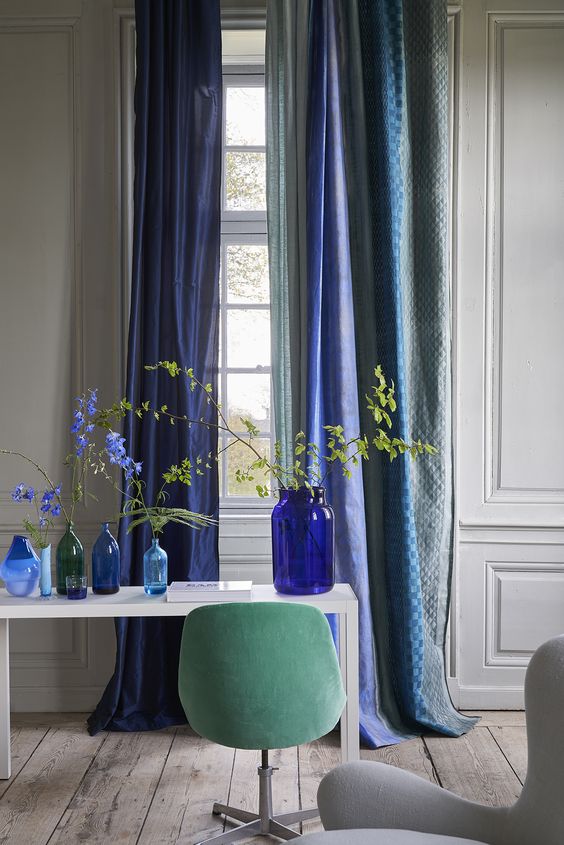
Consider laidback and lightweight fabrics such as linens, cottons, or sheers. These fabrics offer a look that’s airy and relaxed. One-inch break puddle works best with this set of fabrics.
Go for a simple heading style like flat panel tops or architectural ones like double pinch pleats, ripplefolds, or euro double pleats. These styles lend uniform folds but with a restrained indulgence in detailing.
Amp up the relaxed feel further by adding cotton pompom trims or colorful ribbon trims at the lead edges. Keep the hardware sleek and for the most minimalistic setup, opt for a palette that blends into the space rather than stand out. Alternatively, you may also go for tracks that will disappear into the architecture and keep the orientation of the decor simple and minimalistic.
SHOP NOW: CURTAIN TRIMS & TASSELS FROM SPIFFY SPOOLS
Order Custom Curtains from Spiffy Spools
Puddled curtains are not a thing of the past – they are here and forever. And with this guide, we hope you have all the information and inspiration you need to style your puddled curtains and drapes most suitably for your home. If you’re ready to dress your windows in one of these gorgeous looks, Spiffy Spools makes it easy to order custom curtains to your exact specifications. Explore our site to find the perfect options for your space in any length—and don’t hesitate to contact us with any questions!
READ MORE: HOW TO DECORATE CURTAINS: IDEAS & TIPS
How to Capture the Cozy Cottagecore Aesthetic in Your Home
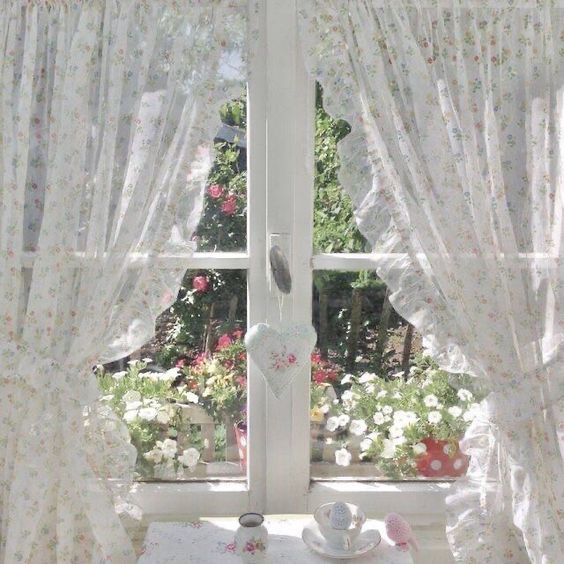
If you love subtle and gentle interior designs, then you are probably looking for ways to incorporate such elements into your home. There is an abundance of ideas online, but for ultimate coziness and a soothing atmosphere in your home, you might want to consider cottagecore aesthetic. If you are wondering what this design is and how to achieve it in your home, read on.
What is Cottagecore Aesthetic?
This trending aesthetic was inspired by an idealized version of Western farm life. The principles it has are harmony and simplicity with a dash of natural elements. This trend in interior design started popping up on Pinterest in 2018, and since then it has become one of the trendiest aesthetics and many people have started adjusting their homes to this dreamy design to shift their home decor style and create dreamy country kitchens and farmhouse style rustic chic living rooms. If you want to join the trend and enjoy serenity in your home, here is how you can do it.
Start With the Main Color
Before you start adding accessories and other elements, you need to pick the base color. The foundation of any room should stay in muted, earthy tones, such as beige, brown, pale green, and yellow. With those shades, you can create a perfect base that can easily be enriched with fun and soothing elements to provide contrast and harmony. Also, you should keep it simple with the base color since other elements are those that will provide a breath of life.
You can start by incorporating these color tones in your walls or through soft furnishings like cushion covers, bedding, custom window treatments, table runners, etc.
Decorate the Walls
Now that the base color is in place, it’s time to provide more personality to your walls. One example is picking an accent wall on which you will place the wallpaper. To truly lean into the cottagecore aesthetic, you can choose a print with plenty of field flowers organized neatly. This wallpaper design can consist of any florals that you’d like. To fill the rest of the walls, you can focus on adding some simple wall art. Since the accent wall is kind of complex, you can contrast it with a line art poster of your favorite flower, item, or any other shape of your choice. Such posters are simple and minimalist which won’t disturb the serenity of this interior design, and they will complement it with their gentle style.
Pick the Right Patterns
The cottagecore thrives on traditional and rustic patterns with a welcoming warm vibe that reflects the simplicity and natural appeal of rural life. Pick patterns like buffalo checks, houndstooth, petite florals, ginghams, and toiles, and incorporate them into your sofa covers, curtains, table runners, or upholstery. Additionally, employ lace or crochet patterns as their intricate designs add a touch of femininity and softness to the overall décor, enhancing the cozy and welcoming vibe of the cottagecore style.
SHOP NOW: CUSTOM FLORAL CURTAINS & WINDOW DRAPES FROM SPIFFY SPOOLS
Focus on Coziness
When it comes to cottagecore aesthetics, coziness is key. No matter which room you are dressing up in this design, you should make it as cozy as possible. To bump up the cozy vibes, you should focus on warm lighting, plenty of natural light, and soothing light colors. Also, make sure to add texture, too. You can do that through soft and fluffy rugs, pillows, blankets, country or farmhouse style curtains, and throws. Once you arrange such elements around the room, you will notice an instant change and will fall in love with this aesthetic.
Bring the Nature Inside
Even though this aesthetic is simple, that doesn’t mean it has to be boring. Due to its gentle colors and textures, cottagecore can seem a bit empty sometimes. That is why one of the most important elements of this design is nature. As it draws inspiration from farm life, you should bring nature inside your home to tie the whole look together. If you love houseplants, add as many as you can in each room. You can set up climbing plants on shelves and let them climb the walls to decorate the room. Other houseplants are welcome, too! You can also add flowers – from ditsy daisies and baby’s breath that blend into the room to colorful accents like lilies and orchids, whatever your taste admires. Read our blog on floral design where our stylists discuss the seven key elements of floral design to get fantastic results with your own floral arrangements.
Another way to bring nature into this design is dried flowers. You can press and dry your favorite flowers and frame them in wood frames and hang them wherever you’d like. Or make a bouquet of your favorite dried flowers and set them up on the dining table, desk, and dressers. Additionally, you can focus on natural materials for furniture, such as rustic wood and organic cotton furnishings and linen. Whatever you want to add, just think about how it can provide that touch of nature this aesthetic loves.
READ MORE: BRING NATURE HOME WITH BOTANICAL CURTAINS
To Conclude
Cottagecore aesthetic is one of the most gentle interior designs for your home. So, if you like a cozy and soothing home, you should give this aesthetic a chance. You will truly enjoy it. Incorporate this style with wooden furniture, flowers, statement cutlery, and our specialty custom curtains and roman shades. You’re sure to find yourself transferred into a dreamy abode.
READ MORE: COUNTRY CURTAINS: OLD WORLD CHARM WITH HOMELY VIBES
5 Amazing Ways to Start Decluttering Your Home
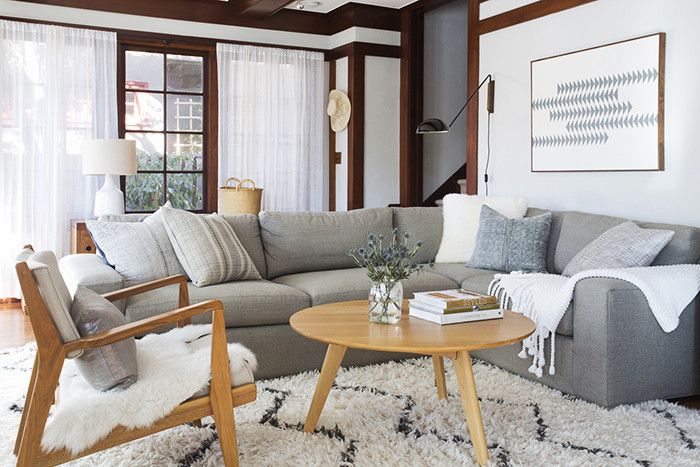
Even though it may sound easy, decluttering a home is not as simple. Over time, we tend to accumulate quite a bit of knickknack that eventually starts taking over our homes. But the worst part is that we don’t really want to say goodbye to them, even though we don’t actually either use or need them.
Every home has those areas that are perfect for storing such clutter, but the real problem arises once those areas become overfilled and all the clutter finds its way to other living spaces and common areas. So, with that in mind, here are some amazing ways you can start decluttering your home.
Understand Why It is Important to Declutter Your Home
The hardest thing is to start, but even small attempts will help you get rid of clutter. Most of us are not even aware of the negative impact all that clutter has on our mental health. Manage the initial decluttering, and it will become easier to get rid of all the unnecessary stuff.
Another problem that shows up is the dust on all the areas that were neglected while they were keeping all that good-for-nothing wealth. They are often hard to reach and now they need extra care. Luckily, you can always reach out to a deep cleaning maid service and have the professionals help you out in your time of need.
Focus on Compartments and Drawers First
Start off by removing the trash first. Take a stroll through your house with a trash bag and simply throw away all the broken and damaged stuff. This should be a quick process. After the initial stroll, we suggest doing it room by room, with containers marked as:
- Put away
- Fix or mend
- Donate
- Recycle
- Trash
Open the compartments and arrange all the stuff in them by purpose. Throw away everything you don’t need, and decide what to donate, recycle, and what you wish to fix. Do the same with drawers as they are most likely filled with various items of no use to anyone. After you sort everything out, start putting things back and organize as you go.
Decluttering small spaces gives you a quick win which will only motivate you to continue your mission.
Tackle Your Wardrobe
After you’re done with all the drawers and compartments, it’s time to move on to your wardrobe. Take all the clothes out, thoroughly clean the wardrobe, and then go through the clothes, piece by piece. This takes lots of time, but after you’re done, you’ll feel much better and will be left with more room.
Use the same system we’ve mentioned previously and make quick decisions. For sure there are clothes that don’t fit you anymore, so they should be donated. If you have any pieces that need repairs, be honest with yourself and see if the repairs are actually worth it. After you’re done with the wardrobe, arrange your clothes by season so that you can more easily find what you’re looking for.
READ MORE: CURTAINS FOR CLOSET DOORS: IDEAS & TIPS
Time for the Kitchen
Cleaning the kitchen is one thing, and although it can be challenging at times, it can’t really compare to a good kitchen declutter.
To start off, clear out your cabinets, drawers, pantry, and even the fridge. Give everything a thorough scrub and tap-dry the surfaces with a paper towel before you begin putting things back in.
Everything that’s broken, damaged, or unusable needs to go. The same applies for foods that have expired or gone bad.
Here, you can also apply the same method of recycling and donating. If you have more food than you’ll realistically be able to eat before it goes bad, you can always donate it to a local shelter. The same goes for pots and pans, tableware, plates, and utensils.
Finally, the Bathrooms
Although bathrooms can sometimes get quite hectic, they’re arguably the easiest to declutter. Simply go through your medicine cabinet and all the drawers and storage units you have, and throw away anything that’s no longer in the “best before” gap.
Go through the bottles in your bath or shower and remove everything that is empty.
READ MORE: ROMAN SHADES FOR BATHROOM: BEST IDEAS & TIPS
To Conclude…
We hope these tips help you in your decluttering journey that opens up space, making your home or small apartment look bigger. And once you’re done with all the cleaning stuff, add our custom window treatments to spruce up your home with even more newness and beauty. Our custom curtains and roman shades come with over 3000+ options so no matter what your taste and style, we have something for you. Explore our online store and shop now!
READ MORE: HOW TO DECORATE A STUDIO APARTMENT
FRENCH DOOR CURTAINS: IDEAS, PHOTOS & TIPS

French doors are stunning architectural features that add whimsy, elegance, and functional versatility to the space. Designed primarily with solid glass panes, they allow plenty of natural light into your home and are great for indoor-outdoor living. If you’re hoping to further enhance your French doors, a stunning window treatment for French Doors can accentuate their look while providing you with additional privacy when so desired. With this goal, we invite you to explore the top French door curtains ideas from our drapery stylists to help you flawlessly design your new window treatments.
Order custom curtains from Spiffy Spools online in any size for your French doors. We carry over 3,000 fabrics and patterns to pick from, so you can design them exactly to your liking!
Curtains that Make French Doors More Stunning
French doors make the room look more like a relaxing cottage, and if they are opening to a flowering garden, there’s nothing more to ask. However, since French doors do little to provide privacy, French door curtains can become an elegant insulative layer over them, making them more functional, and the room more versatile.
Know the Challenges: How French Doors Get the Better of You
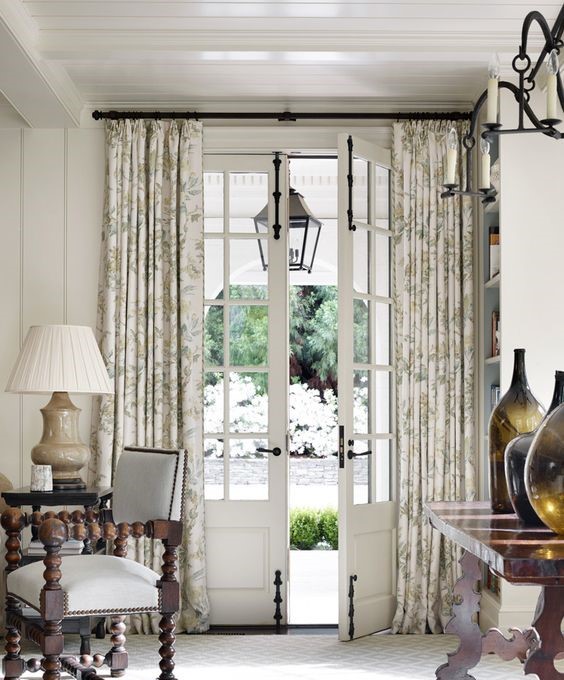
Curtains are easily the most sought-after window treatment for French doors. Drapes bring style, beauty, and softness to these grand entryways. Besides, drapery’s sumptuousness is fitting with the grandeur of the doors themselves and surprisingly lightens their enormity. However, designing curtains for these statement doors is challenging at times for various reasons, including:
- French doors are oversized, demanding wider coverage and heavier bearing on the hardware.
- Since they are glazed for the most part, French doors are infamous for loss of thermal energy, calling for more energy-efficient dressings, especially if they are located in bedrooms.
- If your French doors are room dividers, your curtains have to do double service to fit the decor of both rooms.
- Furthermore, if they swing to both sides, you must make sure that the curtains don’t hinder their two-way operability in any way.
So, let’s see how we can hang curtains on French doors in the right way, converting these challenges into design opportunities.
Have Your Strategy in Place: The Essentials of French Door Curtains
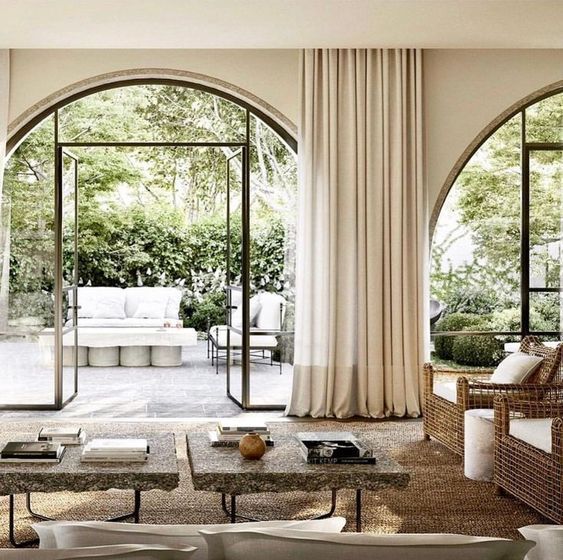
While French doors pose a different set of challenges than other doors and windows, there is no shortage of design strategies to tackle them. The journey to the right window dressing for your French doors begins with a good plan. And here’s how you lay it down:
- BEGIN WITH ‘WHY’: What makes you want a dressing for your French doors? Is it to guard the room against prying eyes or to soften the light pouring in? Or, do you want to curb the glare on the TV screen? Or, do you just want soft textiles billowing at your French doors to add charm and drama? Once you answer this question, you’ll know whether to go for a highly functional window treatment or a decorative one that simply furthers your aesthetic vision.
- SUPPORT THE ROOM’S PURPOSE: A well-dressed doorway has gone awry if it does not further the purpose of the room. So, don’t forget what activity the room is used for when designing the window treatments. Is it a grand living-dining-kitchen area opening to a garden that needs light-filtering curtains? Or, is it a cozy bedroom extending onto a balcony that needs to be quietened and darkened for good sleep? Or, is it a home office that needs acoustic and visual separation for more focused work? Your drapery choices will highly depend on the answers to these questions.
- PLACEMENT: What kind of curtains you need is also highly dependent on whether your French doors are on the external walls of the house, for example, if they are your patio doors, or serving as internal room dividers. For French doors opening to a patio, for example, the curtains have to be hardy enough to deal with a blast of sunlight, wind, and dust on a daily basis. For internal French doors, the focus may be on providing segregation, intimacy and aesthetic appeal. They must also coordinate well with the decor on both sides of the doors. The choice of fabric and the heading style will be largely influenced by this aspect.
- ROOM LAYOUT: When designing French door drapes, make sure they work well with the current layout of the room. If the passageway is a high-traffic zone connecting to other rooms, make sure that the curtains have their own space. You don’t want preposterously overbearing drapes that interfere with someone’s footsteps, causing tripping accidents. Be even more careful with your calculations if you have kids or pets.
- MIND THE STACK: If your French doors swing both ways and you want to make good use of this double functionality, make sure that your curtains are mounted correctly. Instead of letting them partially cover the doors when stacked back, ensure that they completely clear the door. You need a drapery pole that extends sufficiently on both ends and that much free wall space to hold the stacked curtains.
- INSULATION NEEDS: If you face freezing winters, know that your French doors could be notorious energy leakers that worsen the trouble. This issue is far from ignorable in bedrooms and nurseries where room temperature maintenance is imperative for good sleep and an energized day afterward. And therefore, insulative blackout curtains should be on top of your list.
- DECOR LANGUAGE: When chasing functional requirements, the curtains must not fail to rhyme with the overall decor of the space. Care must be shown when selecting the fabric, palette, pattern, texture, weave, heading style, hardware, and accessories. The curtains must speak the same decor language as the rest of the space.
Make Concrete Design Decisions: Top Tips to Design French Door Curtains
Knowing what’s ahead keeps the wise prepared to handle it. With the knowledge of the challenges involved and the apt strategies in place, you can now focus your attention on the key styling decisions. Hence, here are some top tips from our stylists to come up with your final decisions about the design details of your French door curtains:
Choose the Right Material
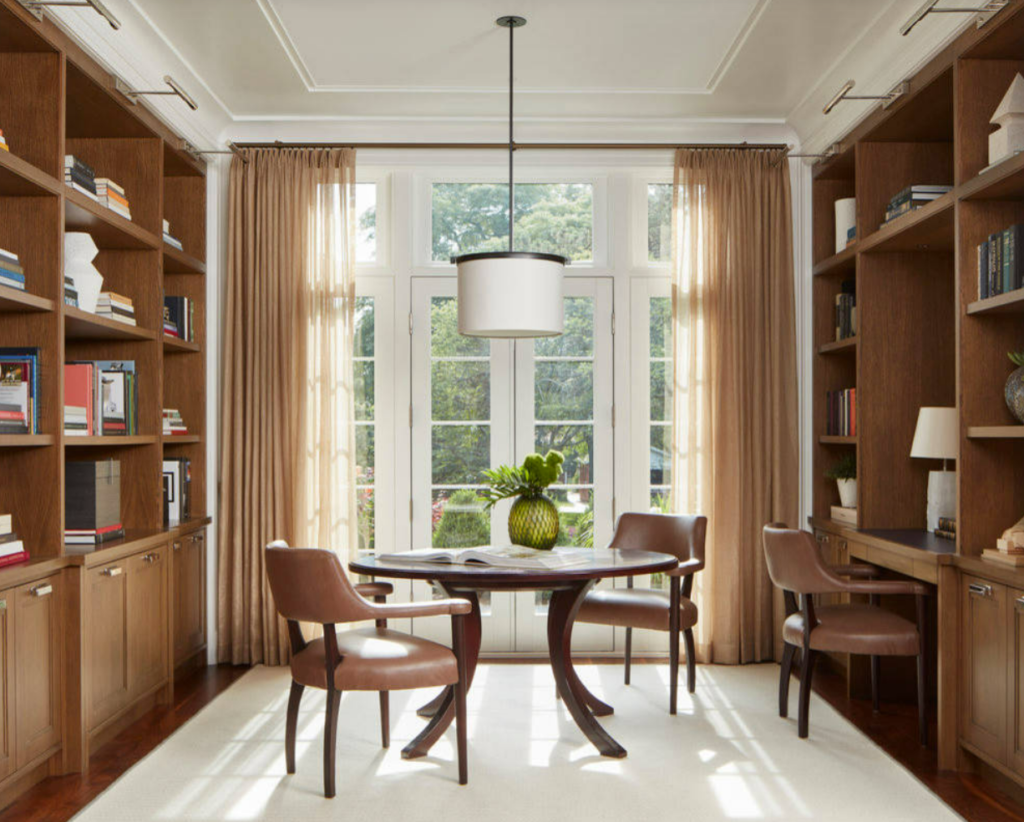
There are two decisions you need to take when selecting the fabric for your French door curtains. First, you must decide on the material composition of fabric and second, determine its level of sheerness or opacity.
If your French doors are located in an ultra-formal area, think of dressy fabrics like velvets and silks. For a pared-down version of a formal space, consider high-quality heavy cotton drapes for the sophisticated look they create. And if your French doors are in a casual area such as your kitchen, or for French patio doors in a casual living room, think of lightweight linen and cotton to move with the easygoing vibe as well as the need for more hardy materials here.
Once you’ve made up your mind about the fabric to go for, determine the level of opacity required. Opacity of curtains will have to do with the level of privacy you require and the type of light inflow needed in the room. If you want light softly filtering in through your curtains, go for sheer or semi-sheer curtains. They will provide privacy during the day and make for a pleasing ambiance – light, casual and airy.
If you need more privacy and light control, consider non-sheer drapery fabrics. With suitable lining, they can also help fight away excess heat during sunny afternoons. Consider blackout lining or blackout drapery fabrics if you need foolproof privacy, acoustic benefits, and temperature control during extreme weather conditions.
Select a Suitable Heading Style
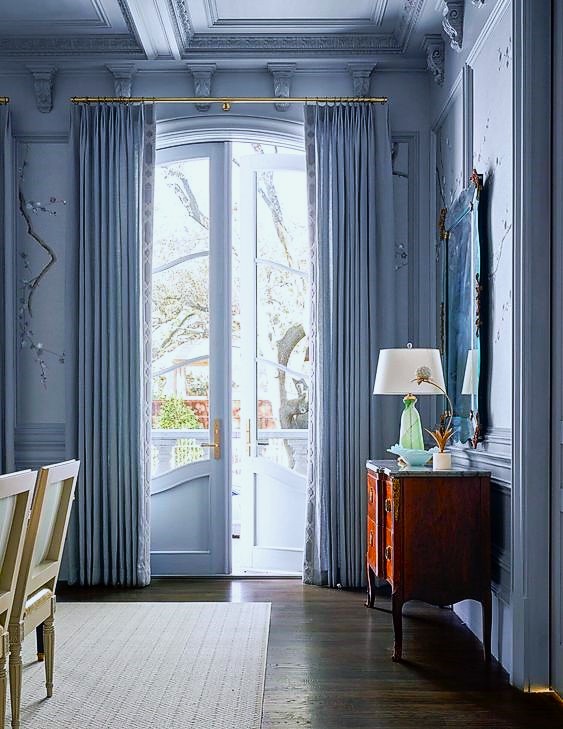
The heading style refers to the design of the curtain top header which dictates how the curtains fall and drape, and the ease with which they move on the drapery pole/track. All types of curtain heading styles look elegant, but some are more functionally efficient than others.
If your French doors open to a high-traffic space, the curtains will likely get moved often during the day. In such a case, we advise ordering curtains that operate with clips, rings, or grommets as they glide smoothly on the drapery pole. Consider any of the pinch pleats, flat panels, or grommet tops.
In case you are hanging curtains that you don’t plan to maneuver often – or would prefer for them to stay steady and not glide too easily – heading styles such as rod pockets or back tabs might be more appropriate as they don’t glide as easily and stay in place even when it’s drafty.
READ MORE: CURTAIN HEADINGS STYLE GUIDE
Consider the Rear Side View
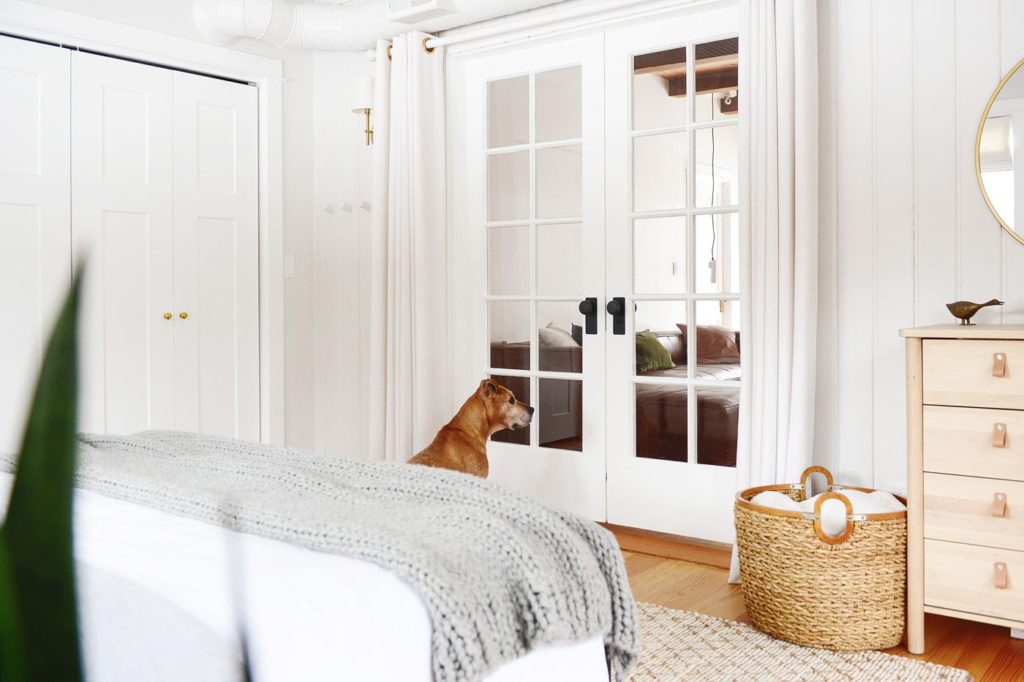
Whether it be fabric or heading style, if your French doors are room dividers, you need to ascertain whether their rear side is as presentable as their right side. Getting the curtains to work perfectly with the design of one room and mess with the decor of the other is the worst mistake one can make with glazed doors.
So, when you choose a solid-colored fabric, make sure that the color is the same on both sides. With patterned fabrics, ensure that the print shows on the other side with full saturation as on the face. Say no to embroidered drapery fabrics for all the obvious reasons.
Similarly, if you choose to line your curtains, you need to factor in the color of the lining as the visible side from the other room. Note that our privacy lining comes in white and blackout lining in grey and beige.
Heading styles also need more forethought. Think of styles with tailored pleats – how they look so adorned on the front side, but show the heading tape and hardware on the back. For room-divider French doors, it is – instead – advisable to choose heading styles that look relatively more presentable on both sides such as rod pockets, grommet tops and flat panel tops.
Note that hemlines will be visible on the back of the curtains, no matter what style of curtains you choose.
Determine Width
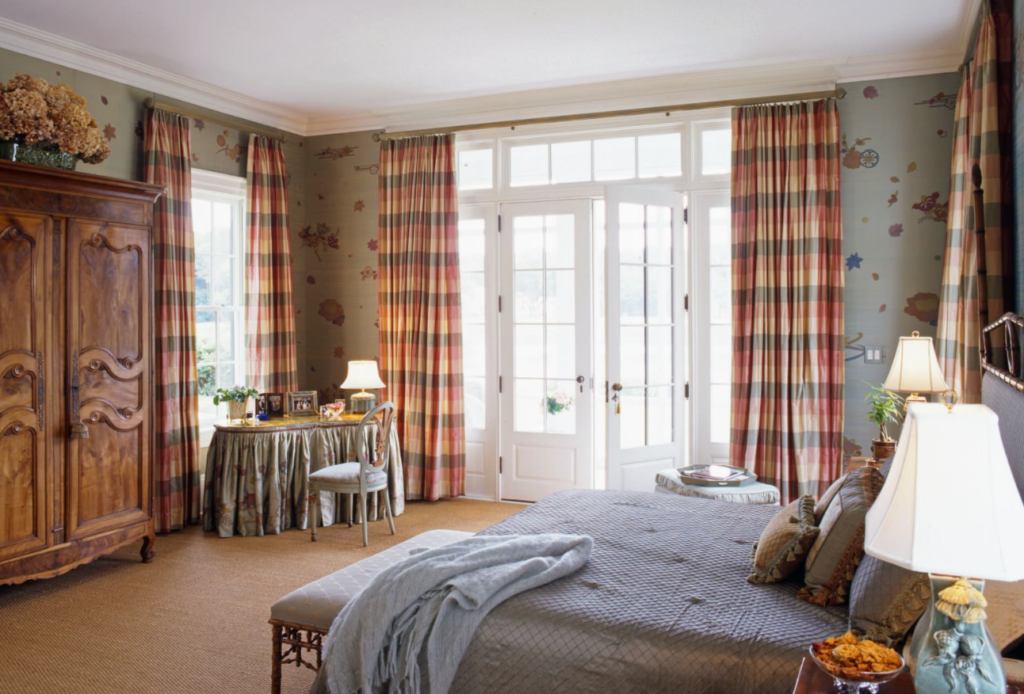
Running close in hand with the heading style is another design decision – the width of your curtains panels. The pleats of the curtains are formed beautifully only when the fabric is used generously. Increasing the width results in increasing the sumptuousness of the pleats, hence it is referred to as ‘fullness’. Also remember that if you are shopping for extra wide curtains of over 48 inches, then you can expect your drapery panels to have a join in them. With ample fullness, the joins and hems to match patterns in your drapery panels will hide in the pleats.
Curtains are typically stitched with a minimum of 1.5x fullness, that is, one and a half times the width of the window. Increasing the fullness factor to 2x or 3x will help you to create dense, dramatic, and neat folds. Since French doors are huge, and the curtains are floor-length, the curtain width should match proportionately.
Certain heading styles like pinch pleats look their very best only when stitched with maximum fullness. Whereas, heading styles that depend on fabric loops or pockets such as rod pockets and tab tops become more functionally efficient when stitched with moderate fullness.
Increasing curtain width is a smart idea, especially for sheer curtains. Dense and closely placed pleats will multiply layers of the transparent fabric and thus provide maximum privacy. Sheer or non-sheer, increasing the fullness always adds to the insulation, sound absorption, and light control capacity of the curtains.
On the contrary, if you’re not looking for fully functional drapes covering your entire french door, you must reduce the width. Narrow decorative drapes can flank the doors and frame the views with their rippled contour, adding a splash of color in the process. These curtains are hung on short drapery poles so they remain stationary at the two ends of the doorpost.
Choose the Number of Panels

Once you have determined the fullness level of the curtains, you can then decide on the number of panels to be ordered. So, if the window width is 100” and you have decided to go for 2x fullness, the curtain’s width must be 200”. Now, if you need a pair of curtains, they must each be 100” wide.
Sometimes, you may lack wall space on one side of the French doors to provide stacking space. If you mind the curtain taking away space from the window, it is a situation that invites a single-panel curtain. With a show-worthy tie-back, the curtain’s gorgeous pleats and swags will stand out adorning the dreamy doors with impressive fullness and glamor.
In some homes, French doors are enveloped in a series of French windows, differentiated only by their length. Here, it is better to treat the entire series with multiple panels of floor-length curtains. But ensure that a pair of curtains are designated for the span of the French doors so that it is easy to operate them separately when needed.
Invest in the Right Hardware and Position it Correctly
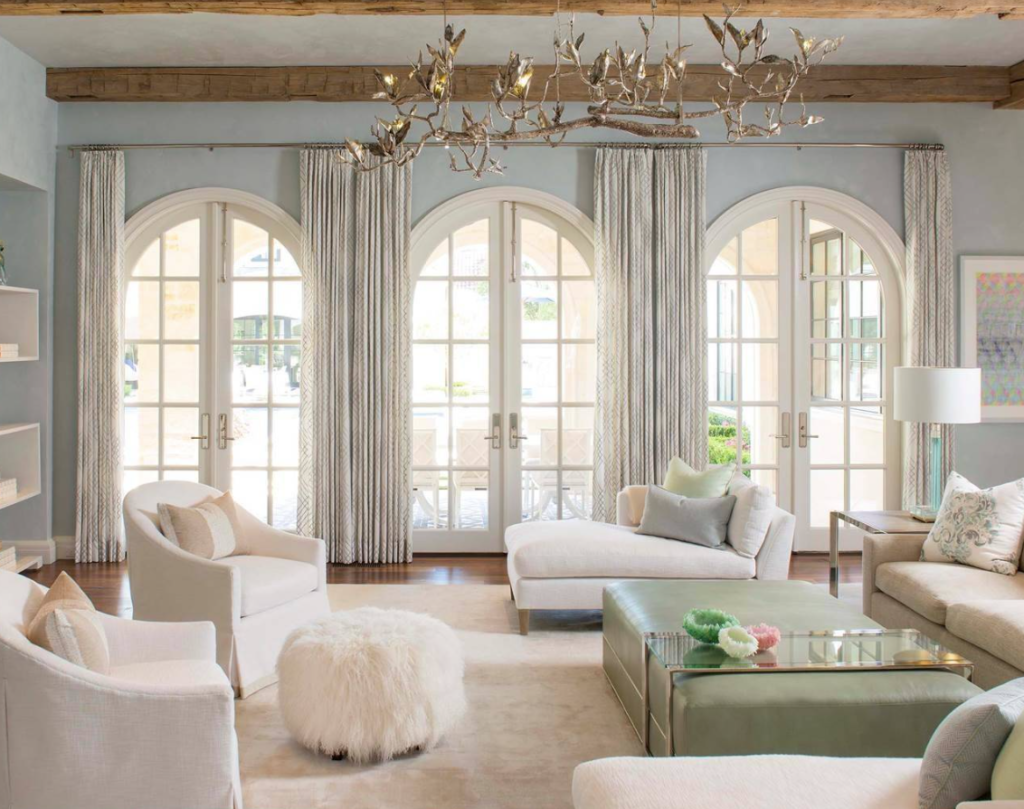
It is important to install sturdy hardware for French doors since the curtains can be very heavy, considering the dimensions they span. Hence, go for high-quality hardware and they typically comprise two choices: poles and tracks.
Curtain Rod Considerations
The most popular and traditional hardware for hanging curtains is drapery poles. They are usually made of wood, metal, or plastic and are available in various colors and finishes. Their ornamental knobs on the ends – known as finials – come in a wide range of finishes and colors too.
If you’d like to hang your curtains on a curtain rod, consider the following tips:
- Avoid tension rods, because French doors do not have the correct frame to place them.
- You may need an extra-long curtain rod to cover the total span of the two doors.
- A double curtain rod is a great choice if you plan to layer your window treatments.
Curtain Track Considerations
Curtain tracks are a more modern option and come with many advantages. They can be mounted to the wall above the door or, as is the most popular choice, to the ceiling. When placed on the ceiling, they render a very seamless look as there’s no gap between the ceiling and the curtains. It goes without saying that this arrangement better suits floor-to-ceiling drapes.
Tracks that come with pull cords are easy to operate as at the pulling of the string, both curtain panels operate simultaneously. They can blend into the wall if planned along with the architecture or be placed behind valances or pelmets. Tracks suit modern, pared-back design styles.
If you’d like to hang your curtains on a curtain track, consider the following tips:
- Curtain Track: Use one, extra-long curtain track to cover the total span of the two doors.
- Choose a Suitable Curtain Style: Curtains that go on tracks are pinch pleats, flat-panel tops, inverted box pleats, ripple folds, and pencil pleats. The ripple fold curtains need a special mention here as they operate on specialty hardware that is uniquely designed for them. So, it may be wise to order the hardware before you shop ripplefolds and if you already have ordinary tracks installed, you may avoid this style.
Whether you decide to go with a curtain rod or track, here are some tips to maximize their functional efficiency:
- Extend the rod/track at least ten inches beyond both sides of your French doors. Doing so will allow you to move your curtains out of the way of your French doors when in use.
- If you’re planning on hanging a valance above the curtains, factor in their length when positioning the drapery hardware. If your doors swing both ways, you need to ensure that the valance does not come in their way, so place the hardware high enough to accommodate the valance above the doors.
Consider Door Mounted Curtains
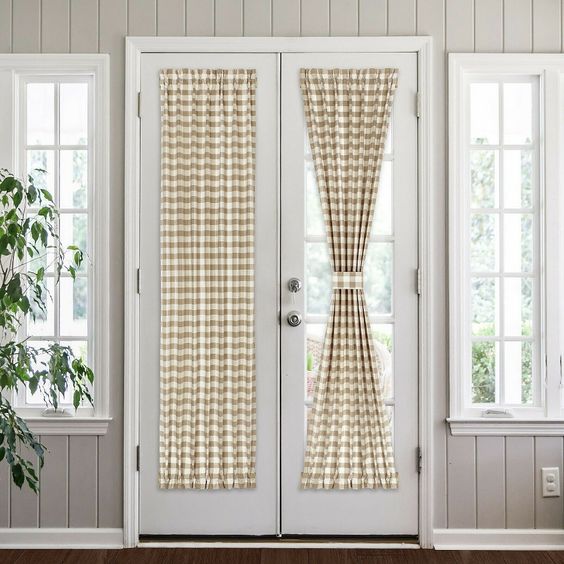
The hardware and heading style options we described above are meant for full-fledged curtains that are common to all styles of doors and windows. But there is a style of window curtain that is specifically designed for French doors.
French door curtains, as they are called, are affixed to the door panels to custom fit the glass portions, providing just the right amount of coverage that is required. They are hung on sash rods that are specifically designed to be fixed to the door panels. They are sleek and come in pairs so they can be affixed to the top and bottom of the door.
The french door curtains have pockets on both ends which explains their other name – double rod pocket curtains. The curtains are held tightly to the doors as they are attached to the rods at the top and bottom. So, they never billow or move away from the position at which they are fixed. When you want to let light in, you can stack the curtains on a side and pull them back in position when you want privacy.
Since the curtains are mounted onto doors, they are typically stitched with lower fullness than standard curtains, just right to fit the frames with tiny ruffles formed by the gathering of the fabric. Increasing their fullness will challenge their efficiency as it will become difficult to move them on the rods.
Since the curtain panels are affixed to the doors themselves, they move along with the doors. Furthermore, they do not ever pose any constriction on the door’s opening – swing them forward or backward and the curtains never come in the way. Since the fabric engagement is very meager, they are also quite economical and easy to maintain.
The downside of door mounted curtains is that a part of your view will always be blocked, and light leaks are possible from the edges, causing inconvenience if the room needs total light blocking.
Double rod pocket curtains are ideal for your French doors if you have no wall space on both sides to provide stacking room for full-fledged curtains. They are also very minimal and sleek, offering compatible options for homes designed in line with modern minimalism. Besides, your toddlers and pets are safe from tripping while they romp around the doors. The bonus point is that the doors are easily accessible – you don’t have to move aside the curtains each time you attempt to access the doors.
Use Curtain Tie Backs
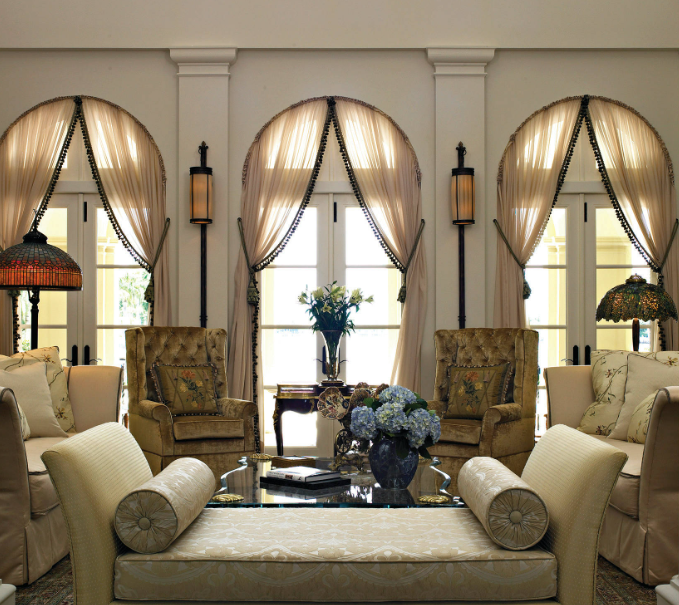
Curtain tie backs are a huge help when it comes to your French door curtains. These add-ons beautifully hold your curtains away from the panes to provide you with easy access to your doors whenever you need to use them. Plus, at Spiffy Spools, you can design them in the same fabric as your curtains for a clean, cohesive look.
Featured Looks
Spotlight On: Snazz
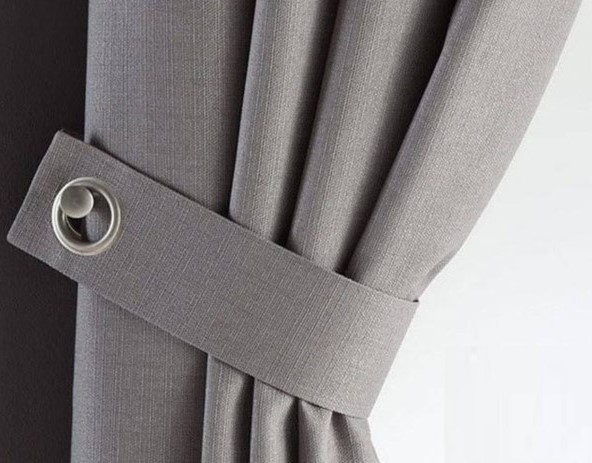
Our Snazz tie backs feature a silver, cylinder hook and a large silver eyelet. The eyelet is attached to a minimalistic, rectangular piece of fabric of your choosing, offering a sleek design. If you’re going for a modern look, Snazz tie backs are a perfect choice.
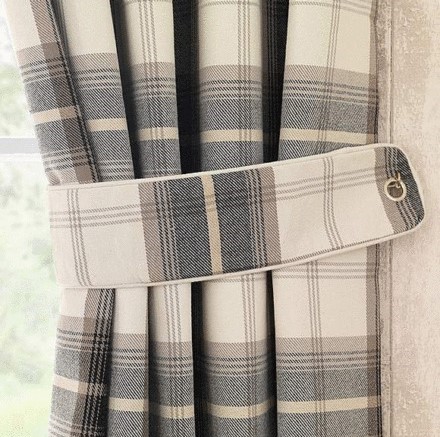
For a more casual option, select our Pizzazz style tie backs. A small eyelet attaches to a thin, metal hook, and the fabric features a rectangular cut with rounded edges for a relaxed feel.
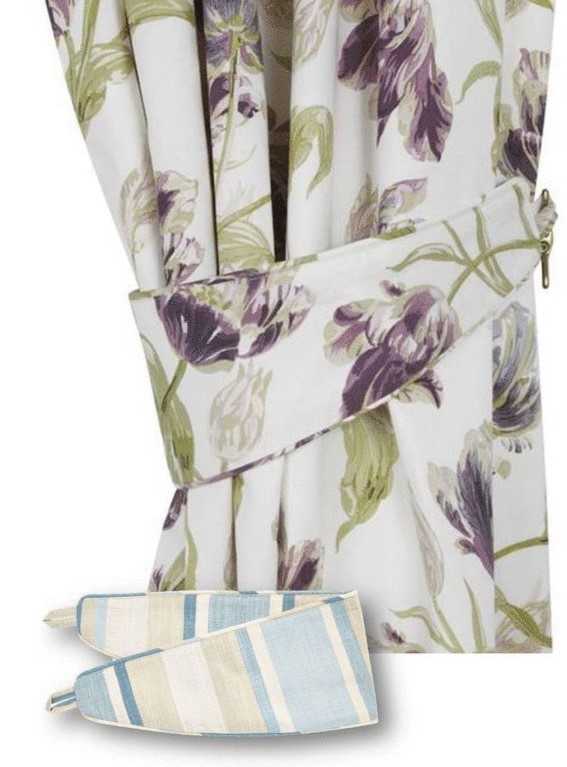
With this option, a sweeping piece of fabric with a thinly woven loop connects to a small cleat attached to the wall. Razzmatazz tie back hardware blends in seamlessly with your drapery for a refined look.
INSPIRATION CORNER
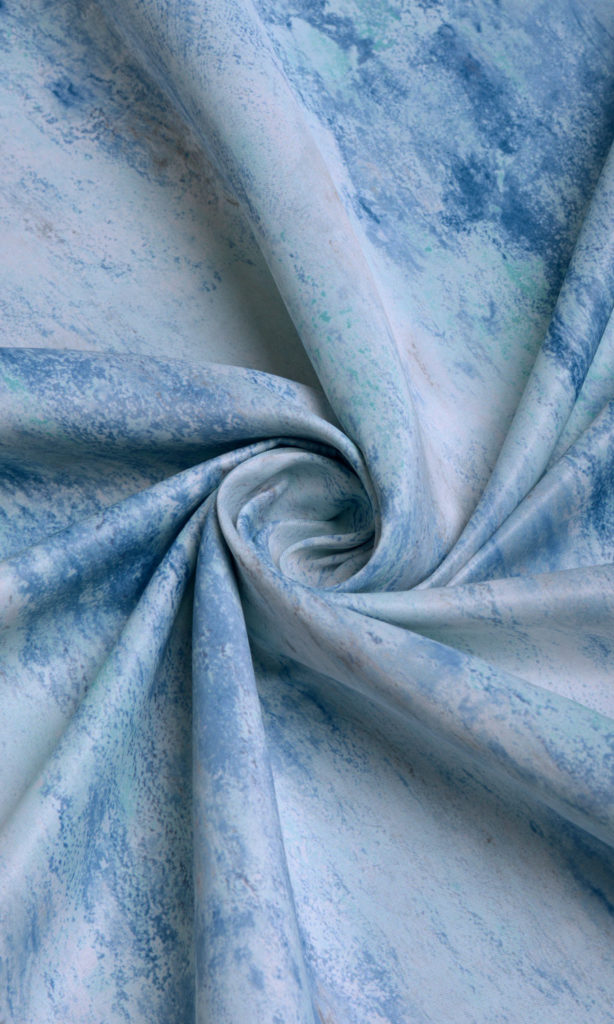
Blackout curtains aren’t drab! Take, for instance, these Morocco curtains. They feature a marbled pattern in various shades of blue for a relaxed yet sophisticated look. Morocco curtains are sure to bring a tranquil feel to your space!
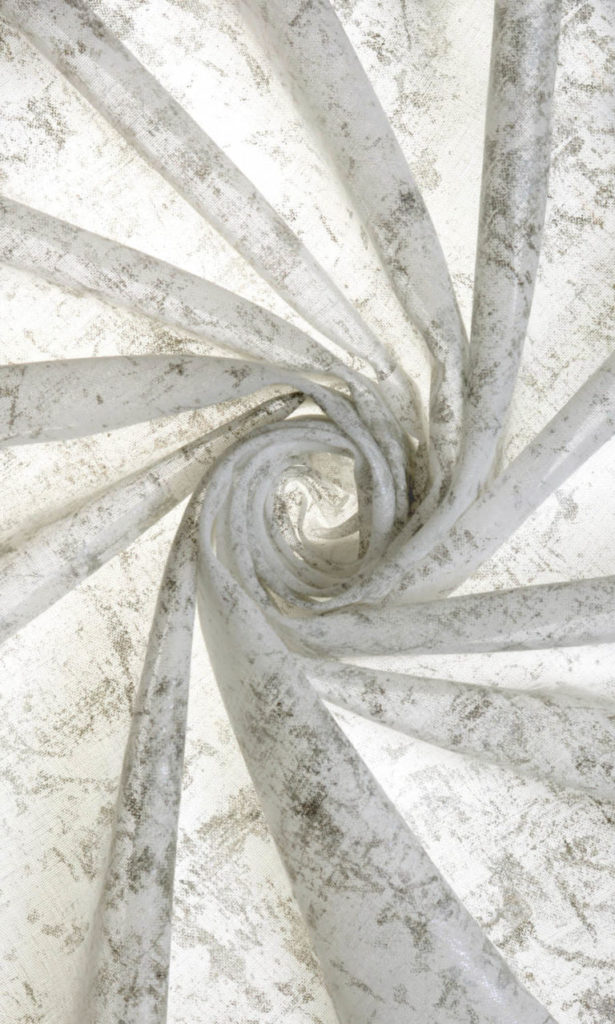
Our sheer Aklamak curtains are the epitome of elegance. Their white backdrop is dashed with a shimmery silver metallic to further add to the sophistication of the fabric. If you’re aiming for a striking and refined look, these curtains are a perfect choice.
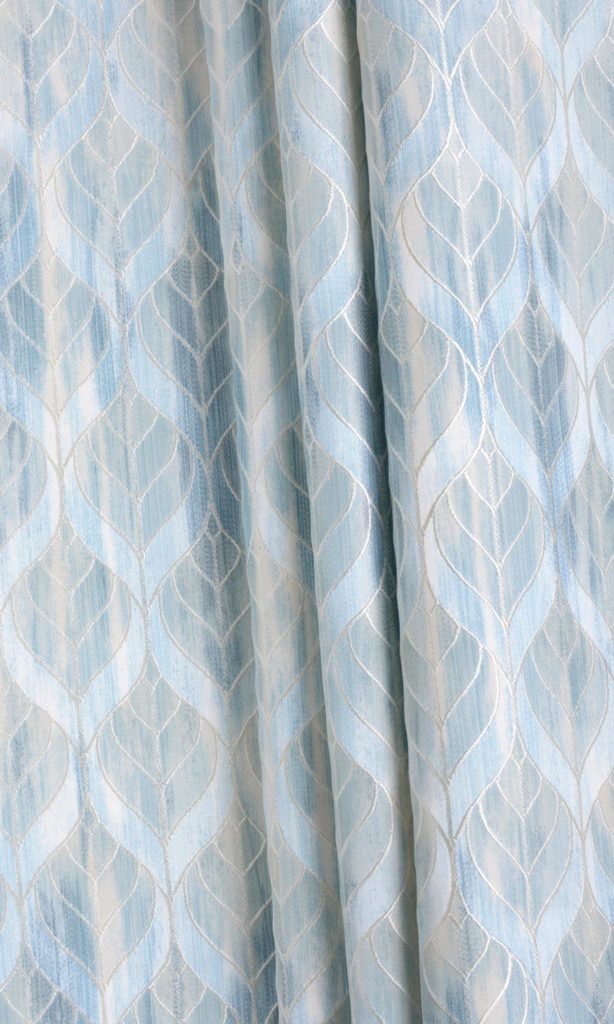
Floral and botanical motifs are quite the way to dress up your french doors, especially when they open to a patio. With a continuous layout of leaf silhouettes on a melange of greys and blues, Rhine Blue fabric curtains look like a cut-out from a cloudy evening sky about to burst with showers.
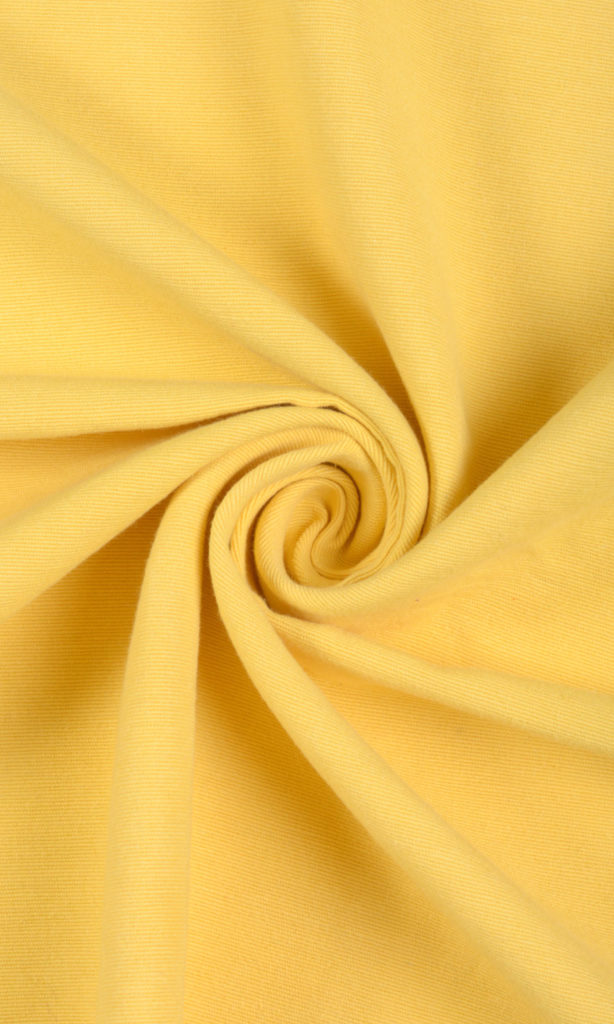
Simplicity rules with our Yamini Sol fabric that adds a bright touch to your rooms. These curtains can become your accent feature and pull together the entire color scheme of the room being used for a large element like french doors.
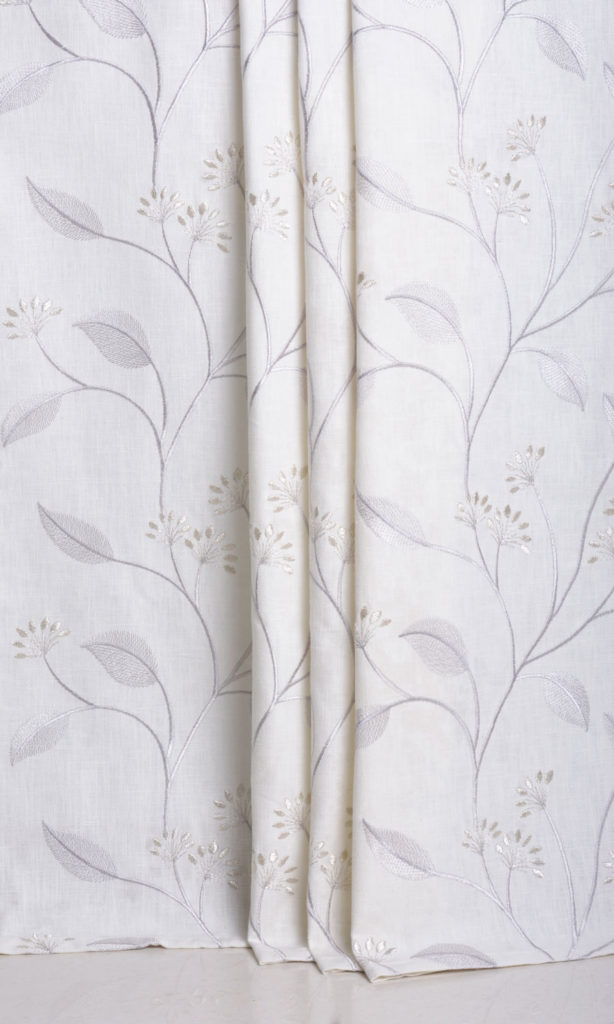
Speaking more with few words, this white drapery fabric presents floral motifs with subtle contrasts and artistic finesse, perfect as French door curtains which blur in the outside naturescape with indoors. Leaves and blooms on slender stalks are embroidered delicately in tones of white in Gypsy Queen to give off the sophisticated flair of the nature theme impressively.
Order Custom Curtains from Spiffy Spools
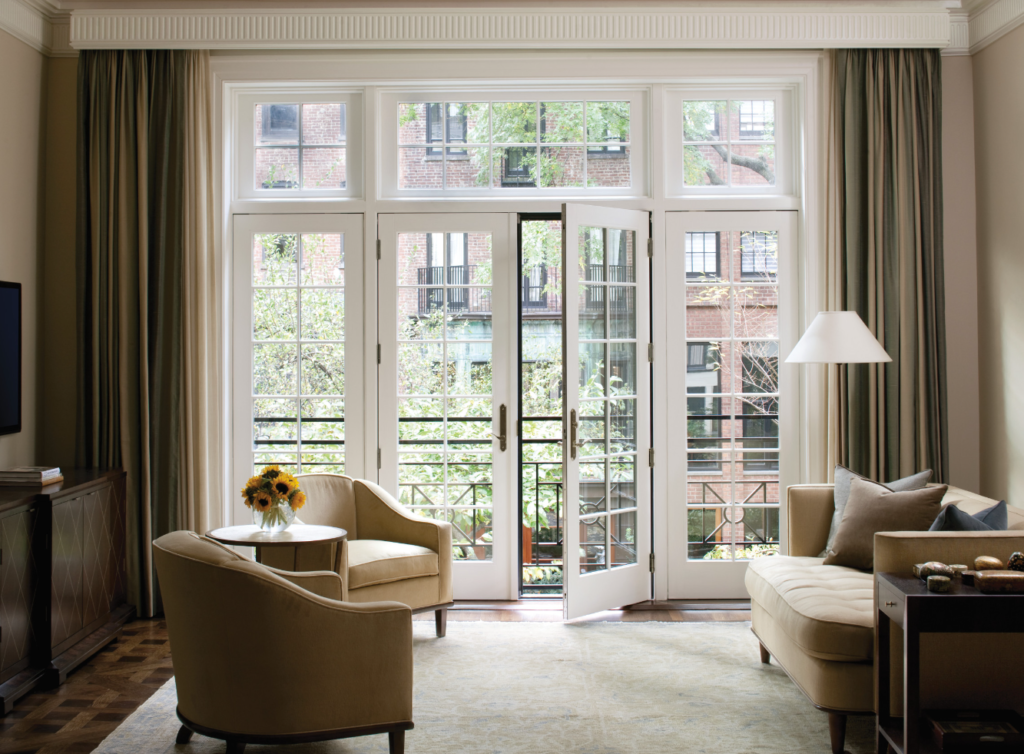
We hope these French door curtain tips have helped you with ideas for your home. And now you can confidently design your French door curtains that befit the grandeur and whimsy of this gorgeous entry point.
Browse our collections for more inspiration and be spoiled for choice with fabrics, colors, and patterns that can tune in with varied design styles. At Spiffy Spools, whether you need extra large curtains for wide windows or extra long drapes for your huge French doors, we make it easy to create custom curtains with customized measurement options, helping you dress your windows and doors to their exact dimensions. Explore our site to find stunning options, and don’t hesitate to contact us with any questions!
READ MORE: ROMAN SHADES FOR FRENCH DOORS
WHAT IS THE BEST FABRIC FOR CURTAINS & DRAPES?
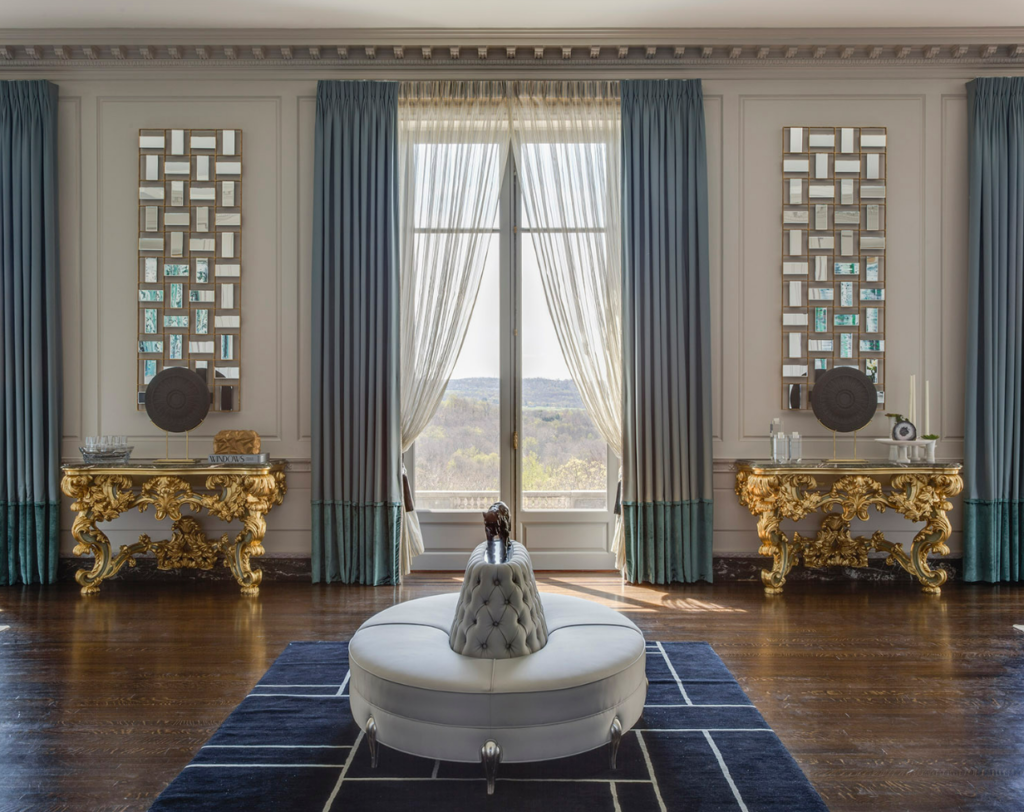
One of the top reasons homeowners opt for curtains is their vast scope of customization – the type of fabric to begin with. From regal silks to cozy linens, the choice spectrum is endlessly expansive. While being able to choose the fabric is empowering, the responsibility to make the right choice solely falls on the homeowner.
If you’ve decided to adorn your windows with curtains and drapes, one of the first questions that’ll hit you is, ‘What’s the best fabric for curtains?’ Each yarn and weave has unique traits and blended yarns give nuances to their functionality. So, how can you find out the best drapery fabric for your home? If you’re tenaciously foraging for the answers, this blog post might be your one-stop guide.
Order custom curtains and drapes from Spiffy Spools online in any size. Pick from over 3,000 fabrics and patterns!
Qualities of a Good Drapery Fabric
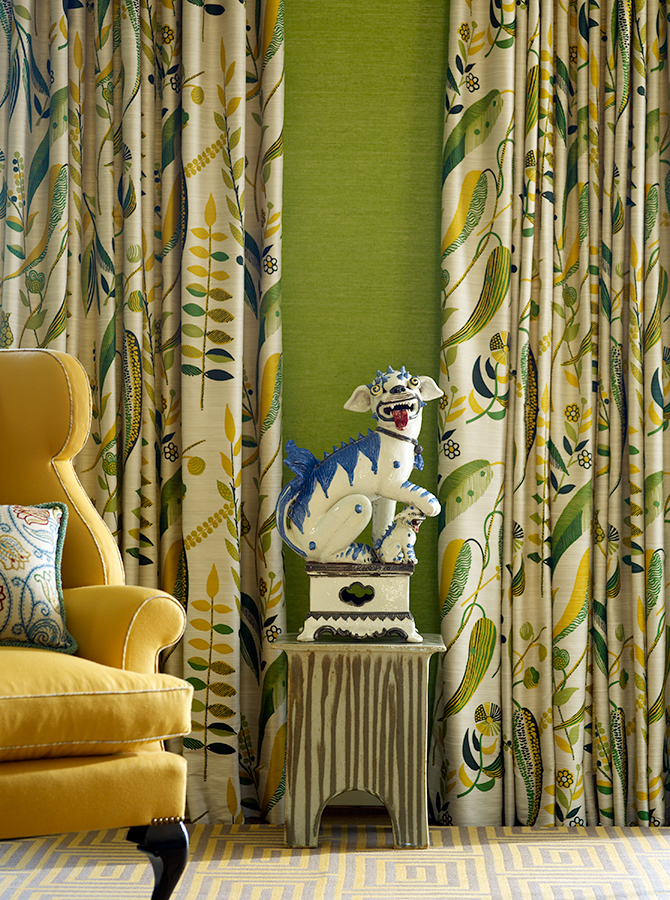
While all fabrics have qualities we may like or dislike, it is important to distinguish drapery fabrics from the rest. These fabrics are designed to ‘drape’ well and meet the needs of window coverings. What defines a fabric as a good drapery fabric are these five must-have qualities:
- DRAPABILITY: The first and foremost quality a drapery fabric needs is the capacity to be draped. Two factors that determine the drapability of a fabric are its weight and flexibility. As compared to light flimsy fabrics, heavy-weight fabrics drape better as they can hold the pleats in their place, retain creases, and fall straight down due to their own weight. The flexibility/softness of the fabric is related to the flexibility of the fiber, the thread count, and the weave. If the cloth is too stiff, it cannot be bent at the desired intervals to form the pleats. Since the beauty of curtains lies in their sumptuous pleats and free-flowing shapes, the pliability of the fabric is key to a good drapery fabric.
- DURABILITY: No one buys curtains with every passing year; they are usually meant to last a lifetime. So, durability is an inevitable factor, no matter how gauzy or dense the fabric you select. Aside from the usual wear and tear, the curtains must be able to withstand sunlight, winds, humidity, and routine cleaning cycles with endurance.
- NON-STRETCHABILITY: The curtains must retain their tailored shape for their lifetime. You don’t want them to droop with protruding edges at the bottom or slump from the drapery pole miserably. Hence, you need to select fabrics with low elasticity and high dimensional stability.
- SHRINK RESISTANCE: Being able to find or stitch curtains to stop at the exact drop you wish to achieve is in itself a challenge. And then, what if they shrink, rendering your meticulous styling wasteful and jeopardizing the look of the room? Drapery fabrics must ideally be pre-shrunk, and resist shrinking when exposed to water and moisture. Otherwise, with the first wash, you’ll find your curtains getting shorter, unless you dry-clean them.
- COLOR FASTNESS: Curtains are an incredibly reliable medium to highlight your color palette and overall decor style. But, if your fabric is not colorfast, you’ll find in due time that they mismatch your room’s decor, and how heartbreaking that would be! Besides, if they appear washed out instead of their original high-saturated finish, they may not suit decor styles that feature polished finishes. So, look out for fabrics that retain their charm and color when faced with the blinding sun and its scorching heat.
Any fabric that fares well in the above-mentioned aspects qualifies as a good drapery fabric. Depending on the climate, the purpose of the room, aesthetic preferences, and other factors, you might also want to look out for these bonus attributes:
- BREATHABILITY: Window treatments are meant to regulate light and provide privacy. They should not in any way oppose the window’s function of providing an outlet for odors and an inlet for fresh air. Hence, it is important to find breathable fabrics that allow air circulation even when the curtains are drawn. So the moisture, gasses and odors that are generated within the house find their way out, and fresh air trickles in continuously. This is especially important in small spaces that can get stuffy very quickly.
- QUICK-DRYING: If you plan to wash your curtains in water, it is important to find drapery fabrics that dry fast. It is especially required for curtains in kitchens, bathrooms, and laundry rooms as they are highly humid, and accidental splashes are not uncommon here. Fast-drying enables the curtains to resist mold formation and shrinking and stretching when exposed to moisture often.
- TEXTURAL RICHNESS: If you want your curtains to convey a feeling of coziness, warmth, and luxury, ensure that they are multi-dimensional and tactile to the touch. A flat surface gives off a cold appeal while a texturally rich finish comes across as a thoughtfully laid-out detail that dramatizes the play of light and shadow in minuscule scales. If you do not want to introduce patterns through your drapes, make sure you don’t miss on bringing textural variety as they evoke interest with subtlety.
As you went through this list, you might have realized that selecting the right drapery fabric is as much about getting the best base materials as getting the fondest palette or patterns. Don’t fret though, because many fabrics that you see in drapery fabric stores fulfill these prerequisites. But, each fabric fares on the various parameters detailed above with varying degrees, making them more suitable to certain spaces, locales, and purposes. Hence, we will now evaluate each fabric for you based on the parameters laid out for good drapery fabrics.
Evaluating Drapery Fabrics on Well-Defined Parameters
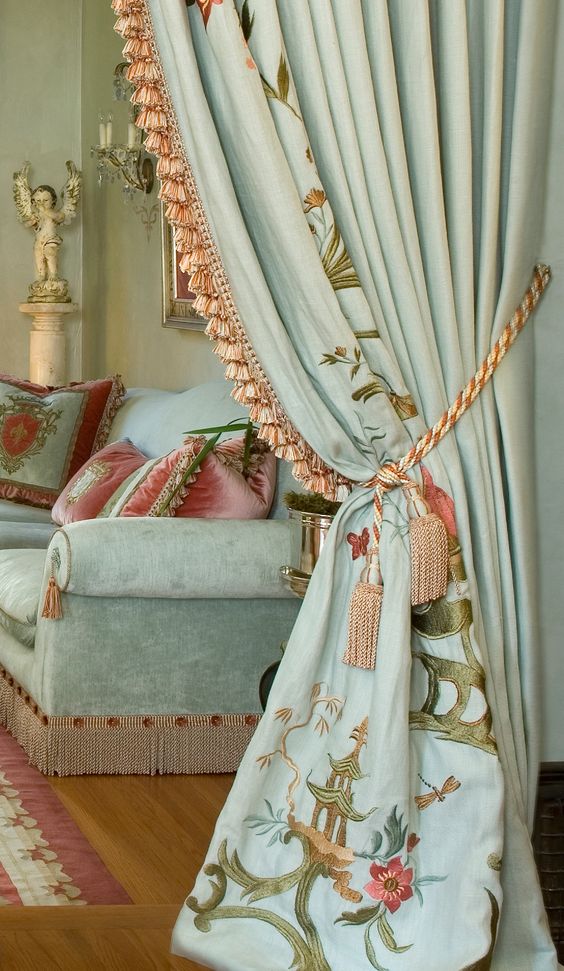
Drapery fabrics speak to the style of your home – its architecture, decor style and overall feel. Once you finalize the fabric, you can dress the curtains up or down depending on the kind of vibe you’re aiming to forge. So, let’s evaluate each of the drapery fabrics based on the qualities that make them a good fit for drapery.
COTTON
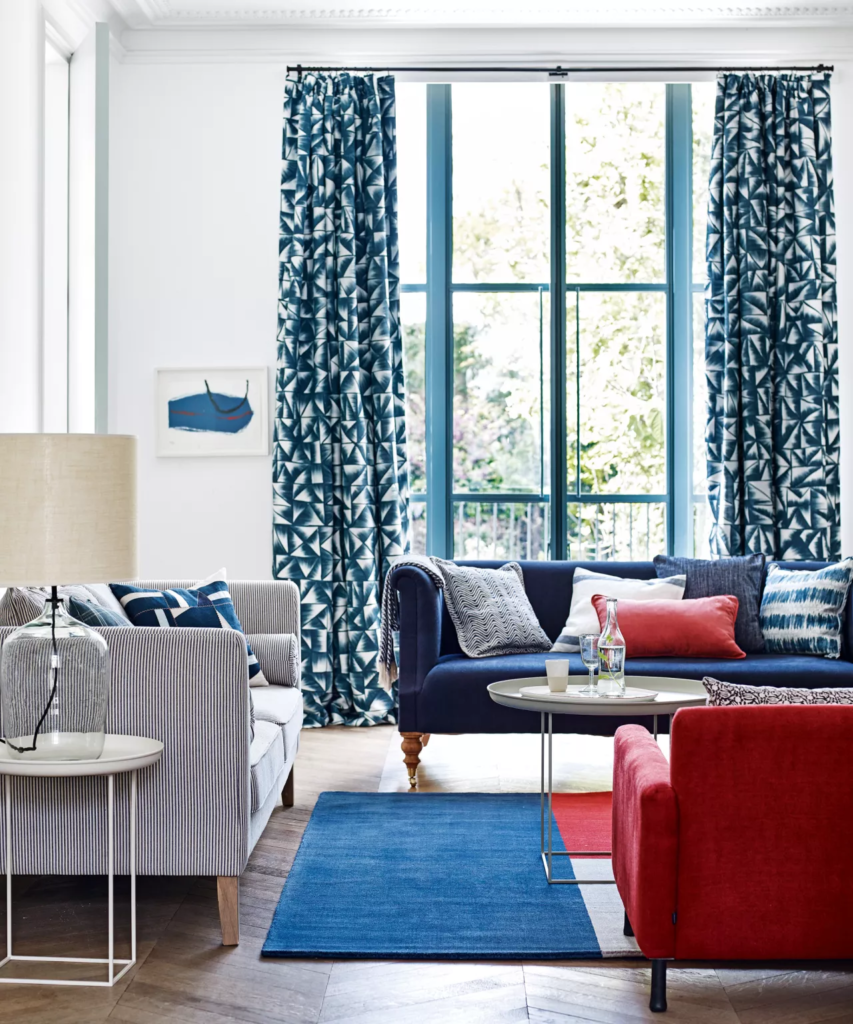
Made from the seedpods of cotton plants, cotton comes in various types of weave and is one of the most popular curtain fabrics worldwide. Cotton voile, muslin, and organdy are some of the semi-transparent cotton fabrics used for curtains. The non-sheer category includes cotton fabrics like chambray, canvas, twill cotton, cotton duck, sateen, calico, velveteen, and corduroy.
Cotton fabric is natural, breathable, and hypoallergenic – making it one of the best finds for the sustainability-conscious and chemical-sensitive. They can last a lifetime and hold their shape forever, just as they did when they were new. Unless the label mentions dry-clean as the only option, most cotton curtains can be washed at home or just vacuum cleaned.
Cotton curtains and drapes are suitable for semi-formal and casual settings. Whether you want a textured or polished finish, in solids or patterns, cotton can satisfy your wishlist and be dressed up or down depending on your decor style.
Pure cotton curtains, however, should be backed with suitable lining for it is not colorfast, and bright colors are especially prone to fade under the direct sun after long use. Also, it is advisable to pick a medium to heavy-weight cotton for the best drape and tailored finish.
SHOP NOW: CUSTOM COTTON CURTAINS & WINDOW DRAPES
LINEN
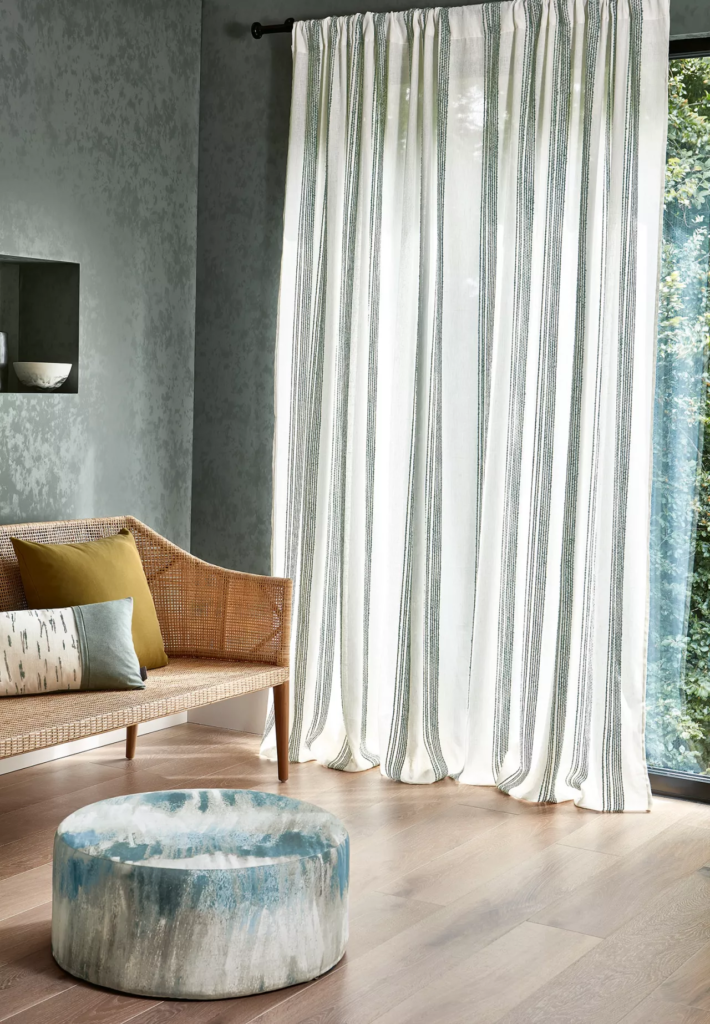
Second, on our list is another popular natural fabric – linen – made of flax plant fiber. It is also breathable, hypoallergenic, and biodegradable. And it is not just durable but also, surprisingly, gets softer with age and every wash.
Linen comes in various types of weaves, both in solids as well as patterns. Loose-woven linen curtains are ideal for light-filtering and even the tight-knit ones don’t block light altogether. Both, tight-knit and loose-knit linen curtains help to keep the home fresh as they allow air circulation.
Linen curtains require no professional help to be maintained. They can be machine-washed and ironed at home unless specified for ‘dry clean only’ in the product details. Those who don’t particularly enjoy the chore of ironing their drapes can celebrate linen’s wrinkled texture as well as their laziness. In fact, that crumpled look is linen’s biggest and most unique asset.
Linen is most loved for its slubby weave, rich textured finish, and natural crinkliness. Its lived-in feel makes for a relaxing addition to any casual space, especially in kitchens and bedrooms where linen dominates in the sheets, tea towels, and sleepwear.
However, pure linen does not work as the best choice for curtains in some situations. It is highly absorbent and loses its dimensional stability when it comes into contact with moisture. It may stretch when wet and shrink when dry, making the finished length of the curtains unpredictable in moisture-prone spaces. The solution is to go for linen blends or puddle your curtains so that this difference in length will go unnoticed.
Linen can shed color mildly when exposed to strong sunlight for very long. But the effect is almost hard to notice on light-colored ones; in fact, white linen gets more sparkly and refined when exposed to the sun.
Responsiveness to nature and roll-out-of-bed looks of linen may antagonize some but they are impressive finds for wabi-sabi fans who integrate that natural beauty into their home’s design with forethought. Linen curtains are a classic choice and blend well with traditional and contemporary decor styles.
SHOP NOW: CUSTOM LINEN CURTAINS & WINDOW DRAPES
POLYESTER

Polyester is made of synthetic fibers, usually processed from petroleum. Compared to most natural fabrics, it is lightweight, durable, and economical. It is a quick-drying fabric that can be easily washed and maintained at home.
High-quality polyesters hold their structure well and neither stretch nor shrink when exposed to water or moisture. Their colorfastness enables them to look fresh even after long use and repeated cleaning sessions. Therefore, polyester curtains are going to be durable additions to your home decor.
They come in varying densities, weaves, and qualities which makes them an enticing option both for the spendthrift and the budget-conscious. It is noteworthy that many high-quality polyesters come across as natural fabrics to the eye due to their rich texture. The low-quality ones look cheap and their non-tactile surface can often make a space look bland and uninviting. Therefore, it is important to choose the quality carefully when choosing polyester for drapery.
Polyesters can trap smells easily, making them the last option for small and poorly-ventilated spaces. They block airflow and must be left open during the day so that fresh air can be let in. If you do not plan to operate your curtains often in kitchens and bathrooms, it is better to avoid polyester as air circulation is key in these humid spaces of the home. Besides, it is highly inflammable, worsening the scenario in case of a fire, making them not the best fit for kitchens despite its stain-resistant, fast-drying qualities.
POLY BLENDS
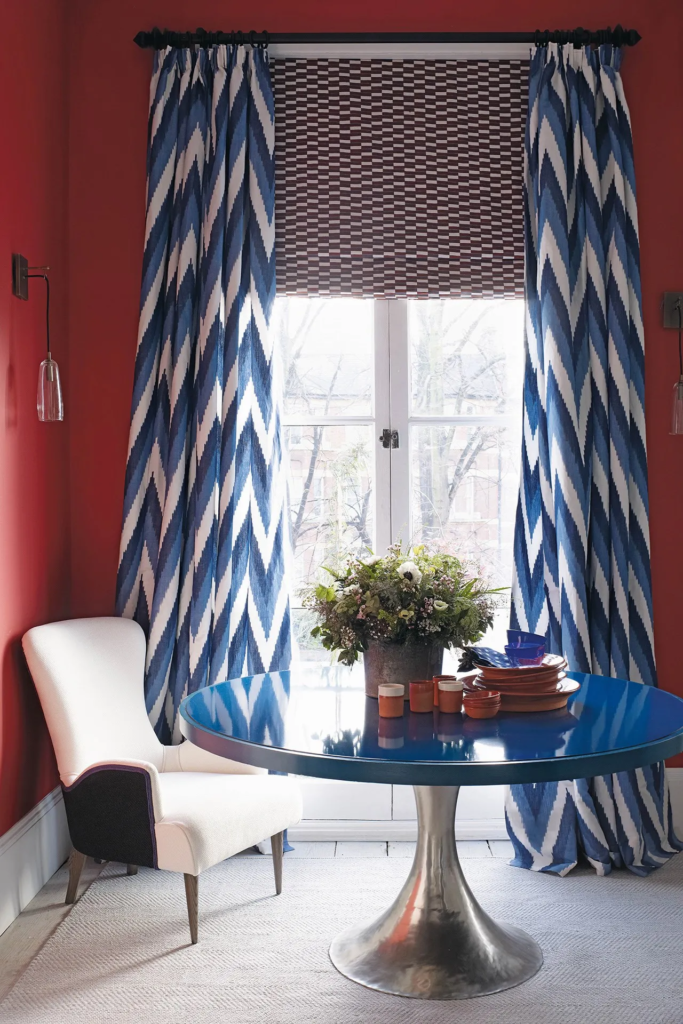
Blends refer to fabrics that are woven by combining two fabric yarns so that each can set off the negative attributes and enhance the positive attributes of the other. Poly blends are a combination of natural and polyester fibers resulting in various types of fabrics such as terrycot, polycotton, and linen blends.
As compared to natural fabrics, poly blends have more dimensional stability, fast-drying capacity, and colorfastness. In some cases, the addition of polyester and terylene fibers serves to make cotton and linen smoother, hardier, and more opaque. Therefore, these are the most practical solution for those who love natural drapery fabrics but need to have them more refined and upscaled to suit their purposes and climatic conditions.
VELVET

This is a luxury fabric that used to be made of pure silk in earlier years. These days, velvet fabric is made of silk blends, cotton, polyester, nylon, viscose, or rayon. It is a woven tufted fabric characterized by a dense pile of evenly cut fibers with a smooth nap.
The thick weave and plush naps make velvet curtains excellent insulators and light blockers. They can work as room-darkening and sound-absorbing curtains even if left unlined, making them good suitors for bedrooms, nurseries, and media rooms.
Velvet is a heavy-weight fabric, perfect for long drapes in formal, dressed-up spaces. If the windows are oversized, it is better to use this fabric to design stationary, decorative drapes as they can be cumbersome to operate.
Owing to the textured finish of the fabric, it is prone to attract lint and dust, making its maintenance a tedious task. The thick makeup of the fabric also makes it slow drying and highly susceptible to mold formation in wet areas and humid locales.
SHOP NOW: CUSTOM VELVET CURTAINS & WINDOW DRAPES
SILK
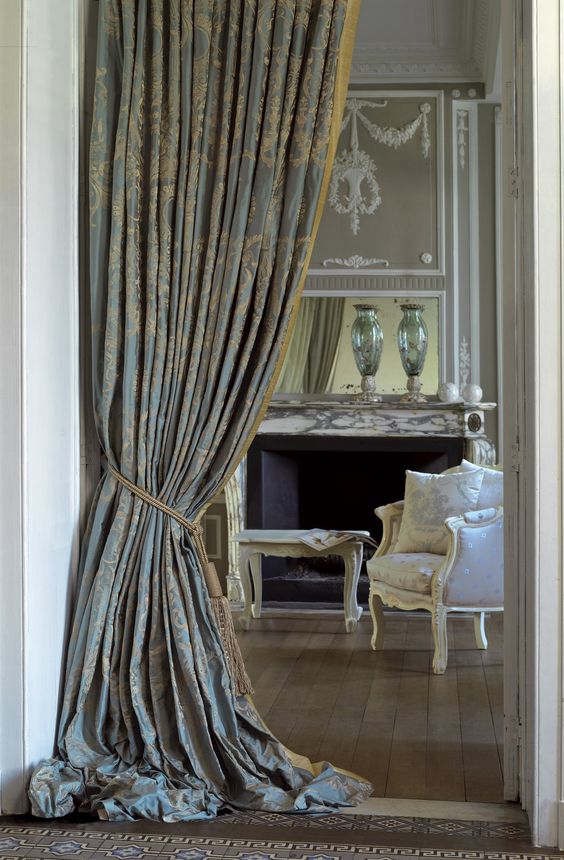
Another luxury fabric suitable for curtains is silk. It is made of a protein called fibroin collected from the cocoons of silkworms. Its lightweightedness, softness, and natural luster make it fit for ultra-formal dressy spaces. And since it is natural and breathable, it never blocks out fresh air from the room.
Pure silk curtains are the epitome of luxury owing to their limited availability and labor-intensive and costly production process. But, the regal appeal of silk is not owed to its hefty price tag or exotic origin as to its effortless resplendence. Silk refracts light from different angles at the same time. The sheen and the delicacy work together to make silk curtains the ornaments of the space they adorn.
Silk curtains may be put to their best use as decorative accessories as they easily shed their sheen and hue when exposed to the sun for long hours. Therefore, it is necessary to line and interline these curtains to minimize sun damage. Silk is also extremely reactant to water and retains the stains forever. Hence, silk curtains are unsuitable for humid and moisture-ridden spaces.
Additionally, this pricey fabric also gets wrinkled easily which may fall out of taste for those who like their space to always feel neat and fresh all the time. But for those who love that tell-tale sign of an opulent but lived-in home put to its best use, this factor only makes silk more tempting.
SHOP NOW: CUSTOM SILK CURTAINS & WINDOW DRAPES
FAUX SILK
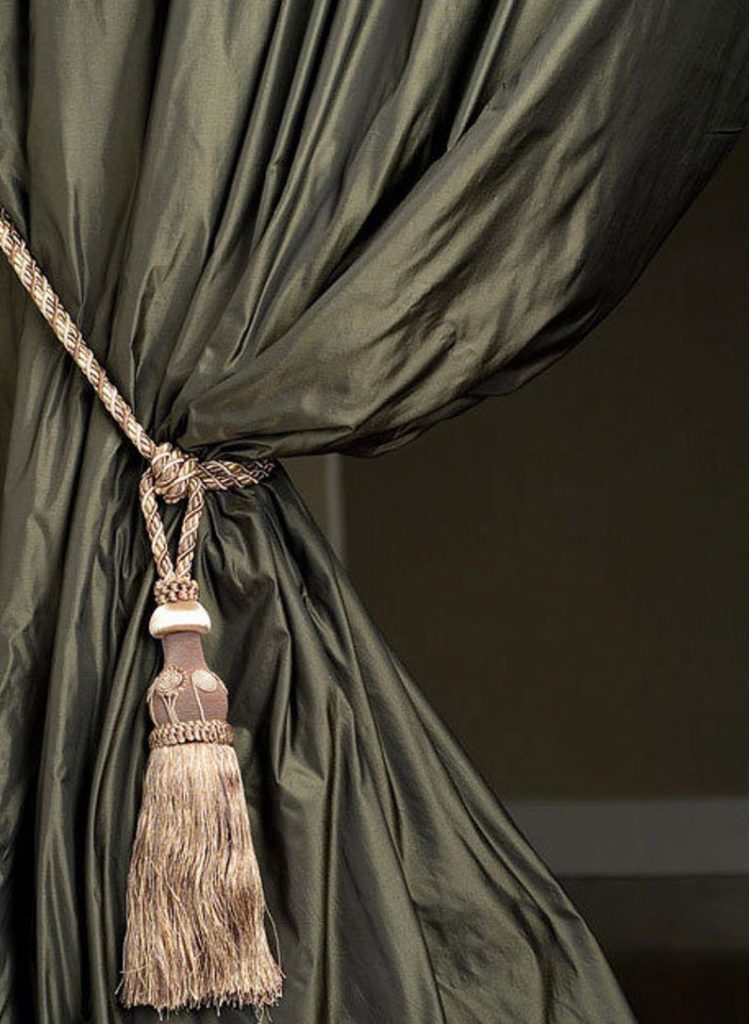
Those who love the royal look of silk but shrug at its maintenance issues may try faux silk. As the name suggests, this fabric looks and feels like silk, but is actually made of polyester. Needless to say, it goes in the opposite direction on the price scale as compared to real silk. Besides, faux silk can handle sunlight, humidity, and water without giving you any maintenance headaches, unlike real silk.
Since it looks like silk, it is a replacement option for all those spaces where silk curtains could have done a fab job. So, ultra-formal living rooms and designer guest bedrooms may be ideal spaces for faux silk drapes. But, since they eliminate all the maintenance issues that silk poses, they become capable of adorning any room in the house that can profit from its sophisticated looks and lustrous glamor.
How to Decide Which One is Right for You?

Now you know that no one fabric may be called ‘the best’, but ‘the best for a given purpose’’. Which fabric suits best for the curtains in your home depends on various factors including visual appeal, climatic conditions, maintenance issues, budget, and the purpose of the space, to name a few. In fact, you may need to take recourse to different fabrics for different spaces and rooms in your home.
Here, we lay out the parameters for you to take your decision with ease:
NATURE OF ROOM
The purpose of the room will perhaps have the loudest say in the selection of fabrics for curtains. Kitchens and bathrooms may need special considerations about quick drying and dimensional stability. Lightweight cotton and linen blends with a higher percentage of polyester or pure polyester fabrics are the best choices for bathrooms. They can dry faster and run a lesser risk of getting moldy. Cotton and linen blend fabrics with a lower percentage of polyester are better suited to kitchens. The aim is to not let your kitchen and adjoining areas be heavy with tangy cooking odors and to reduce risks of fire hazards.
DECOR STYLE
Fabric choice for curtains hinges highly on the look you are aiming to create for your home and its overall decor language. If your decor style is committed to natural elements like stone, wood, and wicker, as in Balinese or Scandinavian styles, natural fabrics are the default choice. For a very informal decor style such as boho or shabby chic, have no second thoughts about the homeliness of slubby linen curtains. Whereas, for very polished decor styles like Hollywood regency or dark academia, you need posh fabrics like velvet and silk for your windows.
FUNCTIONAL OR DECORATIVE
Fabric decisions can be made easily if you have crystal clear discernment about the purpose of your curtains. Are your curtains going to be full-on functional in controlling light and providing privacy? Or, are they meant to flank the windows just to add softness and oomph?
Statement fabrics like pure silk, brocade, and velvet are fitting for decorative drapes that are meant to add charm without shouldering any responsibility. Whereas, cotton, linen, polyester, and polyblends are great choices for fully functional drapes as they are lightweight, hardy, and durable.
MAINTENANCE MATTERS
Maintenance of curtains generally involves routine vacuuming and annual washes/dry cleaning. They also have to be ironed before being hung after every wash. Occasionally, they can be steamed to maintain their crisp folds and graceful fall. Over and above this regimen, certain fabrics are more demanding than others.
Velvet attracts lint and dust easily while linen needs to be steamed more often than other fabrics if you want them to look very refined. If you want to reduce maintenance issues, choose fabrics that can pull off a good look with minimum care such as cotton, polyester, and poly blends.
BUDGET
Sometimes, even though you need a high-end look you may be constrained by a shoestring budget. Applying the high-low principle, you can go for curtain fabrics that meet your design aesthetics without weighing down on your pockets. For example, until you can invest in a set of exotic pure silk curtains, be happy with faux silk curtains that give similar visual appeal.
The Bottomline
We hope that the drapery fabric choice issue that seemed like a conundrum has fizzled down to a piece of cake. More choices are a great thing to have only when you have the knowledge to select the best one for you. And, we were striving thus far to empower you to make your decision with confidence. But should you have questions still, know that we are just a call away and Spiffy Spools’ curated collection of drapery fabrics is waiting to gratify your deepest home decor aspirations.
READ MORE: WHAT IS THE BEST FABRIC FOR ROMAN SHADES?
FARMHOUSE KITCHEN CURTAINS: A RESTIVE MOMENT IN A HARD-WORKING SPACE
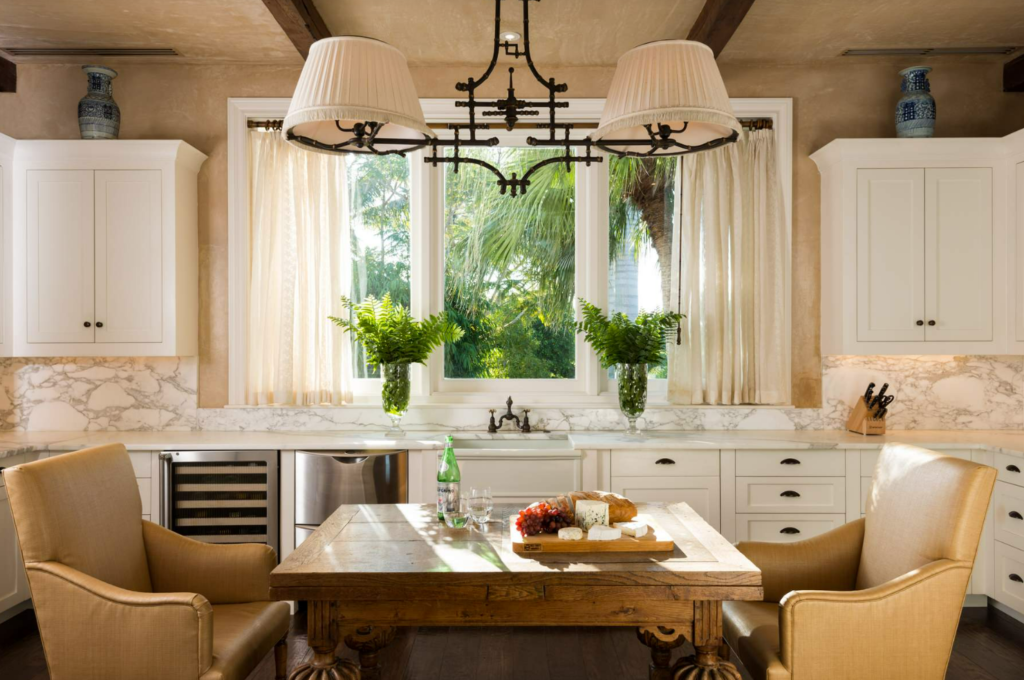
Country charm in a modern streamlined language – that’s what we love most about modern farmhouse kitchens! Its delicious palette with warm wood, natural stone, and inky black accents popping up against an ethereal white backdrop feels all the cozier with soft informal furnishings.
In this setting, curtains provide the perfect opportunity to marry traditional fabrics to sophisticated hues – beckoning the true farmhouse feel. If you’re exploring online stores for custom farmhouse kitchen curtains, let’s assure you’ve landed in the right place. From organic patterns to soothing textures and tones, whatever your wishlist for your windows, you’ll find it here at Spiffy Spools. What’s more? Explore fantastic styling tips before going on your wild shopping trip. Enjoy!
Order custom curtains and drapes for your farmhouse kitchen from Spiffy Spools online in any size. Pick from over 3,000 fabrics and patterns!
Soothing and Inviting: Cozy Farmhouse Kitchen Curtains
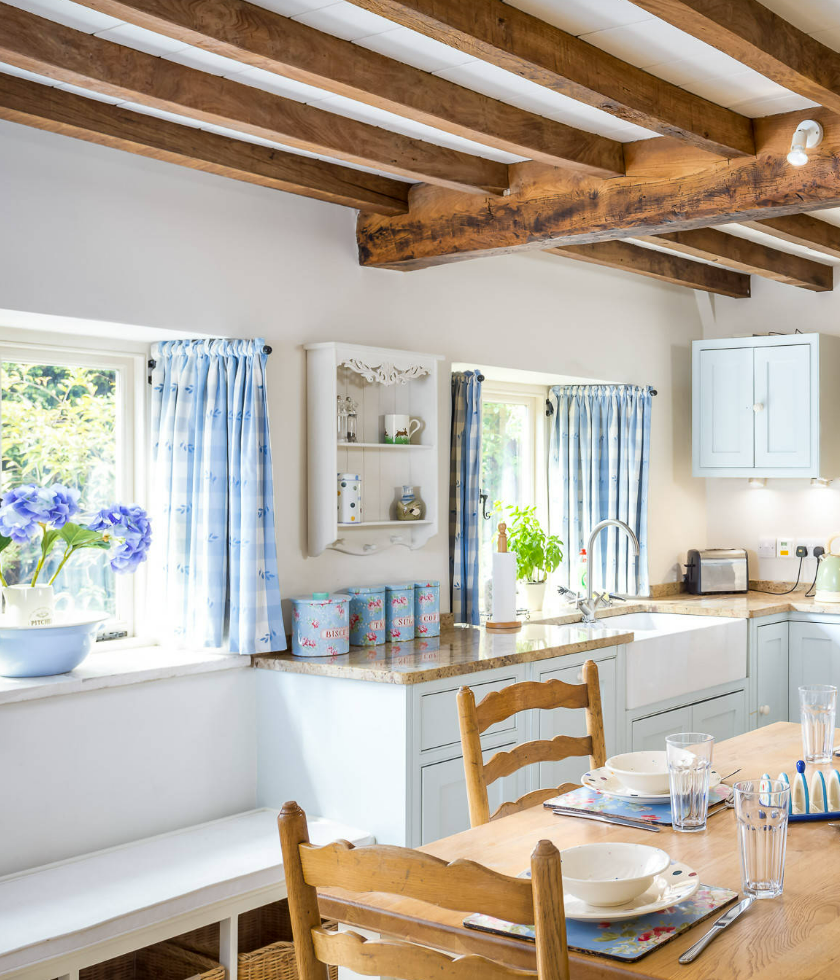
In light and airy farmhouse kitchens, windows are a perfect opportunity to layer the space with cozy curtains that speak to the style. Bright, light-filtering curtains – that can introduce color, texture or pattern – go a long way to make your farmhouse kitchen look even more inviting and visually pleasant. Curtains, with their rippled contours, load the space with softness and homey vibes that are key to the farmhouse design style.
If your kitchen is open to the living room as in modern standard houses, the kitchen curtains will also have a role in the overall decor. If it is tucked away, it can have a personality of its own while still being in sync with the farmhouse style. Either way, it is important that the kitchen curtains incorporate the soul of the farmhouse style and delight you whenever they meet your eyes. So, coming up ahead are all the excellent styling tips from our home decorators that you’re waiting for:
READ MORE: HOW TO CAPTURE THE COZY COTTAGECORE AESTHETIC IN YOUR HOME
Keep it Casual and Lived-in
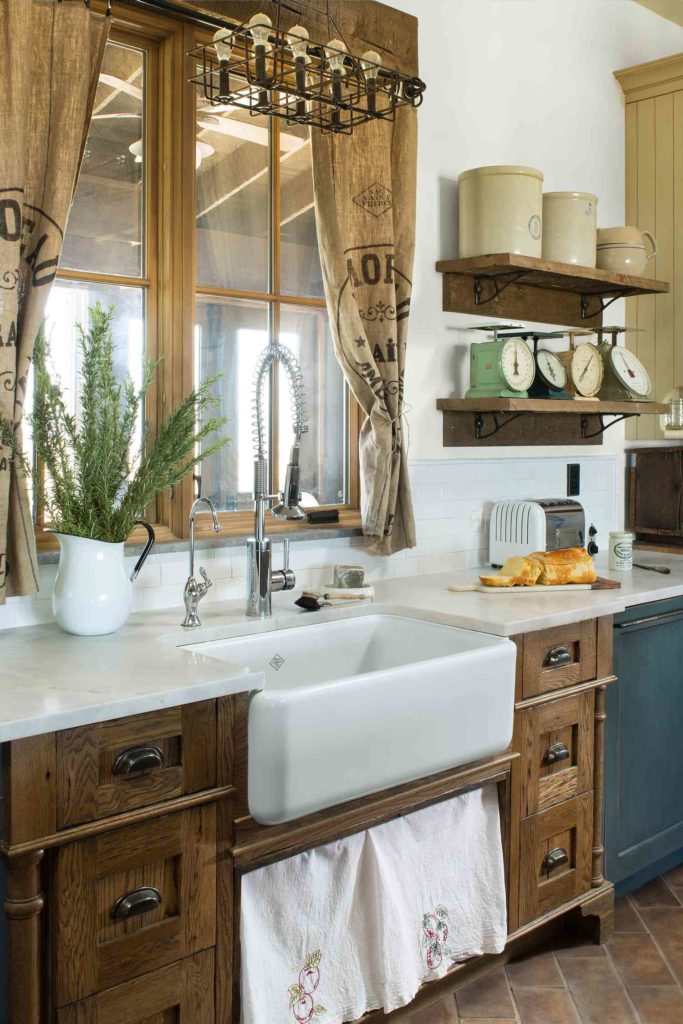
Kitchens are typically casual spaces, no matter what design style you follow, but the farmhouse style would do it in a pronounced way and with a remarkable country spirit. Nothing is too precious here, but everything is highly durable, nature-sourced, and feels lived-in. This aspect should be ensured in the curtains as well.
So, curtains made of natural fabrics like linen, burlap, and cotton are staples in farmhouse kitchens. Their breathability ensures a bright and airy space, the dream kitchen of cooking-savvy families.
Linens and linen blends are the top recommendation because of their lovely crinkled look. The lazy nonchalant vibe they transpire is just what anyone needs to unwind and feel at home. But if you love curtains with crisp and neat folds, lightweight cottons will satisfy you. Despite their tailored looks, the casual spirit is preserved because they are light and natural.
If your kitchen is designed with an overtly rustic flair, add burlap curtains to the windows that smack of a farm full of hoofed friends lapping up their feed. The downside to this option is that the palette is very rigid, but it ties beautifully with your seaweed baskets and rattan furnishings.
The farmhouse style is all about practicality mixed in the right dose with aesthetics. So, blends of these natural materials that give you the best of both are also highly recommended. Since kitchen windows are often placed right above the sink or the hob, it is nice to tap into the fast-drying properties of synthetic fibers.
Once you’ve finalized the material, focus your attention on other ways to enhance the lived-in feel. Make the kitchen look like it’s aged with you by opting for washed-out hues and/or worn-out patterns that seemingly point to years of serious combat with the elements of nature. For example, look at Pale Shadow curtains’ muted beige-white pinstripes that look ever so elegant and like it’s been there for ages.
READ MORE: CHARMING & RUSTIC CURTAIN IDEAS
Go for a Soothing Neutral Base
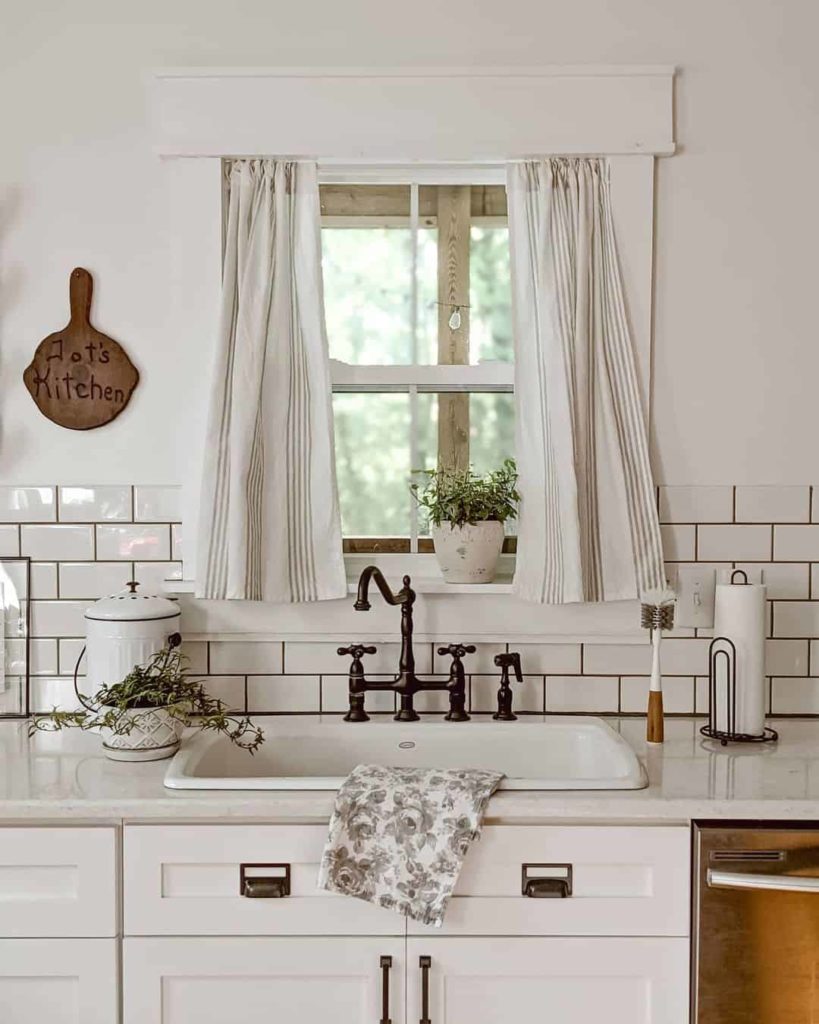
The neutral palette is the hallmark of the farmhouse style and it grounds the space in a very soothing and cozy appeal. While white is the staple, cream, tan, soft gray, and beige are options too for curtains as they can echo the earthy hues already at play in the kitchen. Besides, these self-effacing colors blend into the space instead of commanding attention, making the mind more relaxed when you’re surrounded by them.
Colored items can become the stars around neutral bases, so your delicious apples and peaches, fresh blooms arranged in stoneware jars, and the pickled delicacies in your glass canisters can stand out and make their statement. Also, rich textures are best emphasized on neutral backdrops as the color takes the backseat, allowing the weave and the finish to take over the reign.
Pristine white curtains have forever enjoyed the hot favorite status in farmhouse kitchens. They not only let in more light but also reflect more light, helping to make the most of the smallest window. Have a look at Alban and if you can’t take your eyes off it, white curtains are probably calling you.
White slubby linen curtains are the default in farmhouses, as are lighter weight sheers. With soft sunlight seeping into the kitchen through curtains like Butter Cream, who wouldn’t love to stay up cooking there? With tiny florals embroidered in beige, this pretty window dressing blends farmhouse style’s two obsessions – white palette and nimble craftsmanship.
Moving out from the conventional farmhouse ideas, you can also try a fabric like Sahara Dream – a lovely beige cotton blend drapery or Sea Salt – a white-grey linen-like textured drapery.
There’s plenty more to feed your imagination in our collection, waiting to be discovered!
READ MORE: WAYS TO MAKE AN ALL-WHITE KITCHEN POP WITH COLOR
Bring in Those Nostalgic Patterns
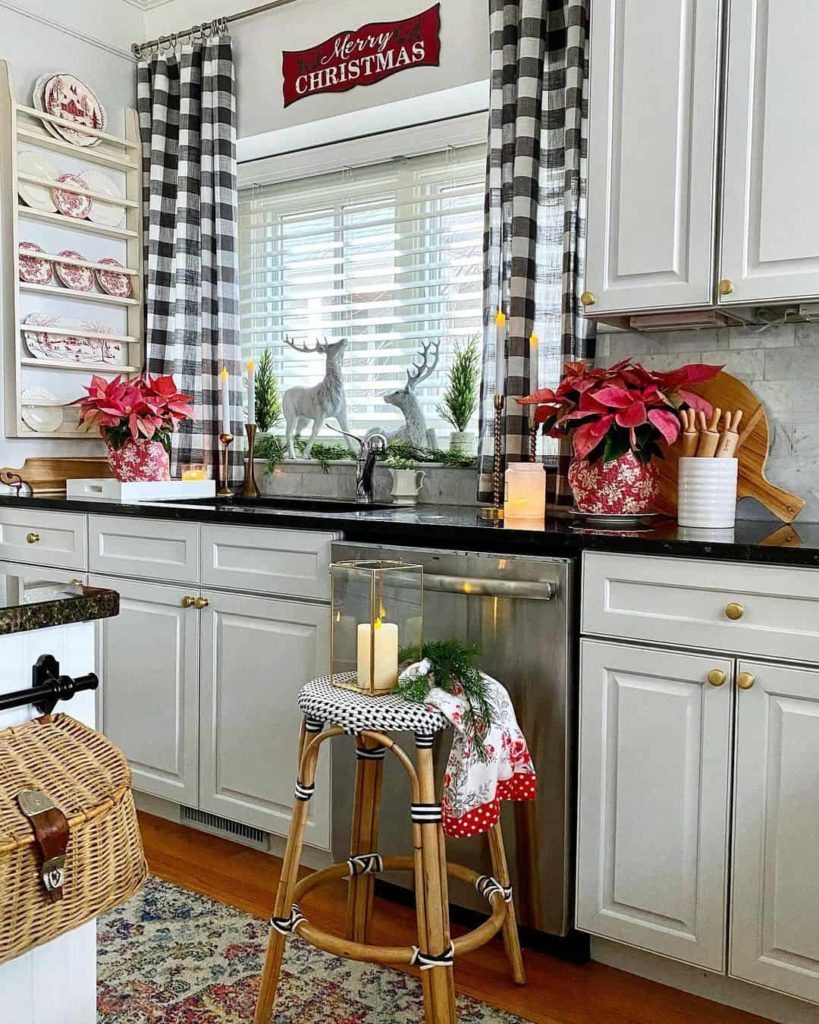
While modern farmhouse style is not an ardent fan of patterns, if you’re not that committed to that version of the design style, consider patterned drapes that speak to the style’s inherent obsession with vintage elements redolent of traditional bucolic themes and country lifestyle.
Patterns bring the play of shapes and contrasts that can woo the eye and make the space look very personalized. And, since the color scheme is largely neutral, a fair amount of patterns goes a long way to make your kitchen look delectable to the eye. An appliance-heavy kitchen becomes a more friendly-looking space with carefully curated decor accessories that indulge carefree in colors and shapes.
That said, certain patterns are almost the monopoly of the farmhouse style. In more rustic kitchens, something would be truly amiss if these time-tested old-world patterns were not incorporated. We’re talking about good old ginghams, plaids, buffalo checks, houndstooth, stripes, and florals – all with their modern versions available now in line with changing trends.
Complete your farmhouse kitchen with curtains featuring rustic motifs that nod to the humble bucolic background of this iconic decor style. Like Apple Blossom curtains that are an amalgam of all the heartthrob elements of the farmhouse style – traditional red-white ginghams on a rich herringbone weave drapery. It’s but the height of vintage flair you can bring to any kitchen!
Or, consider a floral curtain like Crushed Ice which brings rustic charm with modern connotations in its beige vine motif laid out on a white backdrop. The rich embroidery adds to the homespun charisma while the palette stays pared-back with sophistication.
READ MORE: BUFFALO CHECK CURTAINS: FINE-FINISH THE COUNTRY VIBE
Get the Apt Style
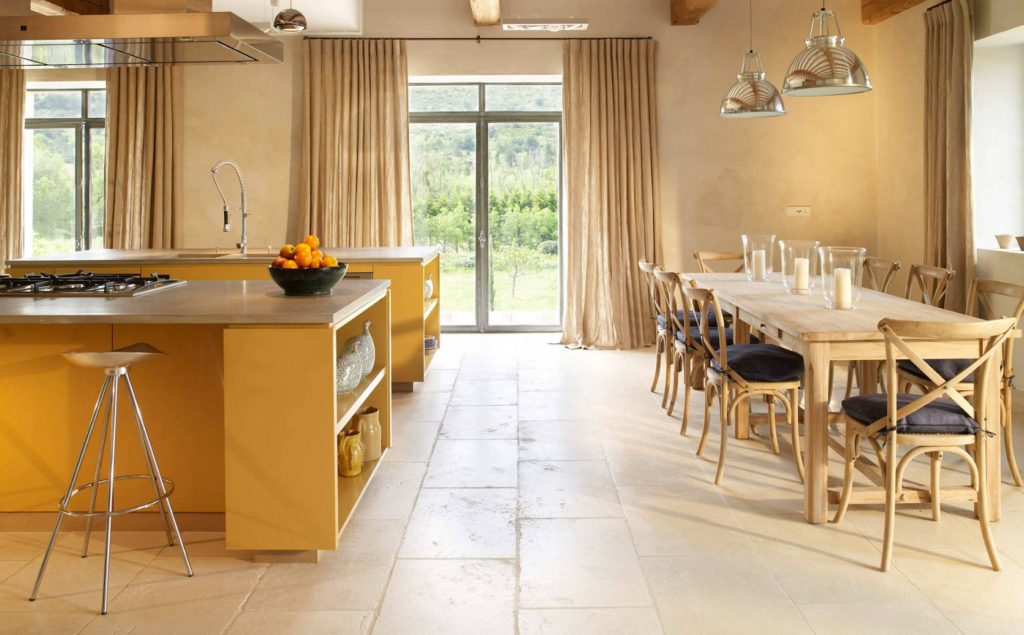
Once you select the fabric, it is time to pay attention to other details. The heading style of the curtains as well as the hardware selection warrants forethought so you don’t miss the folksy rustic vibe of the farmhouse style. And here’s how you can nail it at the first strike!
Makeshift arrangements with easily available materials are very typical of the pastoral lifestyle and the farmhouse style integrates that aspect into its design formulas. So, as regards hardware, the branch of a birch tree can work as a drapery rod and give company to the band-sawn kitchen island.
If you don’t want to go that far, install wooden drapery rods to keep up with the style’s obsession with timberwork. In a more modern farmhouse, these can be replaced with metal drapery rods in a matte black finish to echo the black accents of the design.
Then, get the curtains stitched in styles that expose this show-worthy hardware. Styles like tab tops and tie tops don’t just expose the rod but also vouch for the ad hoc setups of the original farmhouse lifestyle in their fabric loops and knots.
More modern curtain styles that suit the farmhouse-style kitchen are grommet tops and flat panel tops. Despite their modern appeal, the embossed grommets and the oversimple headers of these styles stay true to the farmhouse character. All of the above-mentioned styles are especially recommended if you intend to operate your curtains frequently as they slide easily on the rod.
Whereas, if you will rarely operate your curtains and you don’t want them to billow vigorously in the wind, rod pockets and back tab tops are the better choice. These curtains are also ideal if your hardware fails to meet the farmhouse style’s traits or you just don’t like to show it because they cover the rod, save when they are opened. With frilled headers, these homely and charming curtains transpire real country essence in the design.
All these styles of curtains can pull off fantastic looks with lesser fullness and are ideal for short curtains. Avoid curtain styles that engage more fabric in the width as they can look cumbersome on small windows.
With proper attention paid to the curtain style and the hardware, you’ve almost reached there.
If you need more guidance on various curtain heading styles, read Spiffy Spools’ Curtain Headings Style Guide.
Think Cafe Curtains and Valances
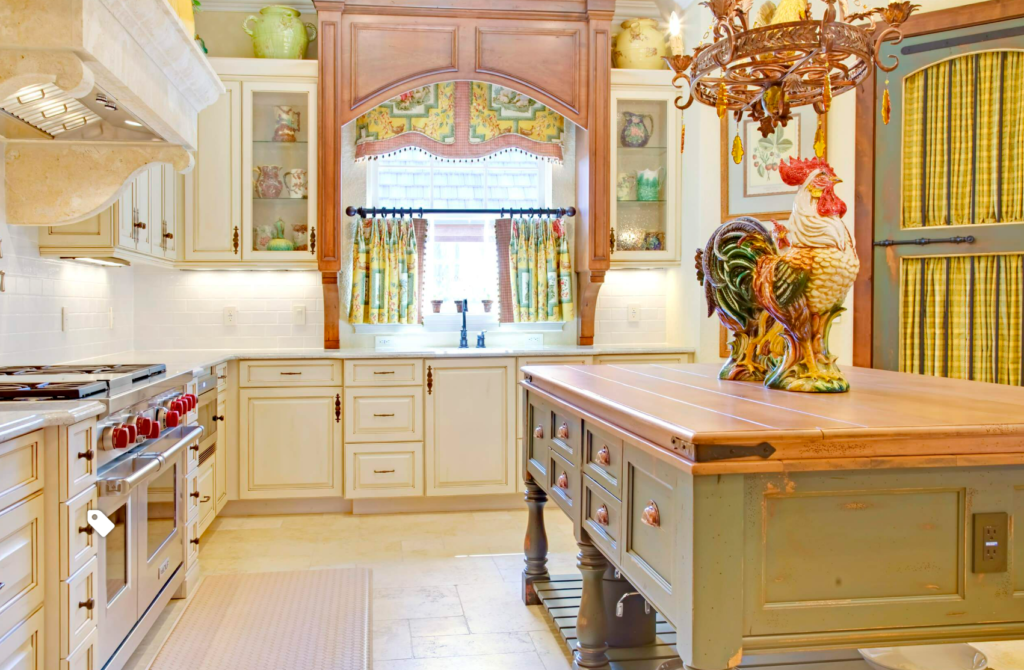
History repeats itself unabashedly, and both fashion and design recycle ideas of the past simply because they are timeless. A 1980s feature that’s trending now in kitchens once again is the lovely pair of cafe curtains and valances. And a style that never let this duo leave centerstage is the farmhouse style.
Cafe curtains are one of the most convenient window solutions for kitchens because they allow both light and privacy in a single shot. Covering only the lower half of the window, they offer just the right amount of coverage that a kitchen window needs. Since the window is always half-exposed, there is hardly any need to operate cafe curtains, taking that much of an effort off your tight schedule. While cafe curtains might remind you of your grandma’s kitchen, it’s wonderful if it’s truly smart and if you’ve loved her Thanksgiving meals, ain’t it?
Cafe curtains can do a fair job as stand-alone treatments. They provide a necessary amount of privacy as well as abundant light. But topping them with valances makes the scene better. Valances offer a grand topping to the casual cafe curtains and exude the pure country vibe that a farmhouse kitchen aspires to create. They keep the window dressed even when you’ve drawn your curtains open. When pairing the cafe curtains and valances, getting them done from the same fabric and in the same heading style is recommended for cohesiveness.
And in case, your kitchen window is looking for no coverage but just a touch of softness or tone-on-tone layering, you can opt for farmhouse valances as the standalone treatment too. Dressing the top-fourth of the window, they don’t cut off light or views significantly, but they add a decorative element which is perhaps what your kitchen decor badly needs. Placed above the frame, they make the eye gravitate upward, making a small window look longer and a low-ceiling kitchen look taller than it is.
READ MORE: KITCHEN VALANCES: TOP IDEAS FOR A STUNNING WINDOW
Winding Up
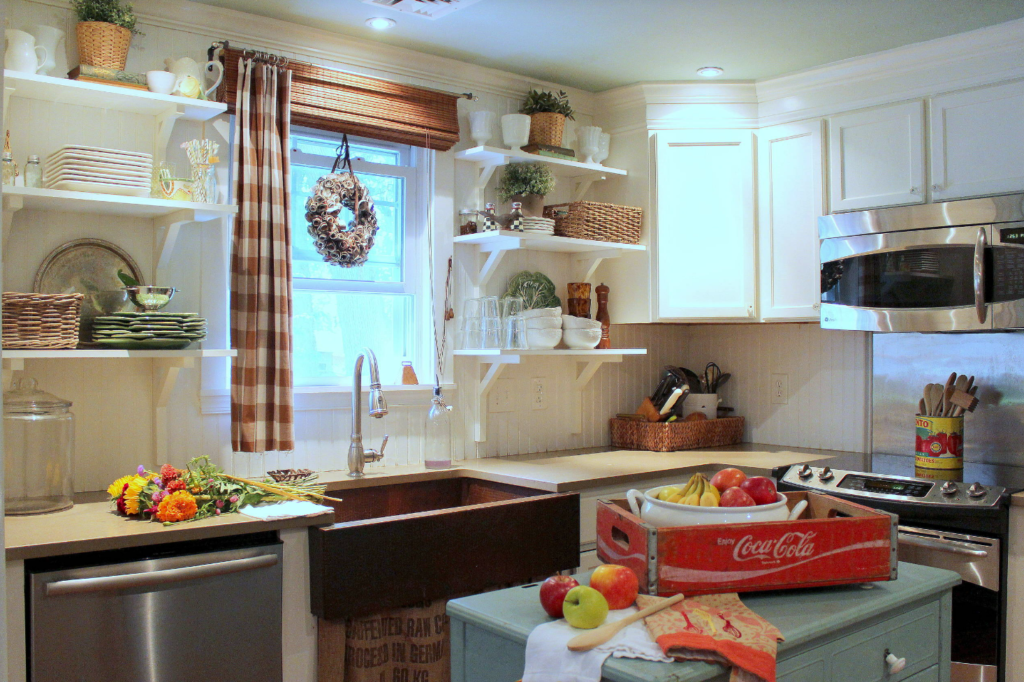
Following these design inputs, you’re sure to get the right look for your farmhouse kitchen windows. And every morning, as you watch your curtains billow while savoring your latte, you’ll thank yourself for having gone through this delightful process. Browse our collection and get custom curtains for your farmhouse kitchen in any size and style you wish. Happy designing from Spiffy Spools!
READ MORE: FARMHOUSE CURTAINS: IDEAS FROM CLASSIC TO MODERN
How to Save on Energy Bills Using Window Treatments
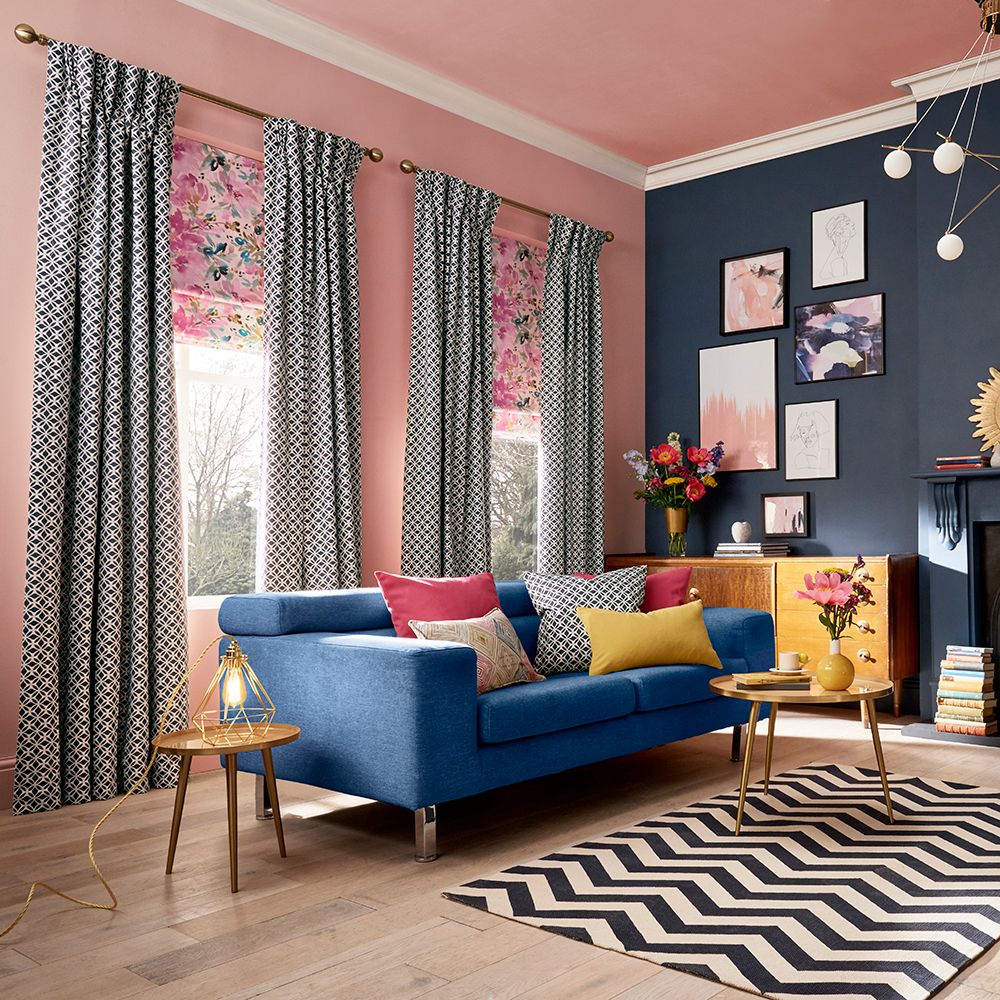
High utility bills can be a huge source of stress for homeowners, so it’s no surprise that they are always looking for solutions to cut down on electricity usage. While upgrading your appliances and focusing on regular maintenance are great energy-saving strategies, there is another cost-effective solution that can make a difference – window treatments.
Apart from adding style to your home décor, window coverings can help reduce your energy consumption. In the summer months, sunlight pouring into your house can quickly escalate your cooling bills. Installing shades, blinds, or drapes can filter out the sun rays and keep you comfortable without cranking down your HVAC thermostat. Similarly, in winter, window coverings can help trap insulation and prevent heat loss.
This blog will explore how window treatments can help you better optimize your home climate and the best type of window covering to improve energy efficiency.
Order custom window treatments from Spiffy Spools online in any size. Pick from over 3,000 fabrics and patterns!
How Window Coverings Can Help Reduce Bills & Improve Heating and Cooling Performance
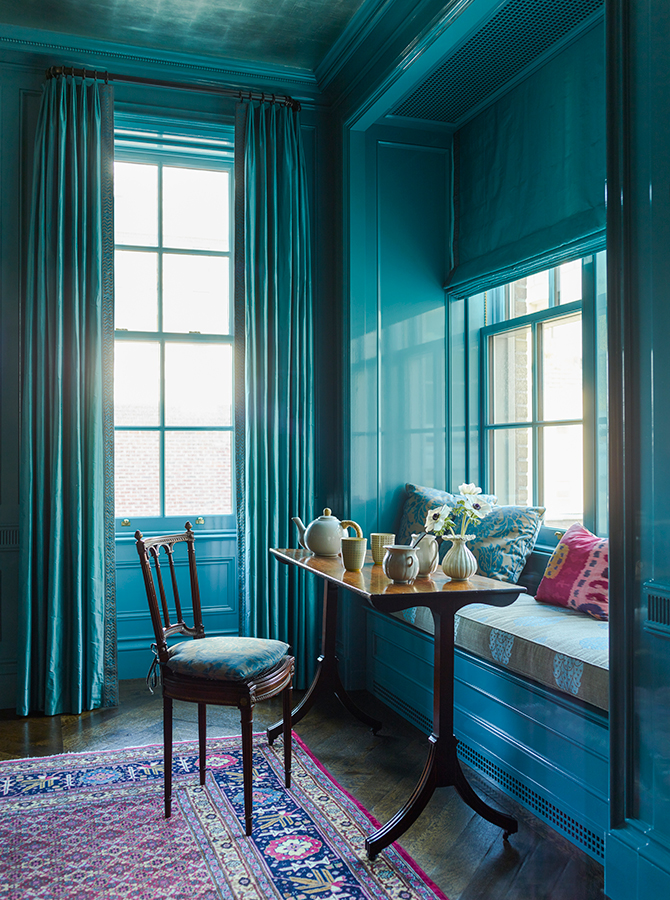
Window treatments and coverings do not come in mind when looking to bring down energy costs. Here’s how they help:
By Reducing Heat Gain & Loss
Did you know that about 30% of heat loss occurs through windows! During the cooling season, approximately 76% of the sunlight that falls on your windows becomes heat and affects your home climate.
Window coverings can help you cut down on energy wastage. For example, you can close your shades during hot summer days to prevent harsh light from coming in. This reduces the amount of heat coming inside and minimizes the HVAC system’s load, ensuring it works efficiently.
Conversely, during chilly days, you can open your curtains or blinds to allow sunlight to seep in and naturally warm up your home, limiting the reliance on heating systems. This can lead to energy savings, lower utility bills, and reduced environmental impact.
By Controlling Drafts
Drafty windows can make your home frosty as the temperature falls, prompting you to blast the heat. The same is the case in summer when cooled air leaks and you have to lower your thermostat settings. This can cause your electricity bills to soar and put a dent in your wallet.
Window treatments such as films, curtains, and drapes can be used to reduce drafts coming from cracks around your windows. This solution also comes in handy when you are renting and need a quick and temporary fix. You can retain up to 30% of the heat by using a window covering, helping to save you money in the long run.
Best Window Coverings to Keep Your Utility Bills in Check
Investing in the right window coverings for your home can help improve your HVAC performance and reduce energy bills while keeping you comfortable.
Curtains & Drapes
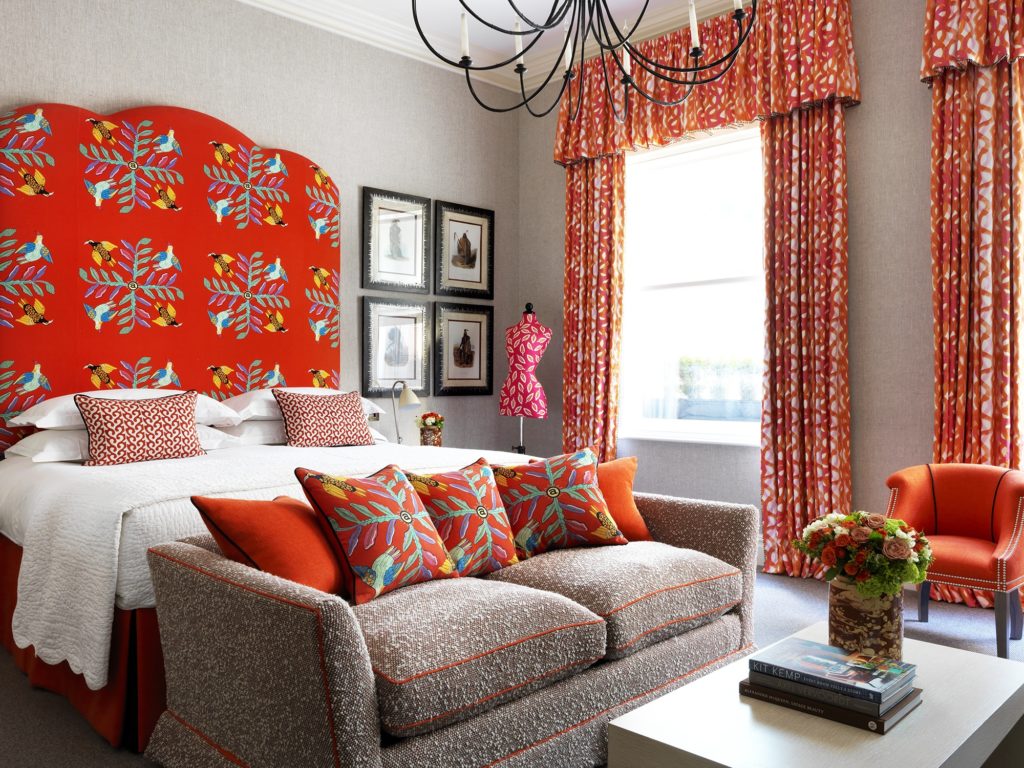
Curtains and drapes are fabric window coverings. Curtains have a lighter fabric composition and can be of any length, while drapes are made of heavier fabric and generally go all the way to the floor. Their ability to reduce heat gain and loss depends on the color and fabric type. They should be hung as close to windows as possible to increase the insulating effect.
In winter, closed drapes can help keep your home warm and reduce solar loss by up to 10%. A thermal lined curtain adds an insulating layer that can reduce heat loss by up to 39%. In summer, medium-colored drapes with light-colored backings can help reduce heat gain by 33%.
READ MORE: CURTAINS VS DRAPES: WHAT’S THE DIFFERENCE?
Roman Shades
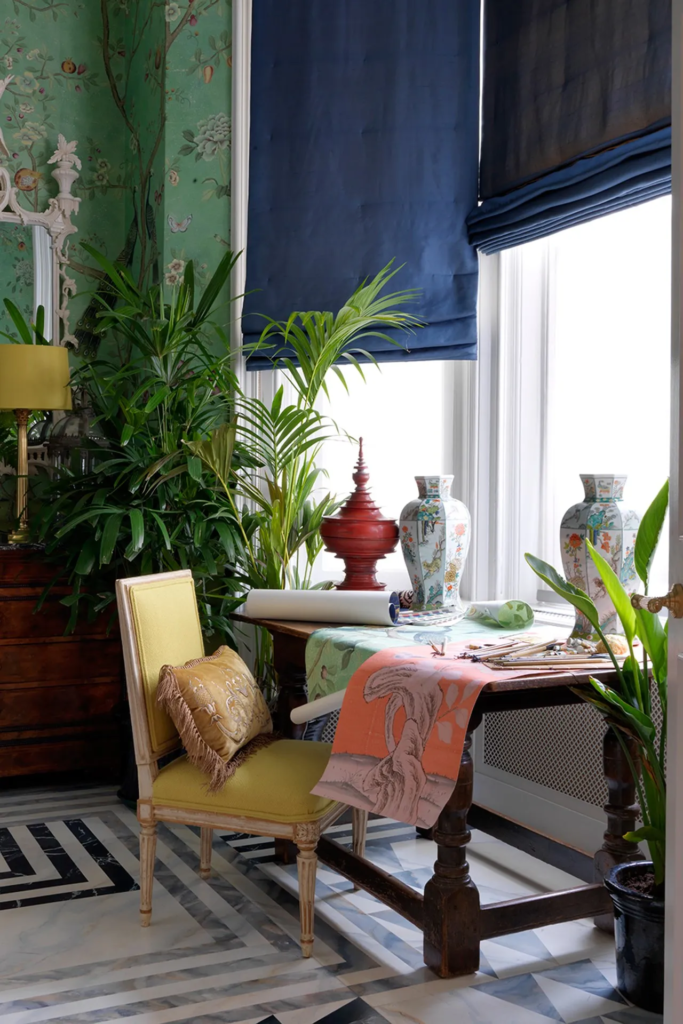
Roman shades are fabric window shades that you can use to reduce heat gain or loss. It has various layers of fabric layers that create an air barrier and thus help to save energy. Roman shades are considered one of the effective ways to reduce electricity bills. Roman shades with blackout linings can help to reduce unwanted heat by up to 60%. In winter, they can lower the heat loss by 40%. This can lead you to save up to 10% on heating costs.
You can also use reversible shades that are white on one side and black on the other to help with energy savings. You can switch them up depending on the season. The light color reflects light while the darker one absorbs it.
SHOP NOW: CUSTOM ROMAN SHADES FROM SPIFFY SPOOLS
Blinds
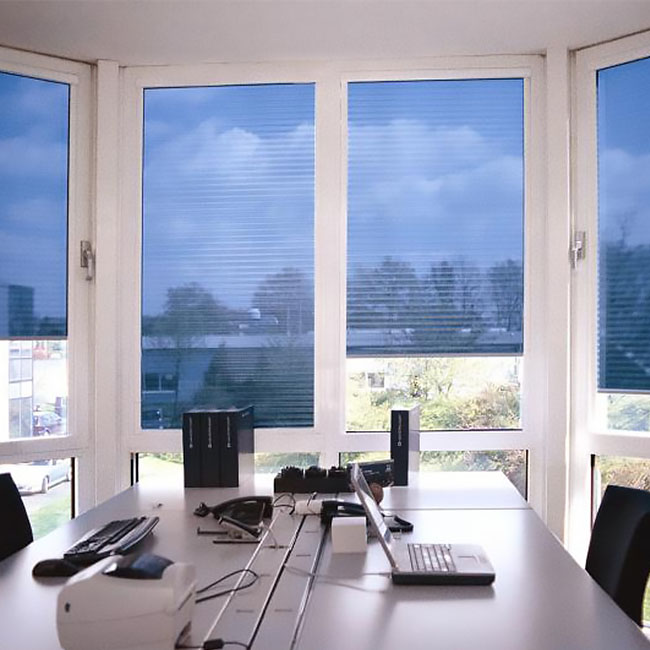
Window blinds add insulation to your windows and help to save on energy bills. Reflective blinds are the best fit if you are looking to reduce energy consumption and improve your HVAC efficiency.
Reflective blinds are designed to reflect light and heat, making them a must-have for any home. In the summer, they keep your home cool by reflecting sunlight away. Reflective blinds can help lower solar gain by 45%. In the winter, they reflect heat back inside, keeping your home cozy.
Some reflective blinds even have a reversible design, with one side highly reflective and the other highly absorptive. Be sure to position the reflective side toward the source of heat – in the summer, it faces out, while in the winter, it faces in.
READ MORE: BLINDS VS. SHADES: WHAT’S RIGHT FOR YOUR SPACE?
Window Films
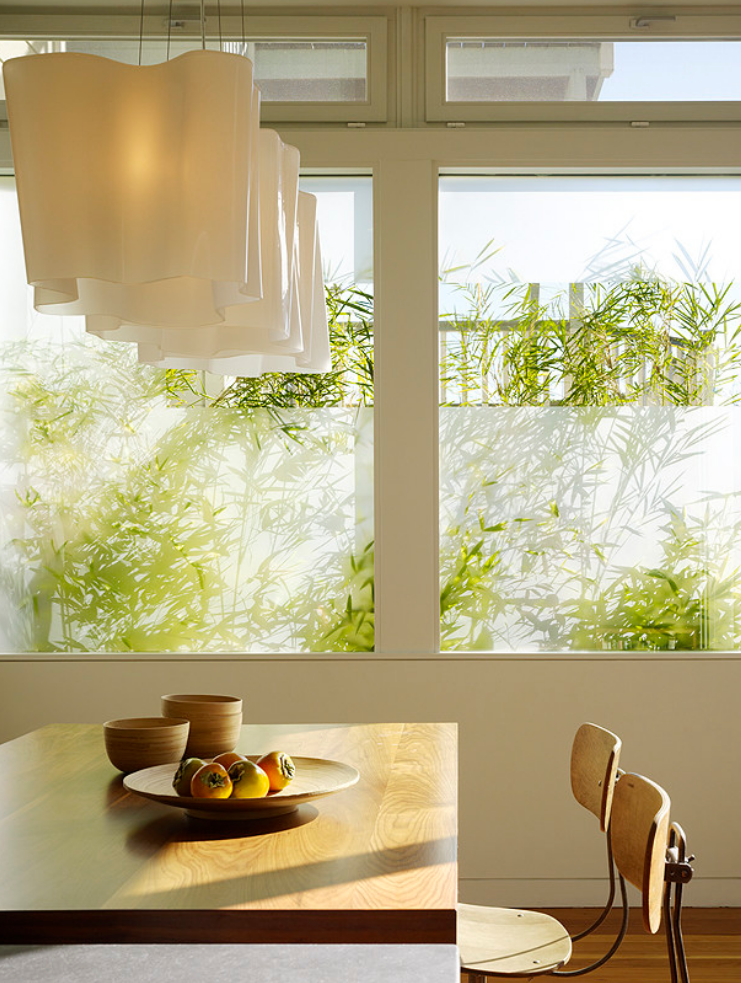
Window insulation film is a thin layer of plastic applied to window glass and is used to control heat and light transfer. It is mostly used in areas with long summer months and helps keep your home temperature cool. This way, you can keep your thermostat at a higher temperature and save on bills. The silver mirrorlike film is typically more effective than colored window films.
In Conclusion
Window treatments such as curtains, drapes, shades, and blinds are an easy and effective way to deal with high electricity bills while also adding style and charm. They help home warm during the winter and reduce heat within the house during the summer. This helps take the load off your HVAC and keep your home environment comfortable. From the multi-layered honeycomb shades to the reflective blinds, there’s an array of window treatments that comes in so you can find the best one for your windows and budget. Whether you go with a more classic look or something modern – you can save a significant amount of money without breaking the bank.
Order custom window treatments from Spiffy Spools to add charm and personality to your space by picking from over 3000 fabrics. Your budget will love our products too as they are fairly priced and will also help in making big savings on your energy bills!
READ MORE: BEST BLACKOUT CURTAINS FOR BEDROOM: TOP IDEAS & TIPS
Why Hiring a Real Estate Agent Can Make Selling Your House Easier

Selling a house can be challenging. From setting the right price to attracting potential buyers and managing the paperwork, it’s a complex task that requires expertise and experience. So, if you have decided to sell your house, a real estate agent can be of great help. By hiring a professional, you can make selling your house easier, faster, and more profitable. This article will discuss the benefits of hiring a real estate agent to sell your home.
Stage your house with custom window treatments from Spiffy Spools and beautify it so every potential buyer lines up to get the keys of your house at the price of your demand!
Expertise in Pricing Your Home
Real estate agents are experienced professionals who have a deep understanding of the local market trends and can accurately assess the value of your property. An experienced agent can also help you decide if renovating your outdoor area will help increase the house’s value, or if a foyer decoration project is worth the investment. They are skilled in determining the right price for your home, which is essential for attracting potential buyers and getting the best return on your investment.
Pricing your house too high may lead to a longer time on the market while pricing it too low could mean a significant loss in revenue. Real estate agents use their knowledge and market research to set a competitive price that aligns with the current market conditions.
Professional Marketing Strategies
In today’s competitive real estate market, it’s crucial to have a solid marketing plan to attract potential buyers. Real estate agents have access to various marketing tools and platforms, which can increase the visibility of your property and generate interest from a larger pool of buyers.
From professional photography to online listings, real estate agents know the most effective ways to showcase your home. A good agent knows how to highlight the best features of a house – from a recent kitchen renovation to the careful steps you might have taken to make your home eco-friendly. They also have extensive networks and can reach out to other agents, ensuring that your property reaches the right audience.
Better Negotiation Skills
Negotiating a property sale can be challenging, especially if you’re emotionally attached to your home. A real estate agent acts as a buffer between you and potential buyers, helping you navigate the negotiation process while maintaining your best interests.
With their experience handling multiple transactions, real estate agents can identify potential issues and recommend strategies to address them effectively. They can also advise on the best counteroffers, ensuring you get the most favorable deal for your property.
Assistance with Legal and Financial Matters
Selling any property will involve a significant amount of paperwork and legal requirements. However, real estate agents are well-versed in the legal processes. With their expertise, they can help you navigate the documentation and avoid costly mistakes.
From drafting contracts to arranging inspections and ensuring compliance with local regulations, a real estate agent can simplify the process and navigate you through any legal issues arising during the transaction. They can also connect you with reliable financial advisors, mortgage brokers, and other professionals who can assist you with the financial aspects of selling your home.
Time and Stress Management
Planning to sell your house can be stressful, particularly if you’re juggling it with your daily responsibilities. Hiring a real estate agent allows you to delegate the tasks associated with selling your property, freeing up your time and reducing stress.
Real estate agents handle all aspects of the sale, from conducting open houses and private showings to managing offers and closing deals. With their expertise and experience, they can streamline the process and ensure a smooth, hassle-free experience for you as a seller.
Conclusion
Hiring a real estate agent can make selling your house significantly easier and more efficient. By leveraging their expertise, you can achieve a successful sale while minimizing the challenges associated with selling your property. If you’re considering selling your home, enlisting the help of a professional real estate agent is a wise investment, saving you time, effort, and money in the long run.
READ MORE: SPRING HOME RENOVATION TIPS & TRENDS FOR 2023
Seven Tips For Designing A Stylish Outdoor Area For Entertaining This Summer
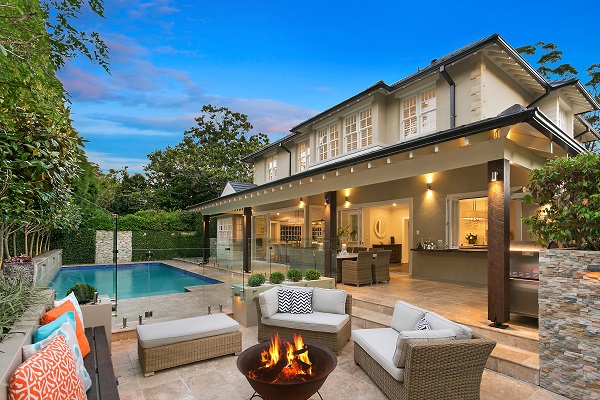
Just as Spring has us all charged up to declutter our homes inside, Summer is the perfect time to renovate outdoors. With warm weather and longer days, your backyard or patio can become the perfect backdrop for dinner parties, BBQs, or drinks with friends. Imagine drawing your patio door curtains aside only to have them open up to a bland view…not ideal! Therefore, ensuring your outdoor area looks stylish and inviting is essential. In this blog post, we’ll explore seven tips for designing a stylish outdoor area for entertaining this summer, including ideas for your deck and boat dock construction.
Choose The Right Furniture
Choosing the right outdoor furniture is crucial for creating a stylish outdoor area. Look for furniture that is both comfortable and stylish. Choose pieces made from materials that can withstand the weather, such as teak or aluminum.
If space is limited, consider scaling down the furniture to make the area look more spacious and inviting. Also, consider adding colorful throw pillows or cushions to add color to the space. You may find it beneficial to use an image editor to create a virtual moodboard/ plan before making decisions regarding furnishings since these are long-term investments.
Add Lighting
Outdoor lighting can add mood and ambiance to your outdoor space. Many options, such as string lights, lanterns, and solar-powered lights, are available. Consider using different lighting levels and colors to create a cozy and inviting atmosphere. Additionally, you can install dimmer switches to adjust the lighting according to your mood and the time of day.
Create Shade
Consider adding a patio umbrella or awning if your outdoor area isn’t shaded naturally. This will protect your guests from the heat of the sun while still keeping the area bright and inviting. You can also consider adding a pergola, which provides shade and creates an interesting architectural feature in your outdoor area. Just as window treatments can help create a cozy ambience inside you home, you can use outdoor curtains or blinds to create an outdoor, yet private, retreat for your guests.
Add Plants
Adding plants or flowers is an easy way to add color and life to your outdoor area. Find plants that are suitable for the weather in your area and choose pots that are in keeping with the style of your outdoor area. You can also consider adding a herb garden, which looks great and provides fresh ingredients for your summer recipes.
For example, you can incorporate potted plants, flowers, and herbs to add color and texture. If you have a small outdoor area, consider using vertical planters or hanging plants to save space.
Consider Flooring Options
Flooring is an important consideration when designing your outdoor area. Look for durable materials that can withstand harsh weather conditions. You can opt for various materials like stone, concrete, or brick. Adding an outdoor rug is also a great way to add color and texture to your outdoor area.
Another way to add interest and texture is by creating a unique feature with your flooring. You can try using different materials, patterns, or designs to create an interesting focal point in the space.
Create a Focal Point
Creating a focal point is an easy way to give your outdoor area a sense of purpose. It could be a water feature, a fire pit, or even an outdoor bar. This will create a space for your guests to gather and socialize.
Add Functional Accessories
Accessorizing your outdoor area is essential, but choosing functional and stylish accessories is crucial. Consider adding an outdoor bar cart or a cooler to keep drinks cool on a hot day. You can also add outdoor-friendly games such as croquet or cornhole to entertain guests.
The Benefits of a Stylish Outdoor Area
When it comes to entertaining outdoors, having a stylish outdoor area can definitely make a difference. Not only does it create a beautiful space where guests can relax and enjoy themselves, but it also adds value to your home. A well-designed outdoor area can also serve as an extension of your indoor living space, providing a seamless transition between the two. Whether you’re hosting a summer barbecue or a cozy dinner party, having a stylish outdoor area can create a warm and inviting atmosphere that will make guests feel right at home. With a little creativity and some thoughtful planning, you can transform your outdoor space into a beautiful oasis that’s perfect for entertaining.
One of the biggest benefits of a stylish outdoor area is the opportunity to showcase your personal style. With so many different design options available, you can create a space that truly reflects your tastes and personality. From modern and minimalist to rustic and cozy, there are endless possibilities when it comes to outdoor decor. With the right combination of furniture, lighting, and accessories like balloon garlands or themed centerpieces, you can create a space that’s both functional and aesthetically pleasing. Not only will your guests appreciate the beautiful decor, but it will also make you feel proud to host gatherings in your own backyard.
Another benefit of a stylish outdoor area is the potential for increased socialization. When you have a beautiful outdoor space, people are naturally drawn to it. They’ll want to gather and spend time in the inviting atmosphere, which creates opportunities for conversation and connection. A well-designed outdoor area can also encourage guests to linger longer, which can make for an unforgettable evening. Whether you’re hosting a small intimate gathering or a large party, a stylish outdoor area can set the tone for a fun and memorable event.
Conclusion
In conclusion, having a stylish outdoor area for entertaining has many benefits. From showcasing personal style to encouraging socialization, it creates a warm and inviting atmosphere that’s perfect for hosting gatherings. It also adds value to your home and creates a seamless transition between indoor and outdoor living spaces. So, whether you’re looking to host a summer barbecue or a cozy winter gathering, a well-designed outdoor area is definitely worth the investment. It may even help increase the value of your property, making it easier to sell your house, should you so decide in the future.
Designing a stylish outdoor area for entertaining is easier than you think. Following these seven tips, you can create an inviting and stylish outdoor area that your guests will love. Remember to choose durable furniture, add lighting and create a focal point. Accessorizing with functional items and adding color through plants and accessories will create a space perfect for entertaining throughout the summer.
READ MORE: SUNROOM WINDOW TREATMENTS: IDEAS, PHOTOS & TIPS
WINDOW TREATMENTS FOR PATIO DOORS: TOP IDEAS & TIPS
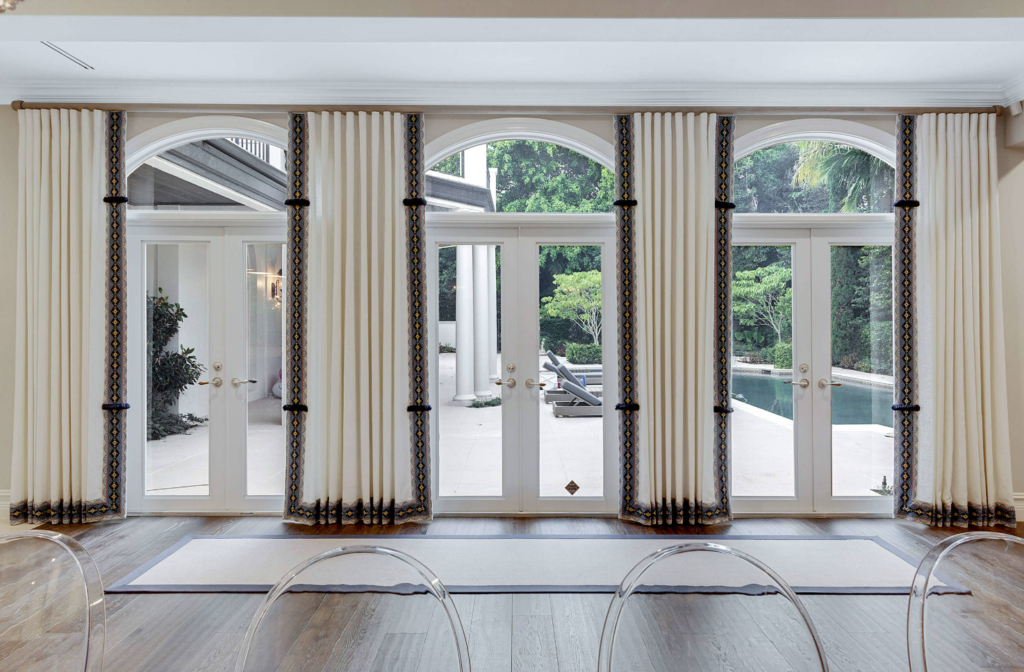
We all love our patios – be it for eventful barbeque nights or quiet ‘me-time’ with nature. With the onset of spring, our homes are refreshed with the summer resplendence spilling in. Thanks to glazed patio doors, we can enjoy warm natural light even as we nestle in our homes. But everything good comes with a price, and patio doors do compromise privacy and insulation. Thankfully, there are smart and chic window treatments that can offset the loss and also double up as decor accessories. If you’re looking for elegant and efficient window treatments for patio doors, find yourself in safe hands as we’re about to unveil all the secrets to get there.
Order custom window treatments from Spiffy Spools online in any size. We carry over 3,000 fabrics and patterns to pick from, so you can dress your patio doors exactly to your liking!
Window Treatments for Patio Doors: Key Considerations
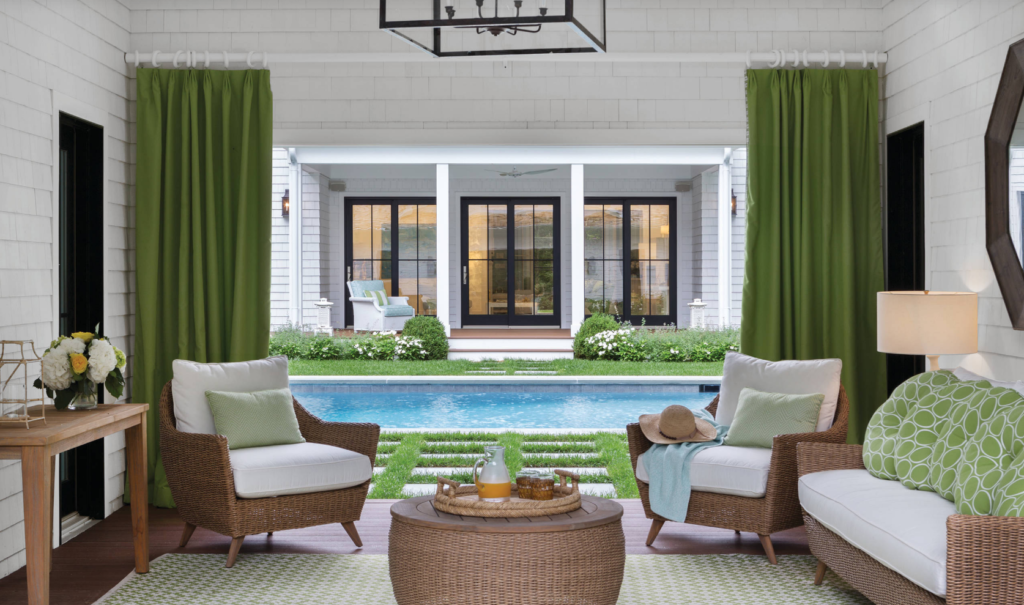
While covering patio doors is a great idea to provide privacy, what we shouldn’t end up with is a window dressing that fails the purpose of the patio doors – to connect us visually with the outdoors, to let light and air in, serve as an obstruction-free passageway and make the room feel spacious. And not all the window treatments that work well with ordinary windows and doors will work well for patio doors. It’s because the challenges with dressing patio doors are different from that of others. For your convenience, we have listed them.
- GRAND SCALE: Unlike windows and other doors in the house, patio doors usually have an overbearing size since they are specifically meant to connect the interior of the home with the exterior environment. And that in itself is a challenge as many window treatments fail to be sturdy and efficient when designed in large dimensions.
- METHOD OF OPERATION: Unlike windows, patio doors have a different style of operation. They may be single or double doors that swing open in one or both directions. Or, they may be sliding doors that move on a track and stack up on a side. Or, they may be bi-fold doors with multiple panels connected with hinged frames that fold against the wall like a concertina. The choice of window treatment will largely depend on how your doors operate.
- TYPE OF DOOR: You’ll have to factor in the making of the door, especially if you’re thinking of mounting the treatments directly onto the doors. Are they French doors or framed glass panes that offer a surface to affix a window dressing? Or, are they half-glass doors that require very minimal coverage? Or, are they frameless glass panes that might necessitate mounting the treatments on the walls instead?
- STACKING ROOM: For wall-mounted treatments, calculate whether there is sufficient space for stacking room on the wall enveloping the doors. If there is space above, you can mount shades and blinds. If there is space on the sides, think of curtains or sliding panels. If there’s no space either on the top or the sides, consider mounting on the doors or go for treatments with sleek profiles that need minimal space for mounting as well as stacking. In the end, whatever you decide, decide with an awareness that some of your door space will be blocked by the stacked dressings if you don’t have ample space on the walls.
- EASE OF CLEARANCE: Besides considering the space to mount the treatment, how they will fare with the usage of the doors should also be factored in. To pass through the doors, you’ll have to first clear the window dressing to the appropriate level. Careful consideration is advised therefore. For example, if the door swings inward and you have installed shades, you’ll have to raise them fully off the door’s frames to operate the doors. Similarly, curtains will have to be stacked back at the appropriate level to allow passage. Most clients may find it easier to draw side-stacking treatments for passage than top-mounted ones.
- KEEP HANDLES FREE: Close in hand to the previous point, is another one regarding access to the door handles/hardware. The window treatments must not ideally infringe on the handles, making it inconvenient to reach out to them for use.
- SET CLEAR GOALS: Define clearly the purpose of the window treatment so you can narrow down the options to those which tick the right boxes. Are you looking for highly functional window treatments to curtail light or provide privacy or more insulation for the cold months? Or, are you looking for decorative treatments to add a layer of color and pattern to your design scheme and stop at that?
- LIGHT CONTROL NEEDS: If your prime concern is light control, go one step ahead and define the level of control you’re seeking. Do you want a treatment that filters in light softly or one which blocks the light fully? Or, do you want to go a step further and ensure room darkening to enjoy your movie time?
- PRIVACY NEEDS: If privacy assurance is the goal, define it with more clarity. If it’s for daytime privacy then semi-transparent treatments can do the job. If it’s for privacy during the night, you might need blackout or at least fully lined treatments.
- CLEARANCE FOR MAXIMUM VIEW: No matter what type of treatment you go for, you certainly don’t want them to be so obtrusive and bulky that you can’t enjoy the views when you wish to. They must clear the windows to the maximum level when not in use.
- HIGH QUALITY MATERIALS & HARDWARE: Oversized window treatments require high-quality hardware to anchor the treatment strongly. Additionally, the material has to be hardy because it will be constantly exposed to the sun and the winds. Fabric treatments should be lined suitably to ensure longevity.
- STYLING DECISIONS: Since patio doors make you anticipate the landscapes or cityscapes beyond, honing that flow with a suitable palette, pattern, and structure can add to the vibe of the space. The window treatments should ideally connect the mind to the outdoors. So, earthy hues, wood textures, floral and botanical patterns, and organic and free-flowing profiles would work really well for window treatments for patio doors.
- DECOR STYLE: Last, but never least, don’t lose sight of your aesthetic goals in the process of selecting the relevant window treatments. Your patio door window treatments must definitely be a statement of your personal decor style since they occupy such vast optical real estate.
First Things First: Sort the Key Decision Regarding the Mounting Position
While there are several parameters to consider as we just saw, the most decisive one is regarding the mounting position. It is because this decision has much to do with the practical ease of operation that you are looking for. Since patios are highly frequented areas of the home, it is important to have treatments that work best for your space.
Patio door treatments come in various types based on how they are mounted. Once you tackle the important decision regarding their mounting position, you’ll have the options narrowed down a great deal to make your selection process fast and easy.
You can either go for window treatments that stack vertically on the top (blinds for example) or for those that stack to the sides, like drapes. Have a look at what you gain or lose with the various options.
Top Mounting vs Side-Stacking: Which is the Best for Your Patio Doors?
Side-Stacking Treatments
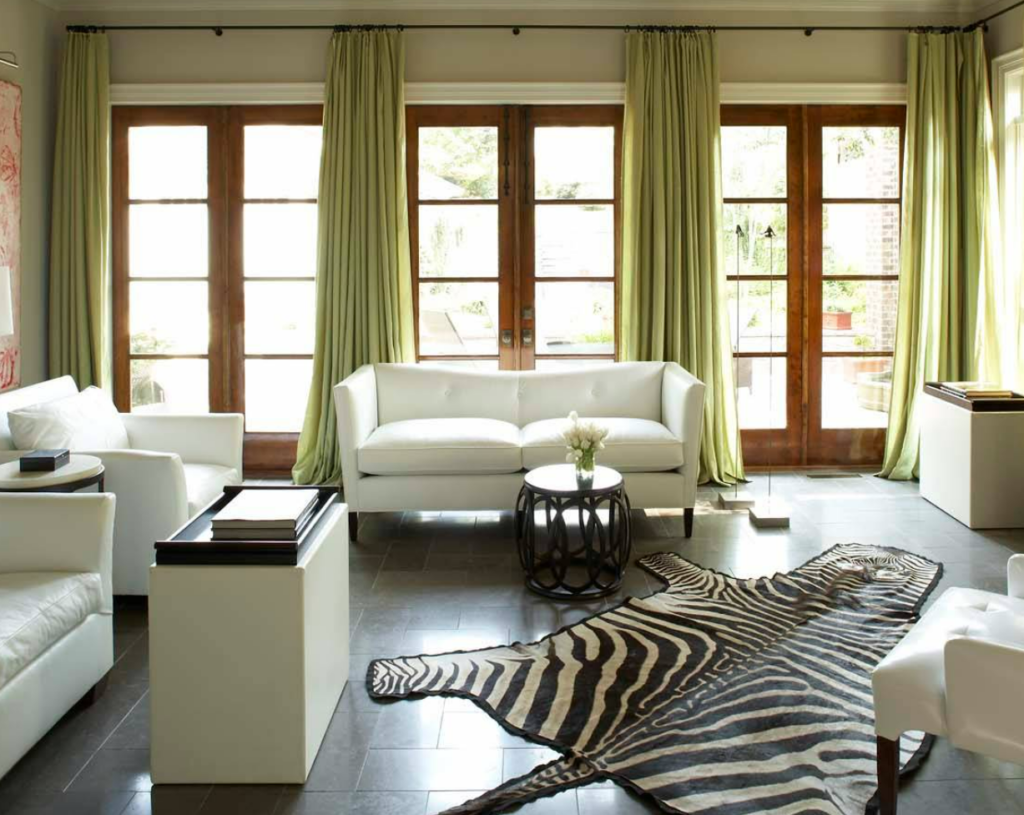
This includes all window treatments that can be folded or gathered to the sides of the doors, to clear off horizontally. Curtains, drapes, vertically-slatted venetian blinds, panel track blinds, and vertical cellular shades are some examples.
ADVANTAGES OF SIDE STACKING TREATMENTS
Since doors operate horizontally, window treatments that clear off horizontally look better aligned and more convenient for use. We list all the wish-worthy features of this option here below:
- Top-stacking shades or blinds get tucked away above head level when fully closed and stop at feet level when fully opened. But, side-stacking treatments are readily accessible all the time. You don’t need to grope for the cord or bend to catch hold of the shade’s handle. Whether you intend to open or close the treatments, their availability at hand’s reach adds to the practical convenience of usage.
- If your window treatments are closed and you need to access the doors, a little maneuvering is enough to allow passage.
- These treatments solve the problem if there is no place on the top for mounting.
- Some clients look towards dressing the sides and softening the trims of the doorway. Arguably, it is only through some of the side-stacking treatments that it can be achieved.
- Most of these treatments will be always visible, even when not in use and stacked on the sides. Hence, you can seize the opportunity and double them up as decorative additions with the right kind of styling.
- If mounted correctly, side-stacking treatments will clear the doors fully when closed. There are also treatments that make very sleek stacks when gathered to the sides.
DISADVANTAGES OF SIDE STACKING TREATMENTS
Now let’s draw your attention to some of the reasons why you may not want side-stacking treatments:
- Since these treatments are well within reach, they can become a sport for kids and pets.
- You might have to commit some wall space and floor space for these treatments, and if the room is small, this can be challenging.
- Some homeowners, especially those who lean on minimalism, may not like that the window treatments are visible when they are not in use.
Top Stacking Treatments
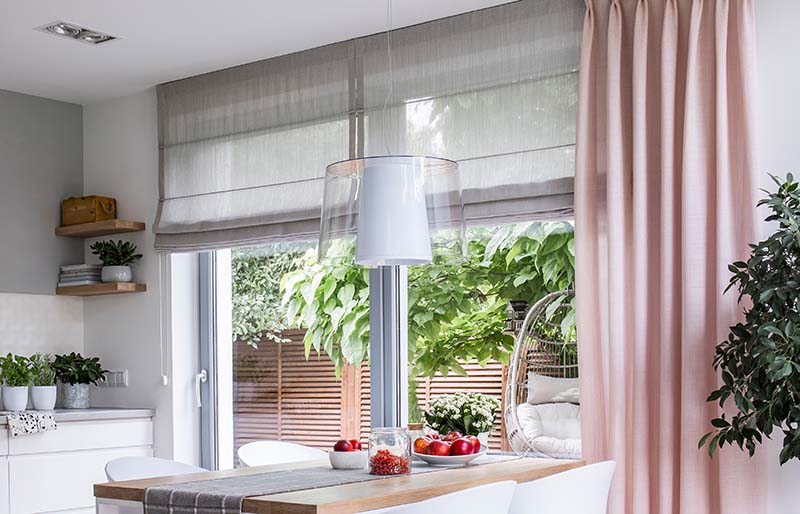
In this category, we have all the window treatments that are mounted and stacked above the window. These include shades and blinds of all kinds, either folding or rolling upward and downward when operated.
ADVANTAGES OF TOP STACKING TREATMENTS
And these are the reasons why some prefer them:
- Top-mounted window treatments clear the wall when drawn upward. And, even when in use, they are usually very sleek and ruffleless. Hence if you are looking to push furniture or huge plants close to the doors, these space-saving treatments can be relieving to have.
- They solve the problem when you ideally want your dressings to completely clear the doors when stacked, and but don’t have any wall space on the sides of the doors for the stacking room.
- If you have kids and pets, you can rest easy that the window treatments will not be accessible to them, except when they are drawn down. Most shades and blinds come with child safety anchors so the cord won’t be accessible for them. For further safety and convenience, you can even motorize them.
- These treatments clear the doors fully when closed if you mount them high enough. Or, you can choose from among treatments that come with a sleek profile.
DISADVANTAGES OF TOP STACKING TREATMENTS
Top-mounting treatments don’t come without any downsides of their own. And if you want to be cautious, here they are:
- The very fact that the treatments open vertically while the doors open horizontally makes for some inconvenience. If you want to pass through doors that swing inwards to open, when the shades/blinds are down, you’ll have to first clear it all the way up before you can pass through. Whereas, with horizontal treatments, you can slide through easily by making a slim gap. If the doors swing outwards or are sliders, the solution to the problem is to keep the shade partially open so you can maneuver and make your way, but then the lower half will be left open which can be bothersome if you’re aiming for light control. Or, go for multiple panels and you can keep one panel open for accessing the doors while all others can remain shut for privacy and light control.
- Top-mounted treatments are only anchored to the wall on the top. Since the scale involved is huge for patio door treatments, they can become clumsy to operate due to the weight and volume. The solution is to select lightweight to medium-weight options, install multiple panels instead of a sweeping one, or motorize them.
- While minimalists might like the idea of window treatments that disappear when not in use, maximalists may feel they add nothing to the aesthetic diversity of the space. This is true of all the top-mounted treatments that get wounded within sleek cassettes, leaving no sign of their existence.
A Word on Door-Mounted Window Treatments
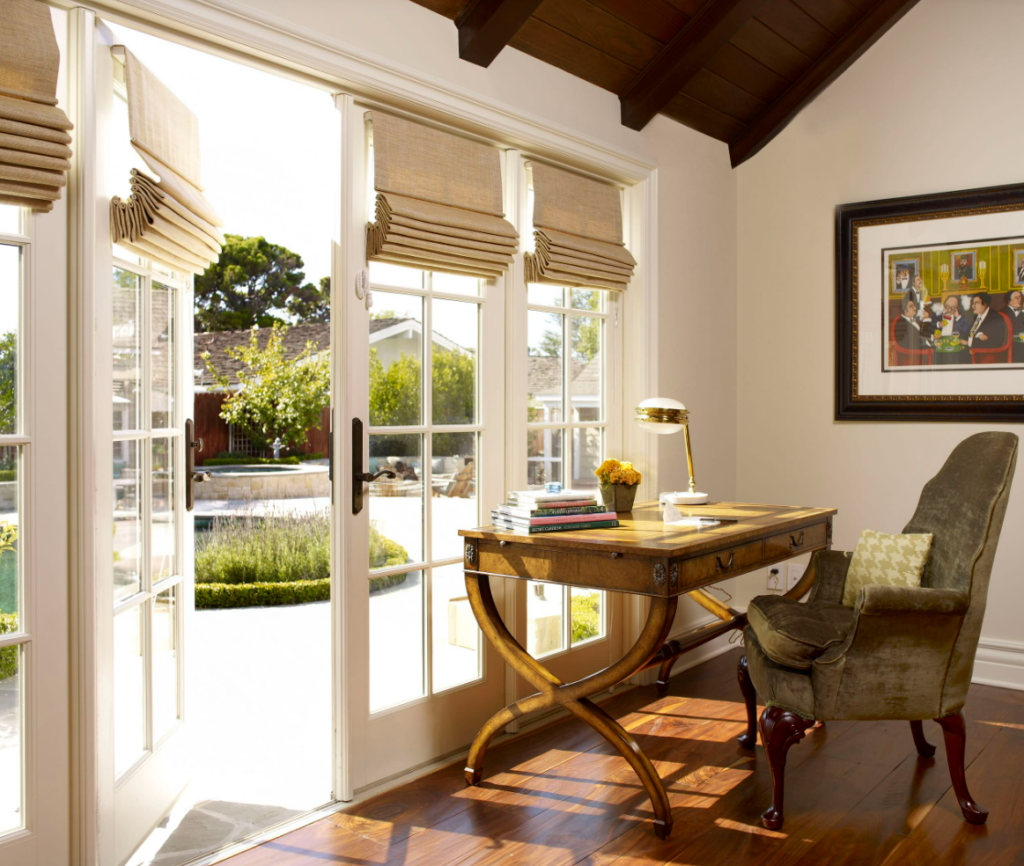
Most of the window treatments in both categories may be mounted on the doors. It works best for settings where there is no room on the sides or top to stack the dressings without hindering the operation of the door. Doors with deeply recessed frames can have the treatments mounted within the recess. For others, as is the case with french doors, they can be mounted on the frames.
Whether the treatments are mounted on the walls or the doors, remember that the pros and cons of top-stacking and side-stacking are still relevant. The most praiseworthy pro specific to door-mounting is that the window treatments do not obstruct accessibility to the doors. And, the downside is that they block some of the view and the light permanently, unless they are ultra-sleek.
Our Top Recommendations for Window Treatments for Patio Doors
After you’ve made up your mind on which type of mounting suits your patio doors the best, you’ll find yourself in a better position to research for the right one within that category of window treatments. Hence, we have grouped our recommendations under two heads for your convenience.
Side-Stacking Window Treatments
The window treatments in this category operate horizontally and stack on the sides. We have shown our degree of preference in the order of their numbering. And, right on top of this list is our all-time favorite dressing – drapes & curtains.
Drapes
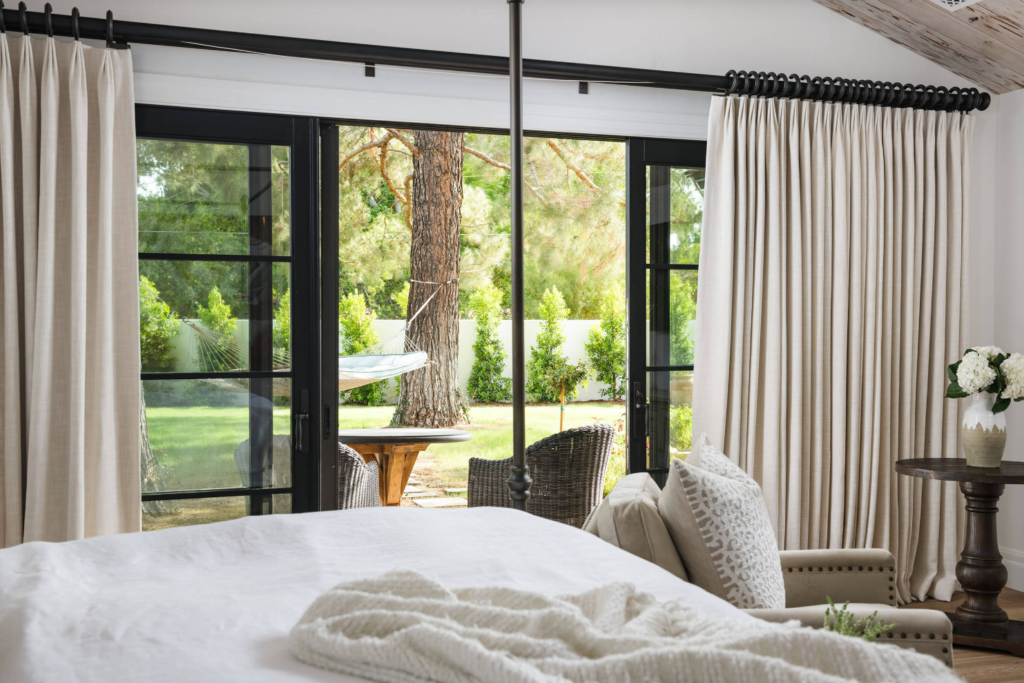
Tried-and-true treatments have worked great for millions of homes down the centuries. But our highest applause goes to curtains and draperies not just because they proved their caliber in history but also because none other marries functionality to elegance this well – especially when it comes to doors. And many more reasons abound –
- MATCHING THE SCALES: When selecting window treatments for any space, matching them to the scale of the space is imperative. Since patio doors are generally oversized, drapes and curtains are almost a default choice as they engage more fabric. And, their luxe rippled contour billowing with the winds rhymes with the organic beauty of the scenic views they frame.
- HUGE STYLING POTENTIAL: Since the base material is fabric, the styling potential is blown to the skies as they can don any weave, pattern, color, or texture that you love to introduce to your patio doors. Added to that, you can style the hardware, trimmings, and accessories to suit your aesthetic goals with precision. No matter what design style you follow, it’s easy to find options that voice them eloquently.
- LIGHT CONTROL OPTIONS: Besides the aesthetic potential, the functional diversity of fabrics lends you the perfect spectrum of choice within a category of window treatment. You can get gauzy viscose, loose-woven linen, lace cotton, heavyweight cotton, linen, and blends, thick-woven plush velvets, and room-darkening blackouts – to meet all types of light control requirements.
- SATISFIES INSULATION REQUIREMENTS: In case your patio is attached to your en suite, you might also be looking for insulative window treatments. And again, drapes beat all other treatments since their voluminous use of fabric makes them the most insulative of all treatments. However, you also need to choose the right type of fabric, heading style, and lining and mount them correctly to achieve the goal.
- EASY OPERABILITY: No matter how heavy your drapery can get to be, the hardware can easily manage the weight whereas some other treatments can be cumbersome to operate when designed in huge dimensions. And, if you expect to operate your drapes ever so often, consider investing in traverse rods or motorized rods. Or, choose a heading style that incorporates rings, clips, or grommets so the drapes may glide easily on the rods/tracks.
- DESIGN STRATEGY FOR HIGH-TRAFFIC ZONE: While draperies are stylish, homely, and highly customizable, you may mind their flowing and billowing trails in high-traffic patio doorways. Size them carefully to stop an inch above the floor, use drapery weights to control the fluttering, and invest in suitable tiebacks so that they stay out of your way.
- SEASH CURTAINS: In case you love the softness of drapes but prefer to avoid their elaborateness, you can go for their minimalistic version. The door-mounted double-rod pocket curtains sit in perfect-fit position over the glazed section of your doors, making them perfect suitors for French doors, half-glass doors, and framed glass doors. The curtains sit taut between two sash rods and can be slid sideward to let light in. Sash curtains suit casual traditional decor styles with country leanings.
Curtains and drapes can be designed to suit any decor style and any type of light control requirements. Easily, their custom look is what gets most people sold on them. And even if you have shades or blinds on your patio currently, you can use curtains as an overtreatment to soften the space. But, if you love curtains for the way they function but want a pleat-less option, consider the next recommendation.
READ MORE: PATIO GLASS DOOR CURTAINS: IDEAS & TIPS
Sliding Panel Tracks
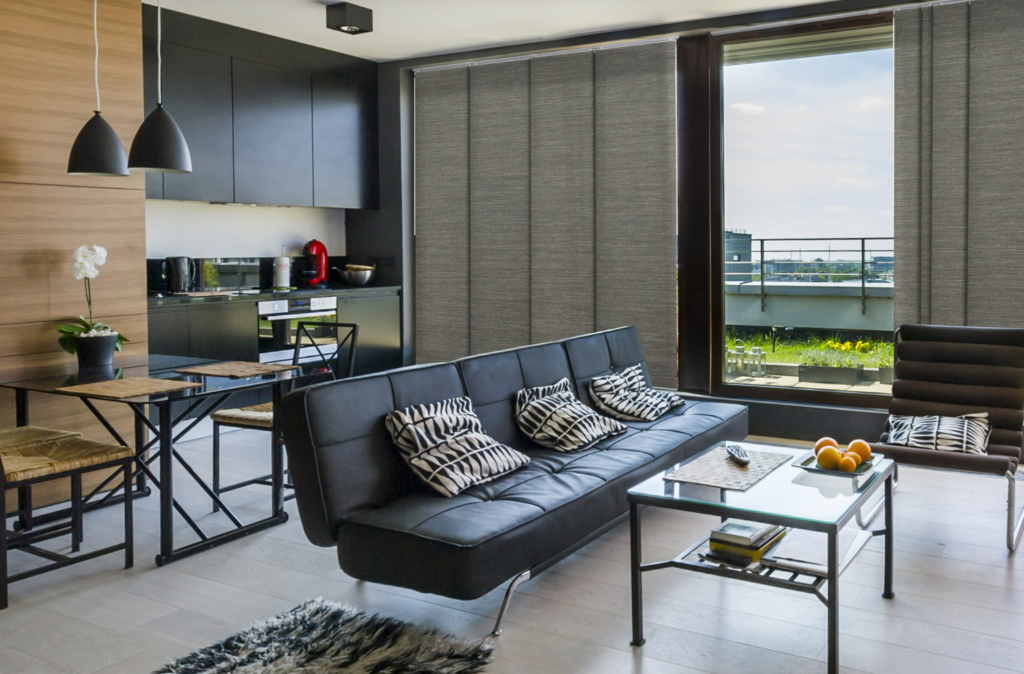
Operating on a track system, multiple panels made of fabric, plastic, or wood slide across the whole span of the doors to cover and uncover the doorway. These panels can be stacked to a side or in the middle when you want to let air and light in. The material can be sheer or non-sheer, and the fabric panels can also be a blackout.
- SUITABILITY OF OPERATION: Since the style of operation is similar to that of the sliding glass doors, this window treatment is considered to be most suited for them. The doors and the panels can be stacked on the same side and so accessibility to the doors is not challenged.
- But as regards swinging doors, you can only access the doors after first sliding the panels away to the appropriate level. If you would use the window treatments rarely, this would not be a major issue, otherwise, it would be bothersome.
- COMPATIBLE DECOR STYLES: The sleek structure of the panels makes them better suitors for contemporary and transitional settings rather than traditional ones. However, it is possible to style them to fit any non-maximalist decor style by working on the details such as the material composition, texture, pattern, and palette.
- ASYMMETRY ISSUE: Unless designed to operate in opposite directions, panel blinds look asymmetrical as they gather towards one side. That imbalance can upturn the aesthetic balance of the whole space, especially if they feature patterns. But if this aspect is factored in when designing the space, the balance can be achieved.
- STACKING ROOM: Sliding panels do not clear the doorway completely. Their stacking room equals the width of a panel – the wider the panel, the more the stacking room. Some clients would mind sacrificing that much of the view, given that the purpose of patio doors is primarily to capitalize on those views. Besides, if your door opens inward, the stacks won’t allow you to operate the doors.
Although functional and elegant, panel track blinds are bothersome for those who mind them encroaching on the doorway. So, you can consider the next option which will not ask for a huge compromise in this aspect.
Vertical Blinds
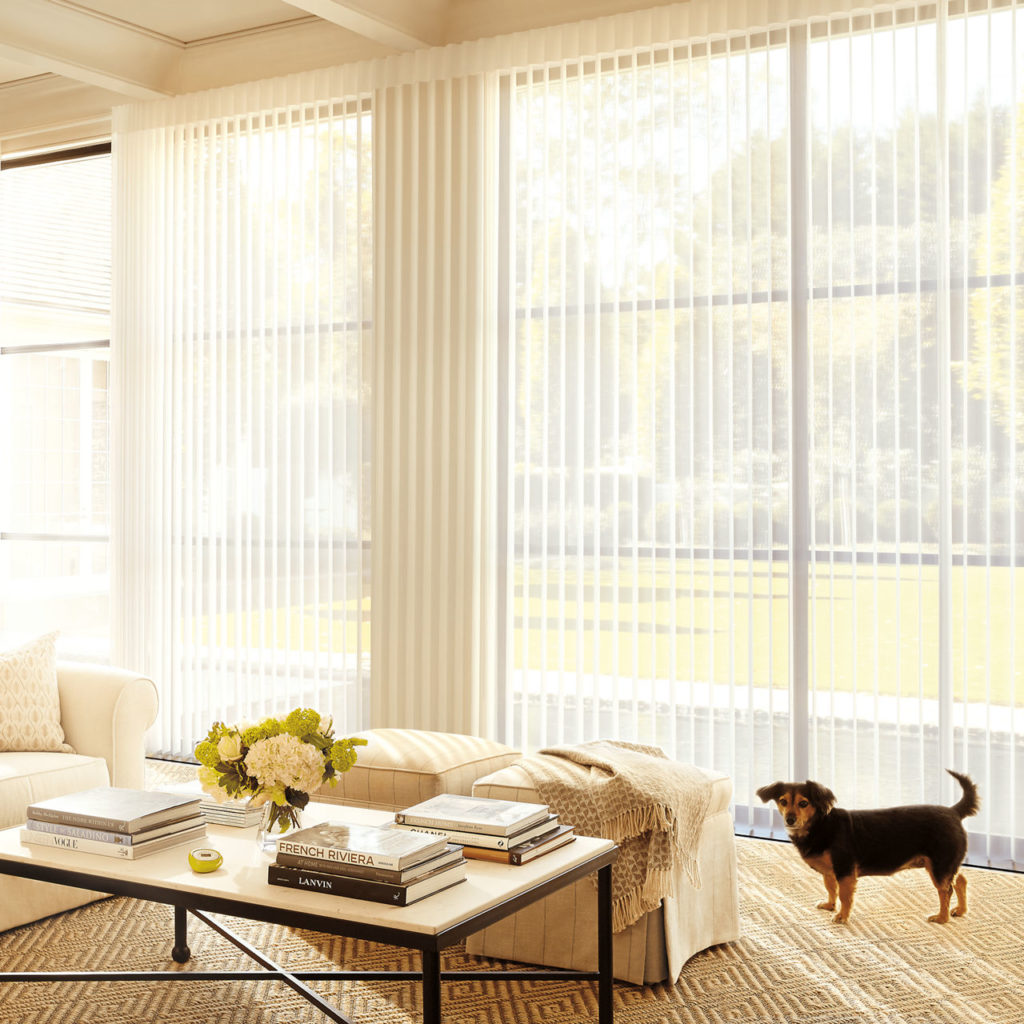
One of the most common patio door treatments, vertical blinds are made up of several vertical slats that are attached to a track at the top of the window. They may be made of vinyl, fabric, wood, or metal. When they are turned flat, each slat overlaps the previous one and covers the entire doorway without a gap.
- SWIVELING SLATS: The highlight feature of this treatment is the swiveling of the slats which facilitates great control over privacy and light control. Depending on the direction of the sunlight, you can rotate the slats to let more or less light in.
- MINIMUM STACKING ROOM: Since the slats are very sleek and they swivel to right angles when they stack, they take very minimal space. Thus, you don’t have to compromise the good views or the light.
- ECONOMICAL: As compared to most other window treatments, vertical blinds are lighter on your pockets. If you’re decorating your home on a budget, these can be your go-to.
- NOT A HEADTURNER FOR SURE: While vertical blinds get the job done, what they don’t provide is the elegance and styling potential that most homeowners look for. In fact, they look very industrial and liken the space to an office room rather than a fun-packed relaxing patio. Mostly available in solid neutrals, these blinds blend into the space but add nothing to its aesthetic diversity.
If louvered treatments have piqued your heart but you want more sturdy alternatives, go for the next.
Plantation Shutters
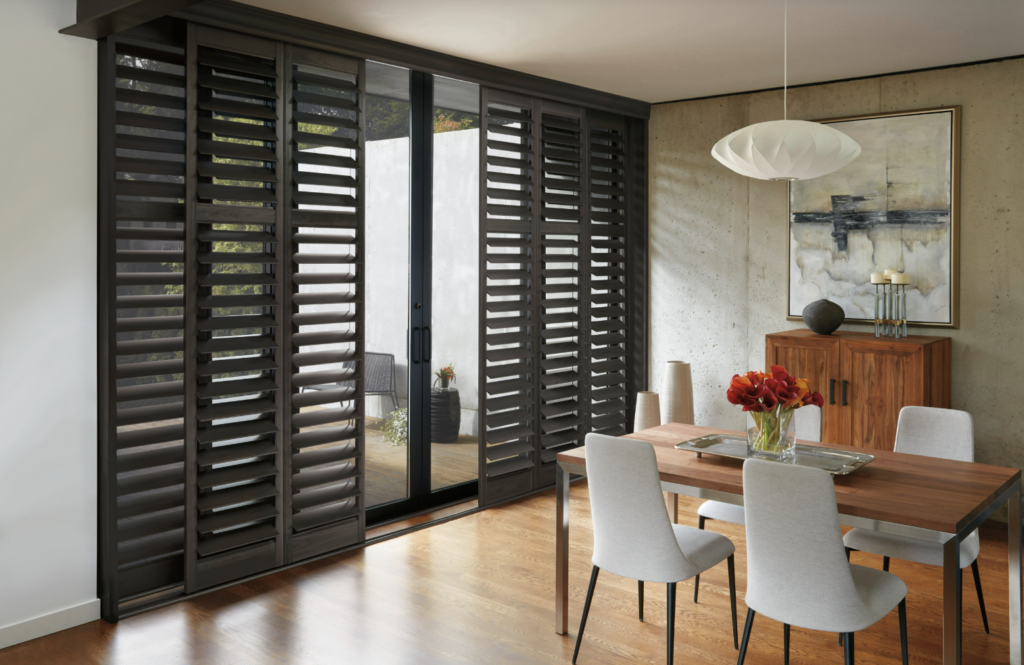
These wooden louvered window treatments affect the facade of the house as much as the interiors. And certainly, that makes them a solution for ‘forever’ homes and not temporary rentals. Either made of wood or faux wood, plantation shutters feature horizontal slats that swivel on their axis. They can be designed as sliding panels or as bifold doors, making them suitable for all kinds of patio doors.
- SWIVELING SLATS: Easily the plus point of all louvered treatments, shutters allow great control over light and privacy. You can adjust the angles of the slats according to the direction of the light.
- HYPES RESALE VALUE: Since shutters are custom treatments that are an addition to the architecture, there’s no better way to design doors and windows to step up the resale value of the house. These are structural renovations with high returns that also add to the aesthetic appeal. To know more about how assets and upgrades can affect your home resale value, read our blog on ‘The Return on Renovation: How Upgrades Impact Home Value‘.
- COMPATABILITY WITH DECOR; Since shutters are an age-old treatment found in traditional homes, coastal cottages, or beach houses, they still carry the same vibe. They may not be the most perfect window treatment for most other design styles.
- COMPROMISED VIEW: While shutters help the building to achieve a uniform look on its exterior, they brutally cut off the light and the views that you so wish to enjoy through your patio doors. You can only let light gush in if you clear the shutters fully off the doors.
- LIMITED STYLING OPYIONS: Beyond customizing the size of the slats and the number of panels, this window treatment will not let your imagination and design skill fly high. With very limited ability to bring in color, they miserably fall short of impressing color-driven design styles.
If you’re looking for a sleek window treatment that is suitable to contemporary styles of architecture and design, our next recommendation might interest you.
Cellular Blinds
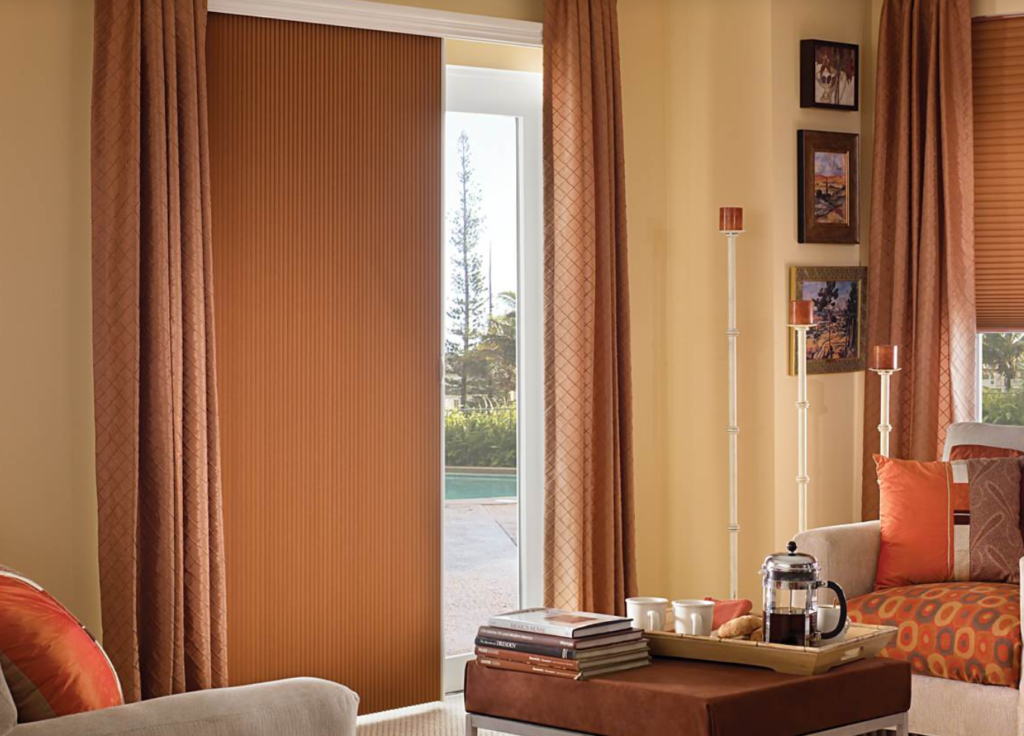
Made of polyester, these blinds are specially designed to meet the needs of homes that need high insulation. Made in double layers that are attached together by a pleated layer in between, these blinds have a series of small pockets which look like honeycomb cells from the sides. That explains their second name – honeycomb shades. These cells trap air, creating a heavily insulated layer between the exterior and interior environment, keeping the space cool during summer and warm during winter. They may be designed with sheer, non-sheer, or blackout fabric to suit the diverse needs of clients.
- TEMPERATURE CONTROL: Since patio doors are oversized and their glass panels leak thermal energy, cellular shades are a wise option to retain the temperature of the room. If your patios are attached to bedrooms and nurseries, this window treatment might help you create a more sleep-friendly ambiance.
- EASY FUNCTIONALITY: The best feature of this window treatment is its functional ease. Cellular shades may be vertical or horizontal, and accordingly, they may be stacked to the top or the sides. Horizontal shades’ highlight is their top-down/bottom-up feature which allows you to open the shades both at the top and the bottom. Vertical cellular shades, on the other hand, are desirable for their ultra-thin stack that almost disappears into the architecture. Both versions are easily accessible and complement the functionality of all types of patio doors very well.
- MINIMALISTIC DESIGN: Cellular shades are very minimally designed and come in solid neutral hues, making their rippled contour bring textural variety to the space as it interprets light with shadows. Other than that, they add little to build up an aesthetically elevated space. Homeowners with maximalist leanings might find them to be too unimaginative for their style.
Top Stacking Recommendations
If you have decided to go for minimalistic treatments for your patio doors, top-stacking treatments will not disappoint you. These treatments may be mounted on the wall above the doors or on the doors themselves. We have three recommendations for you, each unique in its own way and capable of satisfying varied tastes.
Fabric Roman Shades
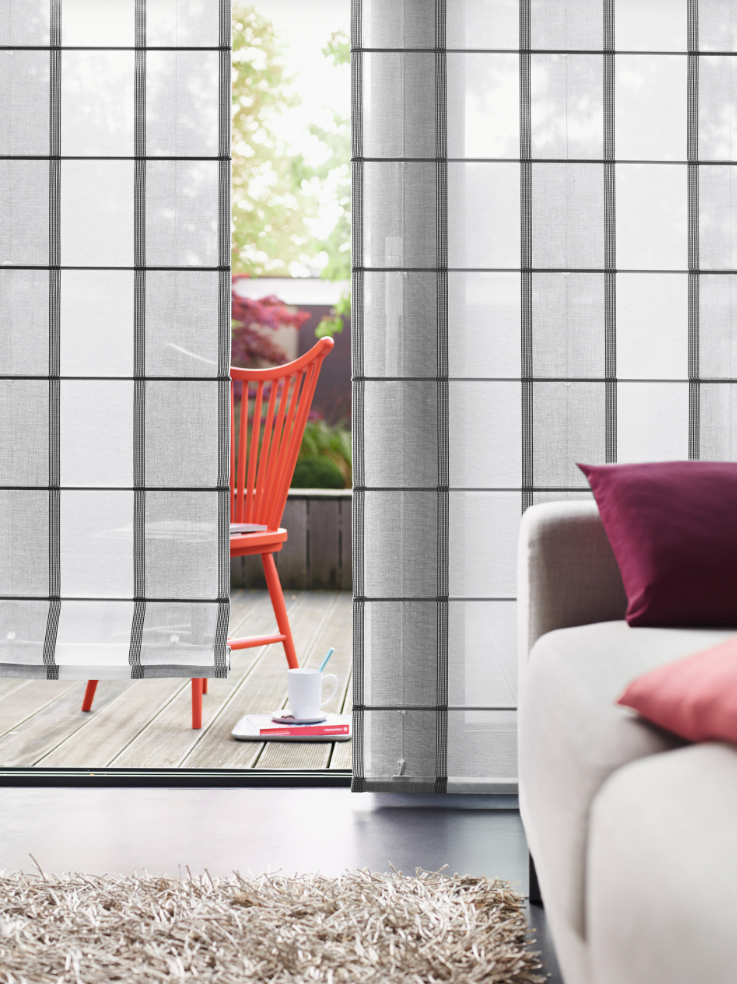
For the love of all things good about fabrics, roman shades are on top of the list. They are single fabric panels that fold in accordion style upward on a cord and loop system. If your patio has multiple doors, installing one shade above each door would be ideal. We love roman shades on patio doors because:
- GOODNESS OF FABRICS: Roman shades are sleek, modern, and yet more luxurious in appeal than most industrial blinds. Like drapes, they bring softness to the space but without being too elaborate or space-consuming. And they are highly customizable given that fabrics can come in all sorts of weaves, textures, colors, and patterns. You can design them as light-filtering, light-blocking, or room-darkening.
- COMPATIBILITY WITH DECOR STYLES: Roman shades can speak any design language because you can work your preferences into the details. While their structure is minimalistic, the fabrics can bring in the vibe you are looking for, be it traditional, country, eclectic, modern, industrial, or even a melange of many styles. This is done by making the right choice of fabric, palette, pattern, style, and accessories.
- ACCESSORIZING TO ADD CHARACTER: Unlike any of the other blinds and shades, roman shades can be beautifully zhuzhed up with suitable trimmings. You can choose from a whole galore of trims such as tassels, fringes, baubles, pompoms, ribbons, gimps, braids, and so on. These dainty details can load the space with a unique personality. Trims that ornament the lead edges quiver with the passing winds, making them a moment of cheer on your patio and syncing with the organic beauty of the outdoors.
- HANDMADE: While shades and blinds are generally produced industrially, roman shades are the result of dexterous craftsmanship and labor. Whether it be the stitching of the shade or the trims that you dot them with, human touch is central to their making which makes them an incredibly beautiful and valuable addition to your patio doors.
- DOUBLES UP AS A VALANCE: This is another feature that makes roman shades our top favorite among shades and blinds. The stylish folds of the shade dress up the top of the patio doors like a valance. So, even when the shades are not being used, they work hard to add style and beauty to define the ambiance. If your patio is an extension of your living room, count on roman shades to be great decor accessories to amp up the space with style.
- FUNCTIONALITY: Roman shades come in three popular styles. The ones which employ slats are ideal as they make crisp and even folds. Whatever type of door you have, you can mount multiple shades on the wall above. Keep one shade above head level in high traffic time periods for easy passage while all others can remain shut for light control and privacy. If the recess for the patio doors is deep, mount the shades on the ceiling of the door frame. This will take a few inches of the top portion of doors as a stacking room but will not hinder passage in any way.
While roman shades are stylish additions to the patio, some may mind that they take up stacking space. If you’re looking for options that disappear from the scene when they are not needed, the next option should meet your needs.
READ MORE: ROMAN SHADES FOR DOORS
Roller Shades
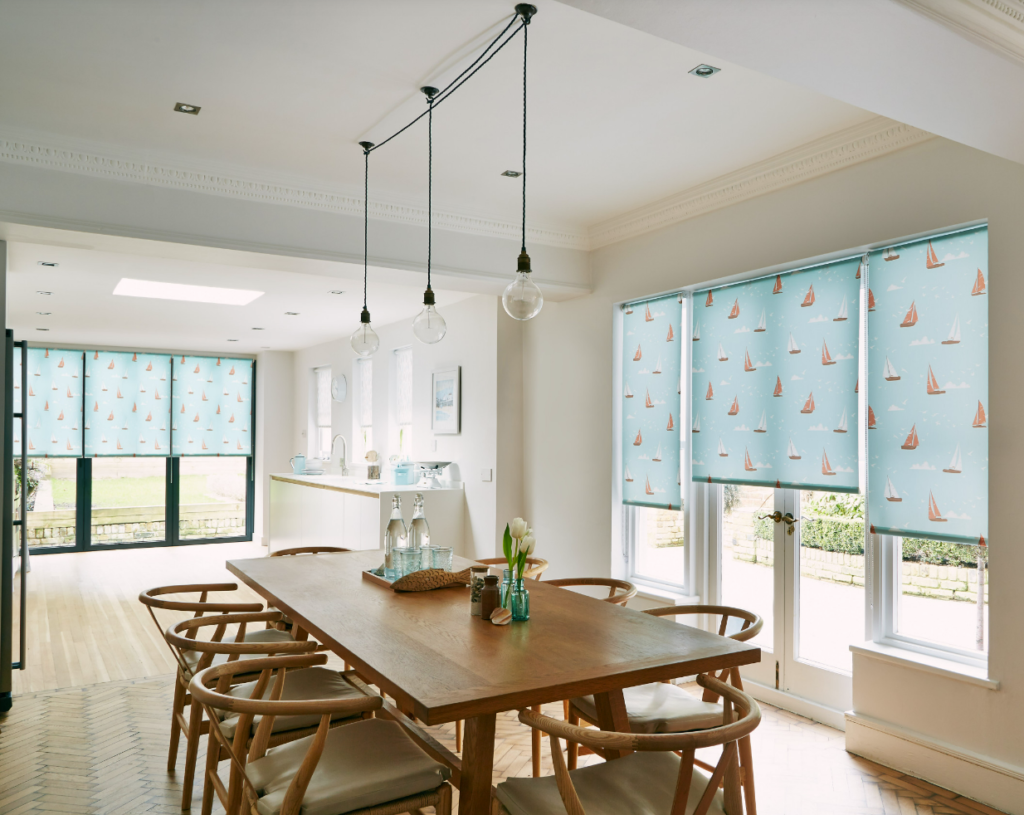
Made of a wide variety of materials from natural fabric and wood to synthetic ones like polyester and vinyl, roller shades are the sleekest window dressings for patio doors. They are single-panel coverings that are wound upon a rod hidden inside a sleek cassette. Operating on a spring or motor mechanism, they roll out like scrolls to cover the doors and roll up to fit into the cassette.
- ZERO STACKING ROOM: The most striking feature of roller shades is their sleek build and svelte cassette which comes in handy for patio doors that lack space on the top and the sides for mounting any window treatment.
- WIDE VARIETY: Roller shades are an umbrella term that refers to the operation technique of the shades. They come in wide varieties such as solar shades, zebra shades, vignette shades, silhouette shades, blackout shades, outdoor shades, and so on. You can always find one that suits your purpose.
- MODERN MINIMALISTIC LOOK: The sleek and function-oriented making of roller shades makes them suitable for modern minimalists. If you want functional accessories that blend into the space rather than stand out and add vibrance, roller shades are perfect, especially when designed in solid neutral hues.
- COMPATIBILITY WITH DECOR STYLES: Despite the wide range of colors and patterns that roller shades come in, the choice spectrum is nowhere close to that of fabric shades. Thus, their ability to sync with specific design styles and color palettes is challenged. Roller shades are largely incompatible with maximalist styles unless you can make up for their minimal silhouette by layering them with other soft and pizzazzy treatments.
While roller shades are smart and sleek and suitable for modern homes, patios may be calling for window treatments with a touch of nature. Hence we bring you our next recommendation.
Woven Wooden Shades
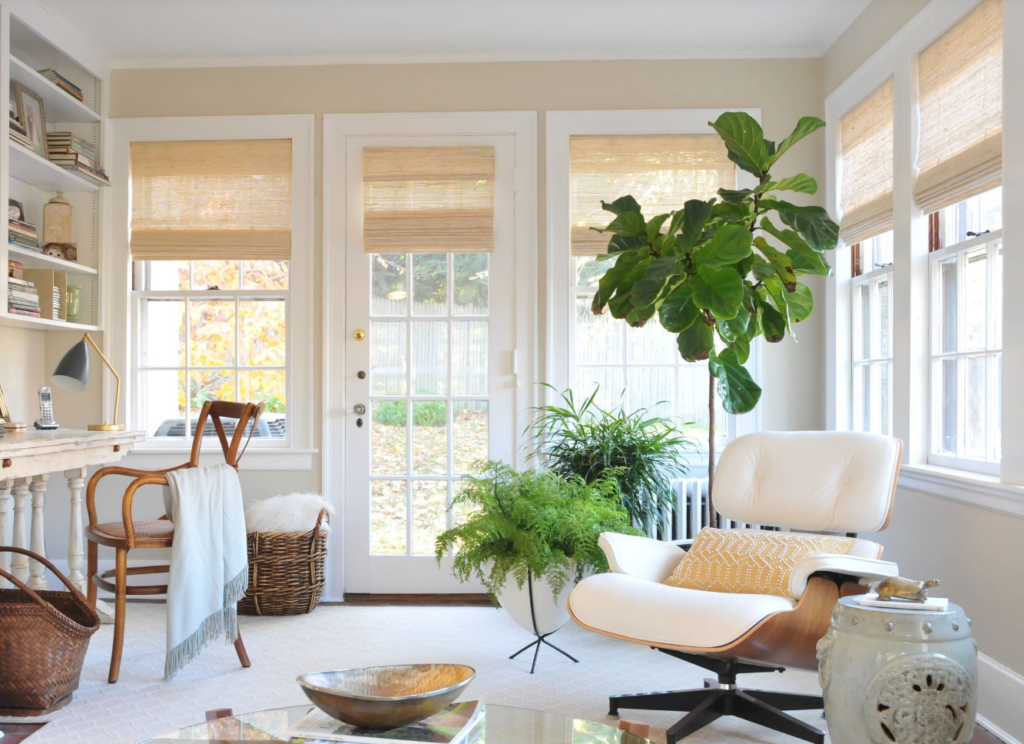
Patios made of wooden pallets or decked with potted plants may be framed fittingly with woven wooden shades that make the mind anticipate what’s beyond the patio doors. Woven wooden shades may be made of wood, faux wood, grass, jute, and the like and operate on rollers like roller shades. You can determine the level of sheerness and some wooden blinds even come with liners to provide more control over light inflow.
- ORGANIC APPEAL: Hands-down, woven wooden shades get all the points for their rustic/organic vintage feel. They pair well with the solid wood furnishings in the space and make a beautiful contrast with light-colored walls. If you are looking for decor accessories that can take your home back to the countryside of olden times without losing the modern touch, look no further.
- COMPATIBILITY WITH DECOR STYLES: Precisely because woven wooden shades suit more traditional rustic decor styles, they are not in line with modern and contemporary styles. So, no matter how much you may love them, if your architecture and design language does not vibe with them, they may be better overlooked.
A Note on Decorative Window Treatments for Patio Doors
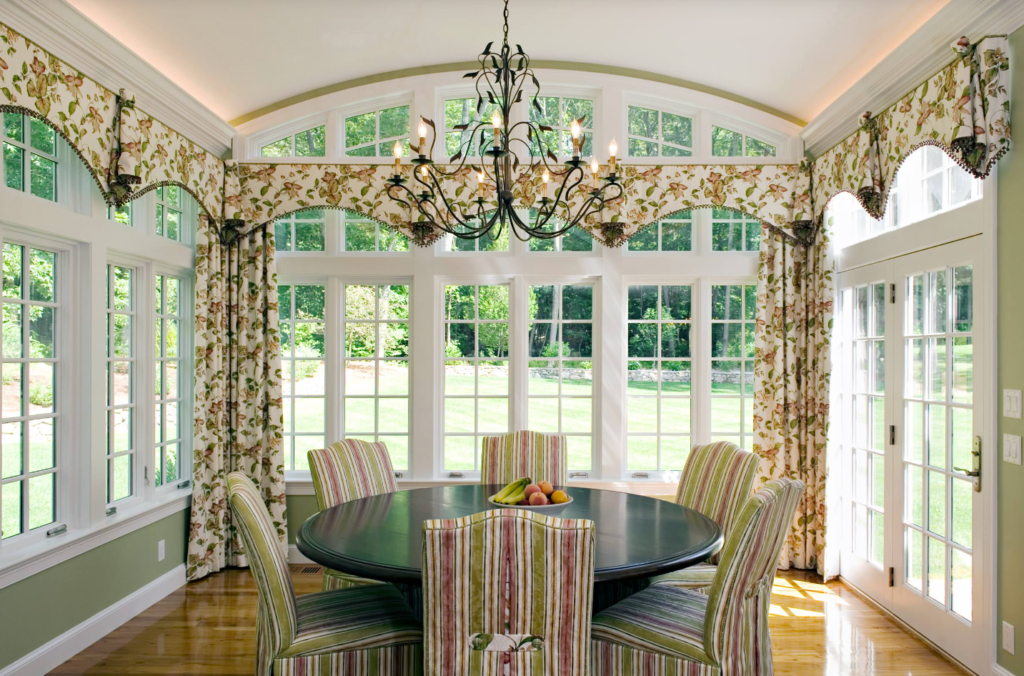
Sometimes, patio entryways are not in need of light control as much as a touch of color and glamour. Perhaps you have just finishing decorating a stylish outdoor space for entertaining in summer and you doubt’ want to close off the view. You may not want to cover your beautiful glazed doors and windows with any dressing and yet hate to leave them bare as they may come across as a forgotten chapter of your interior design. Besides, without a layer of color and pattern, the space may look too boring and unimaginative. Hence, for such patios, we suggest going for decorative window treatments. These work as decor accessories but neither block the views or light nor provide privacy.
You can go for decorative window treatments instead of functional window treatments when:
- You’re convinced of the aesthetic potential of window treatments and are not in need of their functional aspects at all. You’re neither looking for privacy, nor light control but want to coordinate patio treatments with the overall decor of the home. Especially if you have dressed-up windows in the same space, patio doors being left untreated looks like a faux pas rather than an intentional decision. Having decorative treatments made of the same material helps to build cohesiveness into the design
- Decorative treatments are highly recommended for those who cannot afford functional treatments. Later, when the financial constraints have been managed, elaborate functional treatments can be layered in.
- When there are architectural flaws that need to be addressed even though light control or privacy is not an issue, decorative treatments can camouflage them. For example, uneven trims or unpleasant bulkheads ruin the excellent design of the rest of the space.
If these issues are relatable to you, consider the following options:
- VALANCES: These fabric mini curtains dress the top fourth of the doors, softening the top trims with a decorative touch. They can be styled in various ways to suit your specific decor style – with frilly pleats for traditional spaces and flat contours for modern spaces. Valances can also be used as decorative toppings over curtains, drapes, shades, and blinds.
- FAUX ROMAN SHADES: These are miniature fabric roman shades that have their folds secured by stitches. Faux roman shades look like fully functional roman shades but in effect can only hang as stationary decorative fabric panels. Those who like the look of the roman shades but don’t actually need them for functional purposes can explore this option. If your doors open inward, hang the valance high enough to stay out of their way when they are operated.
- DECORATIVE DRAPES: Drapes don’t always have to be overbearing. You can use narrow drapery panels hung on small drapery rods to frame the patio doors. They will soften the side trims, add a dreamy layer of color or pattern, and dress your doors without overdoing the good thing.
- RELAXED ROMAN SHADES: This is a fully functional fabric roman shade that has stylish folds and scalloped bottom. Relaxed roman shades bring a sense of softness and luxury when they crown the patio doors. Their free-flowing swag bottom rhymes with the organic vibe of the exterior space. Additionally, if you ever need to control light or create a privacy guard, you can pull down these shades. Remember that you’ll have to lift the entire shade up before you can operate the doors if they open inward.
SHOP NOW: CUSTOM WINDOW VALANCES & SWAGS FROM SPIFFY SPOOLS
Concluding the Expedition
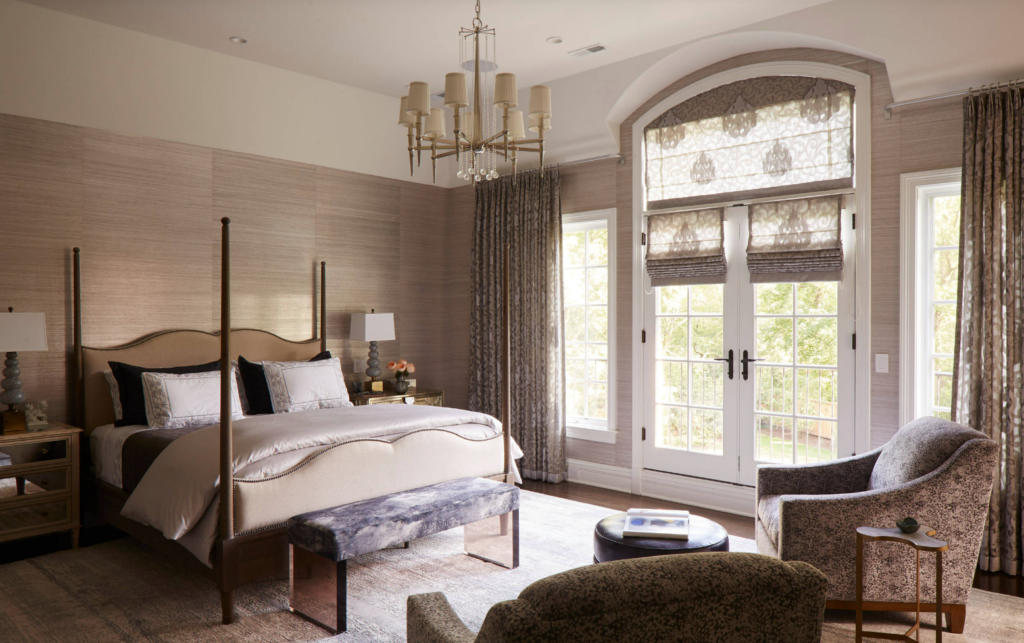
At the end of the long journey, we hope you have found a comprehensive guide for selecting the right window treatment for your patio doors. With so many alternatives at hand, the decision-making task can get very overwhelming, but with expert advice guarding your steps, you are sure to reach your destination. If your heart is set on any of the fabric treatments, count on Spiffy Spools to convert the window dressing of your dreams into a reality. And, if you have any queries, find us just a call away.
READ MORE: WINDOW TREATMENTS FOR FRENCH DOORS: IDEAS, PHOTOS & TIPS






















































































































